While planes were crashing and bridges flown away by the floods in Pakistan, all there was in Gilgit was a three day power cut due to a landslide taking some poles with it. People do not really associate themselves with Pakistan here in the North, so life went on.
With no power there was not much to do, so we decided to get acquainted with local life at the market. Here are some pics and vids of the goings on.
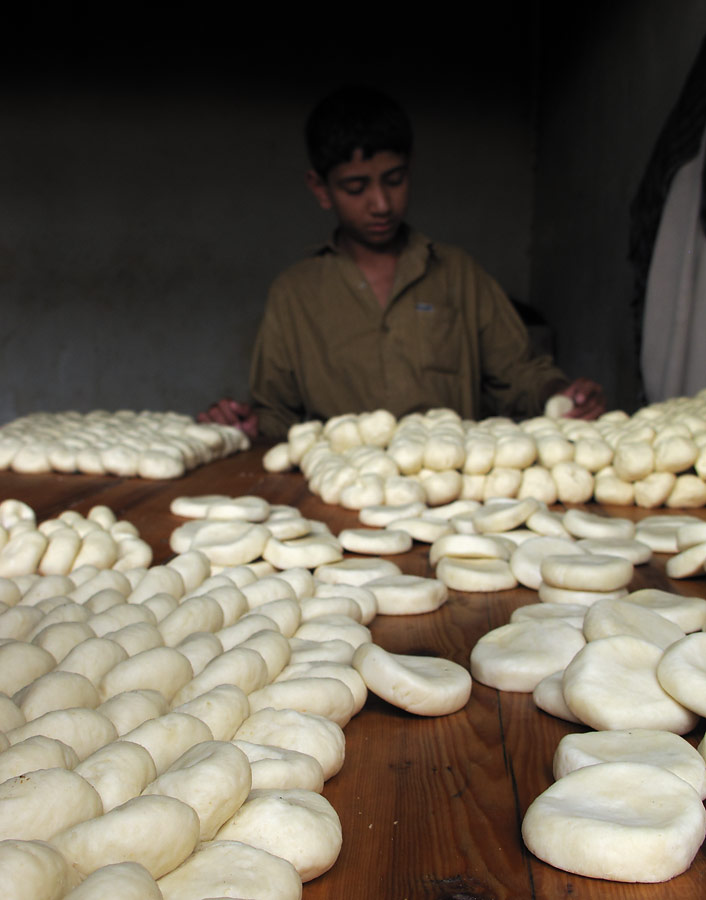
Boy working at bakery.
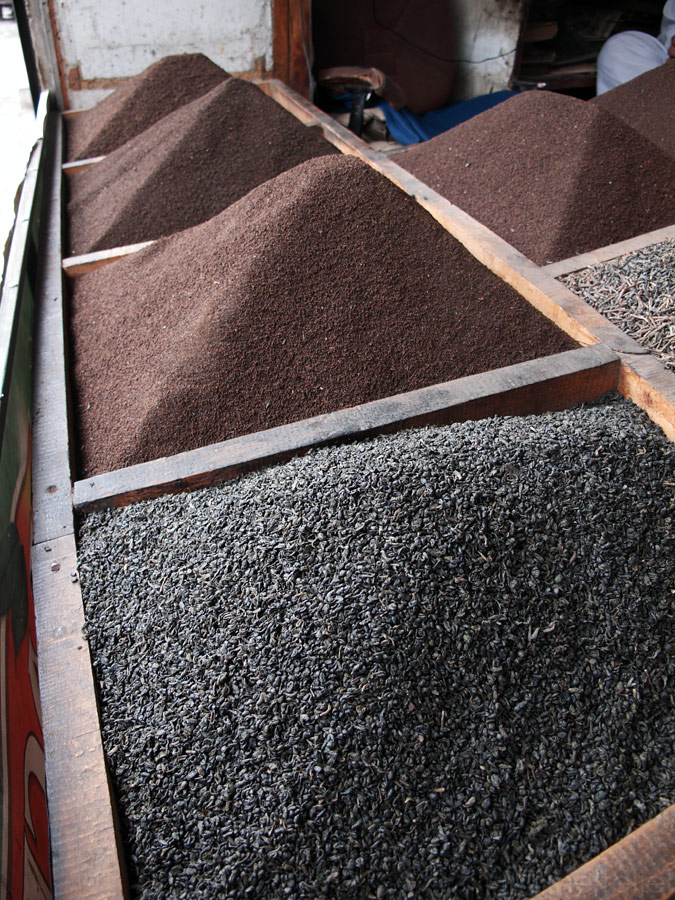
Selling tea at the bazaar
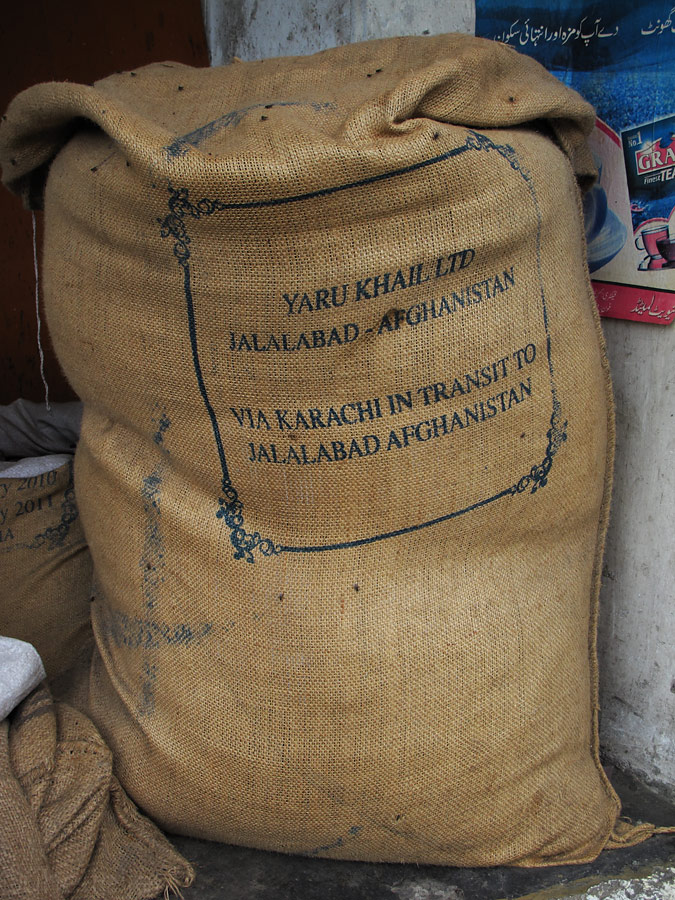
Trading routes through the near neighbour - Afghanistan.
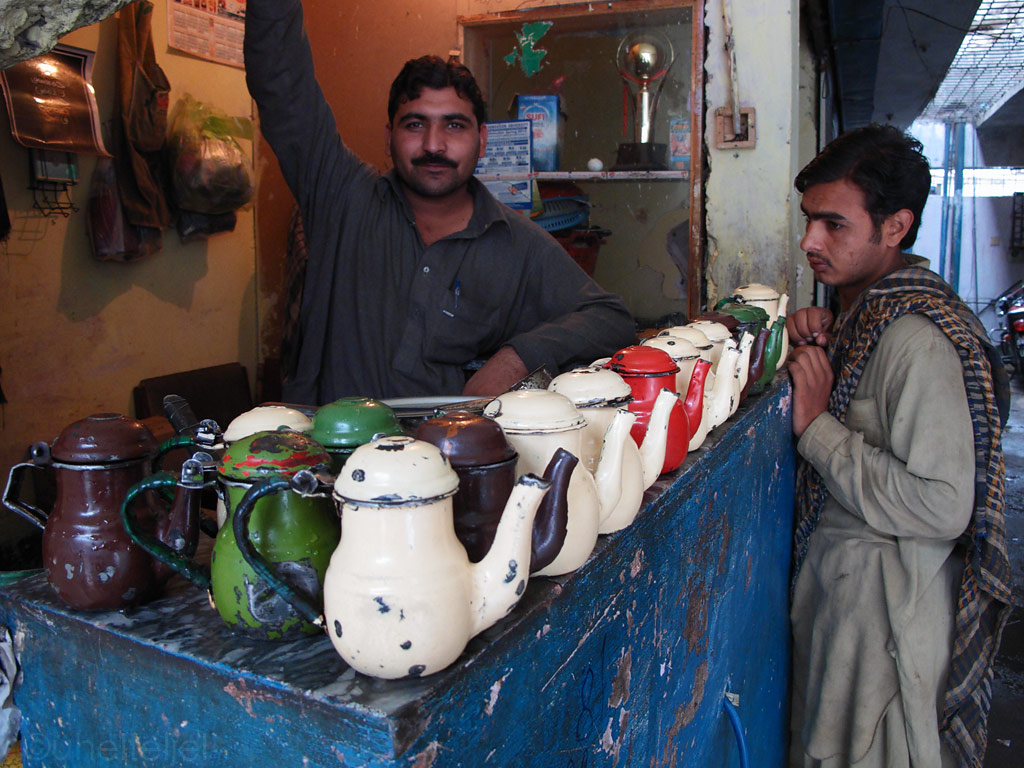
Want a cuppa?
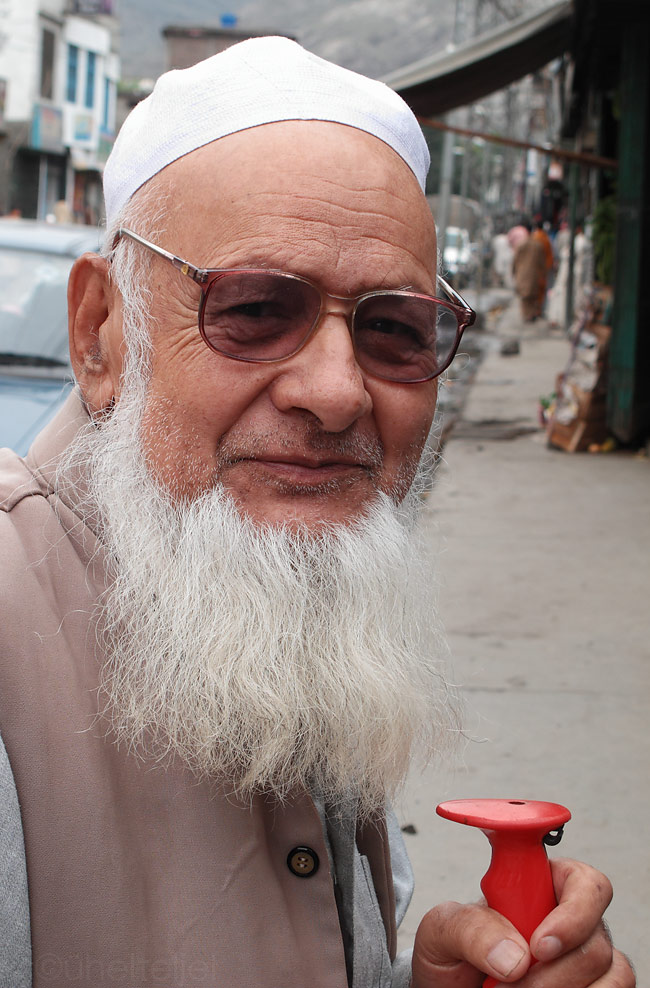
Merchants and customers
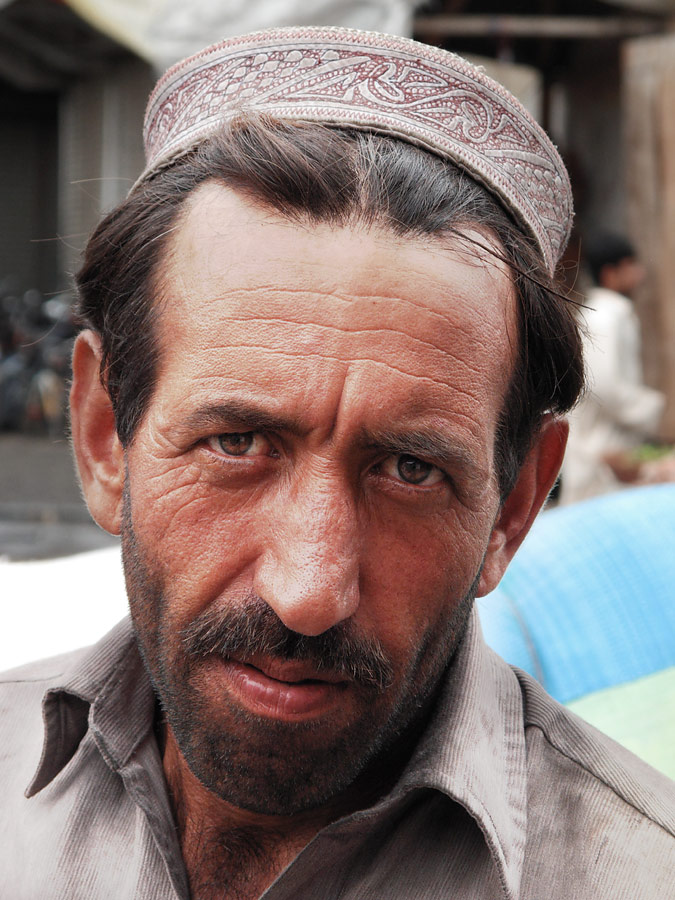
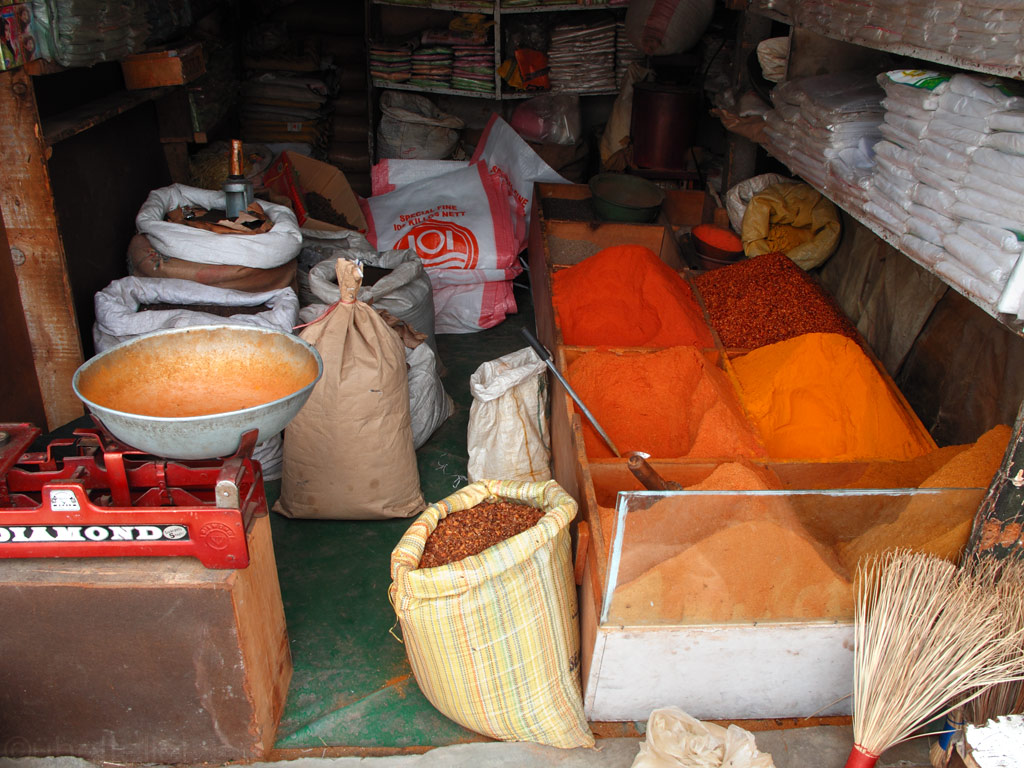
Spice shop
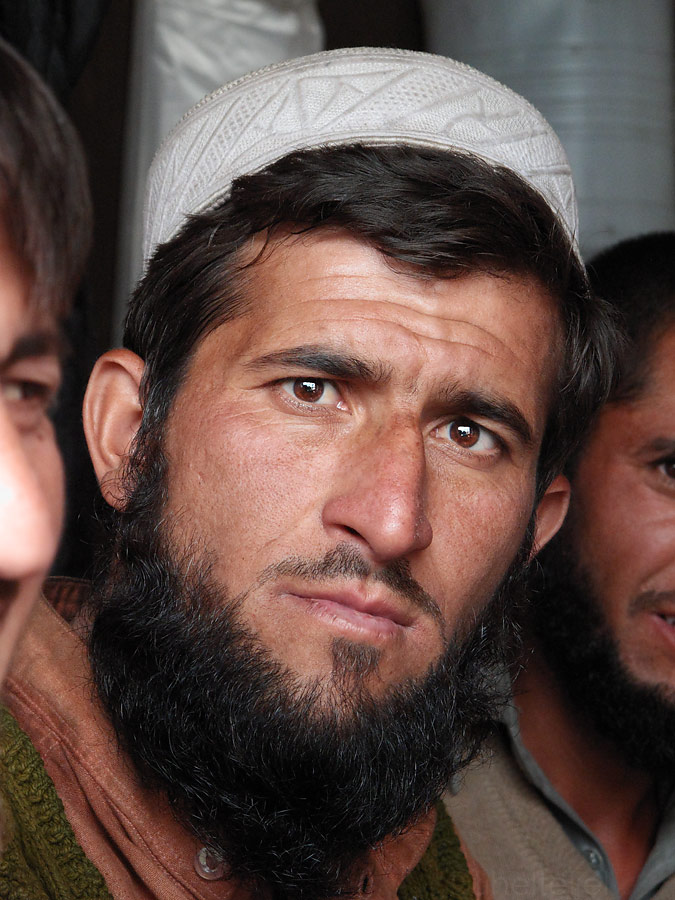
Gilgit muslims...
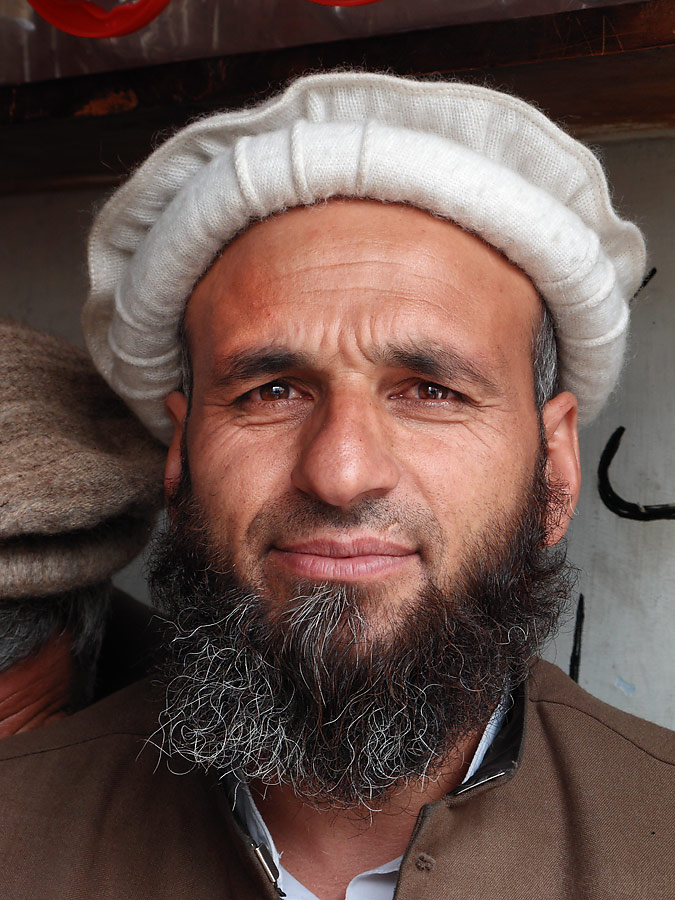
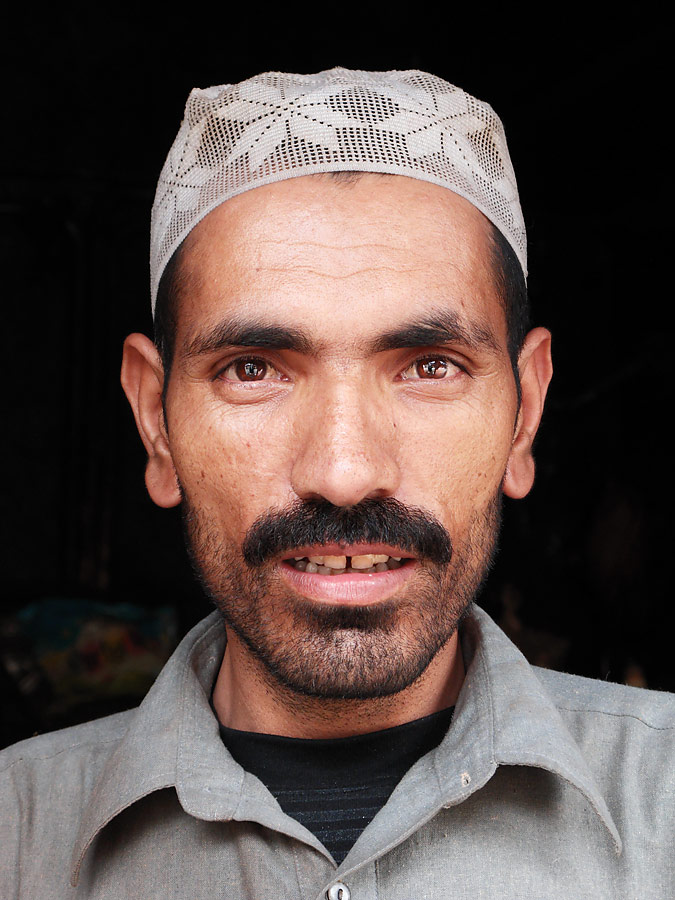
<object width="640" height="505"><param name="movie" value="http://www.youtube.com/v/vX1rUiW0yjs&hl=en_US&fs=1"></param><param name="allowFullScreen" value="true"></param><param name="allowscriptaccess" value="always"></param><embed src="http://www.youtube.com/v/vX1rUiW0yjs&hl=en_US&fs=1" type="application/x-shockwave-flash" allowscriptaccess="always" allowfullscreen="true" width="640" height="505"></embed></object>
Selling live chicken by the weight. Where is the GreenPeace?
<object width="640" height="505"><param name="movie" value="http://www.youtube.com/v/uCq2HIxpVAI&hl=en_US&fs=1"></param><param name="allowFullScreen" value="true"></param><param name="allowscriptaccess" value="always"></param><embed src="http://www.youtube.com/v/uCq2HIxpVAI&hl=en_US&fs=1" type="application/x-shockwave-flash" allowscriptaccess="always" allowfullscreen="true" width="640" height="505"></embed></object>
Tasty naan bread in the making. Check out the tandoori oven!
Our Iran visa applications still pending (three weeks already!), we decided to spend some time in the area known as Baltistan. On our road there we were accompanied by the mighty Indus, changing its face from fast and furious to slow and serene.
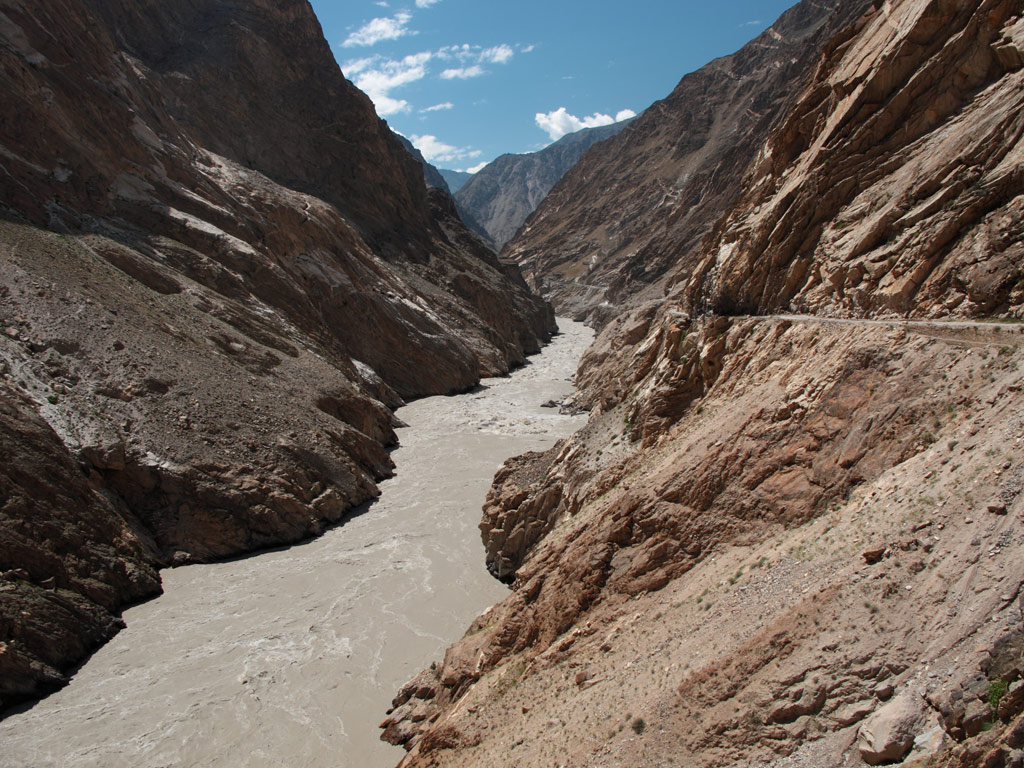
Road to Skardu is mostly cut into rock, the raging Indus river below - hard to believe the same river right now is causing devastating floods in the South of Pakistan.
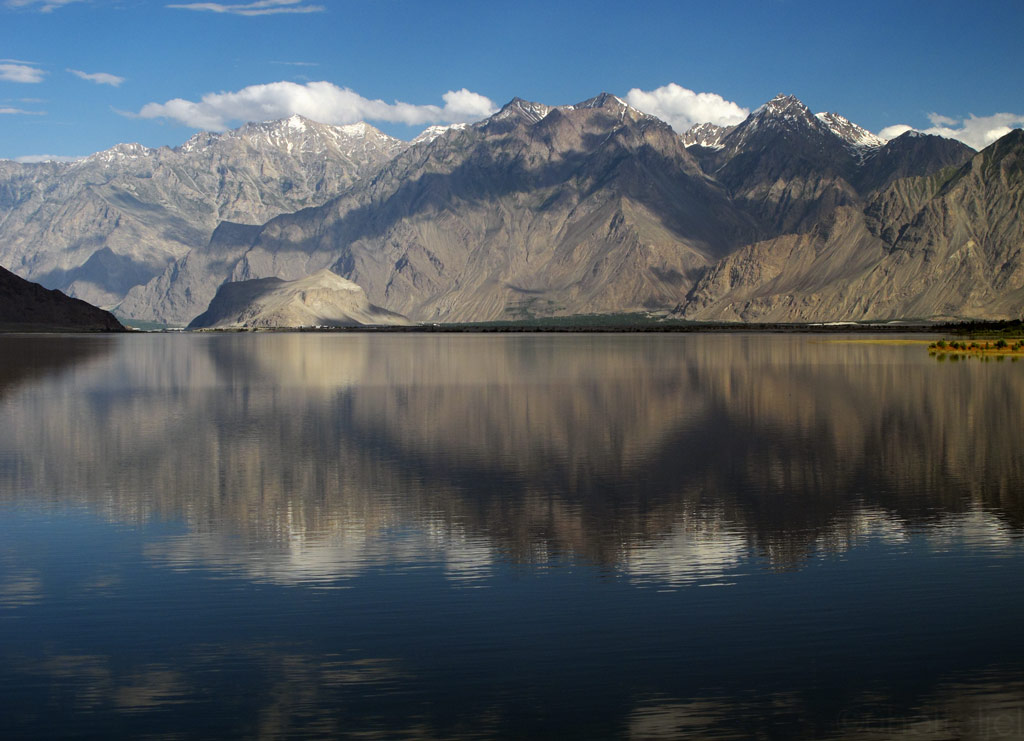
Indus goes into wide and "silent" mood near Skardu.
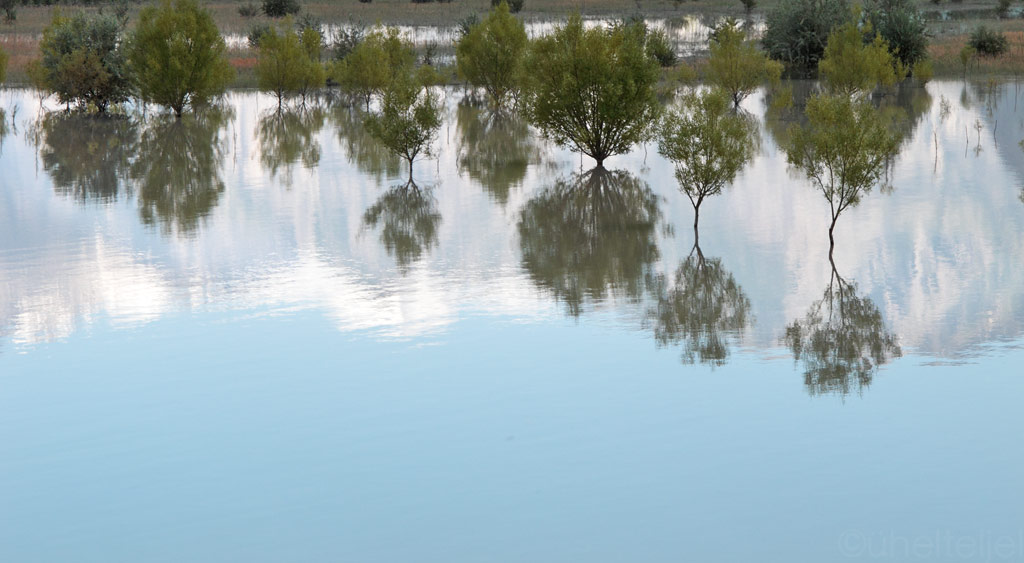
Reflections.
The main reason for going to Baltistan was to get a glimpse of K2, the second highest mountain in the world. One might think that it is an awkward name for one of the highest points on our planet, but the thing is that it is so remote (not even visible from any village) that until recently it did not have a name at all. It was in 1856 that Thomas Montgomerie undertook a survey and charted the highest peaks of the Karakoram range. The nearest neighbours of K2 were marked down as K1, K3, K4 and K5, but were later renamed Masherbrum, Broad Peak, Gasherbrum I and Gasherbrum II respectively, using their native names as a basis.
Located right on the border of China and Pakistan, the densest area of high peaks and glaciers in the World, this 8611 metre (28 251 ft) mountain is difficult to access (and even more difficult to ascend - till now only 302 people have made it to the top, compared to more than four thousand that have summited Mt Everest). Even to get a distant view of it, one has to abandon the wheels and do some trekking.
To get to the right point we first rode as far east as we possibly could. Since Baltistan is basically a disputed territory (administered by Pakistan, claimed by India), there is quite a lot of military presence, and foreigners are not allowed anywhere near the so-called Line of Control. It is interesting to note that at some point we were as close to Kargil (where we passed some two months earlier) as some 60 kilometers (40 miles), so one could say we had not progressed too much on our route. In the very eastern part of the disputed territory lies the Siachen glacier, the very big thing clouding the relations between the two countries - Siachen is the highest battleground on Earth at 6000 meters. Soldiers fight in thick snow, extremely low oxygen environment, at 100 mph winds (bullets fly in unpredictable directions) and -50C (-60F) nights, fighting with avalanches and cervasses. Obviously the murderous extreme conditions has taken a lot more lives than the bullets from the enemy's guns.
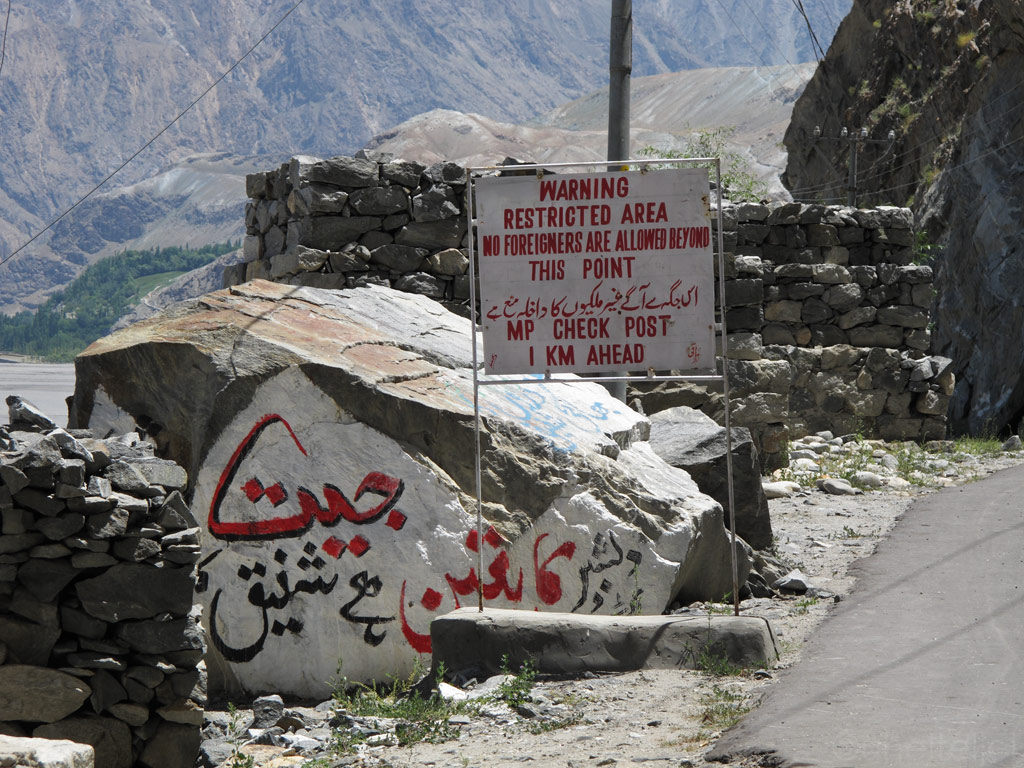
(Military) road to Siachen area is strictly off limits to foreigners.
From there we turned north into Hushe valley, towards a village with the same name. This is where the road ends, if one can call it a road. This jeep track has it all - sand, water, mud, loose rocks, swinging bridges and irrigation ditches dug right across. It isn't long, but it definitely is torturous.
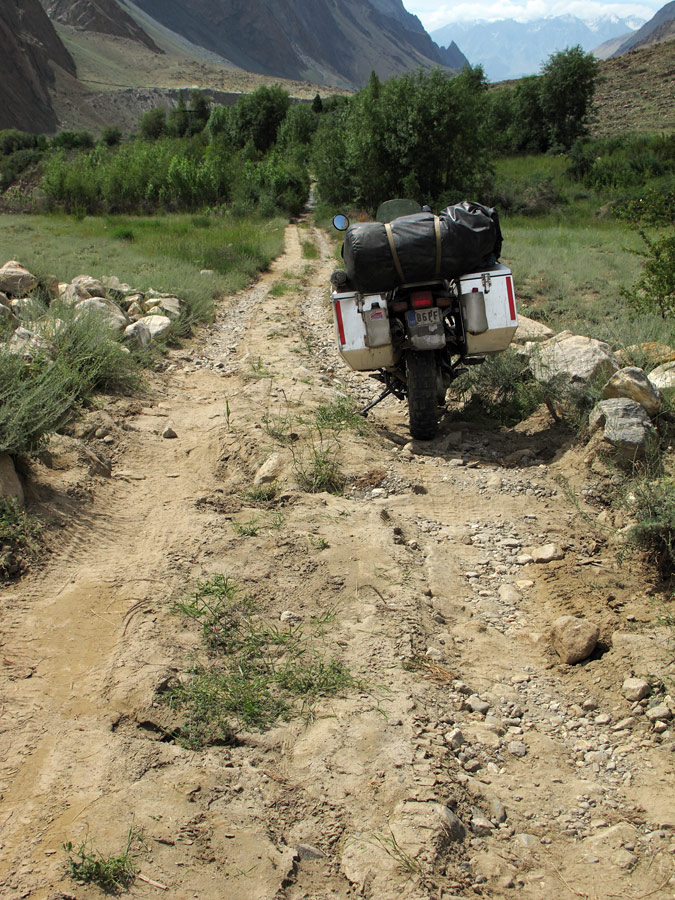
This is a good part of Hushe track.
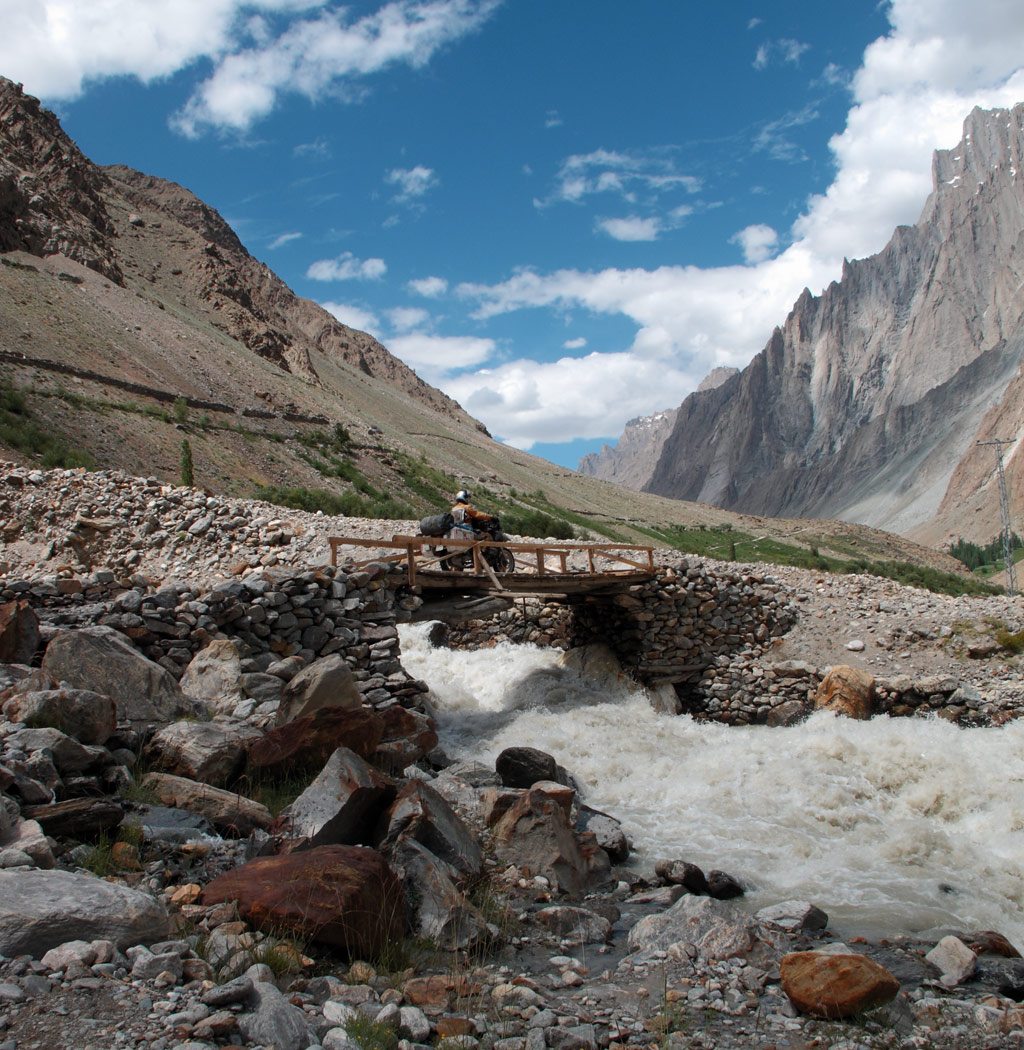
Bridges are mostly made out of wood and are quite unstable and questionable.
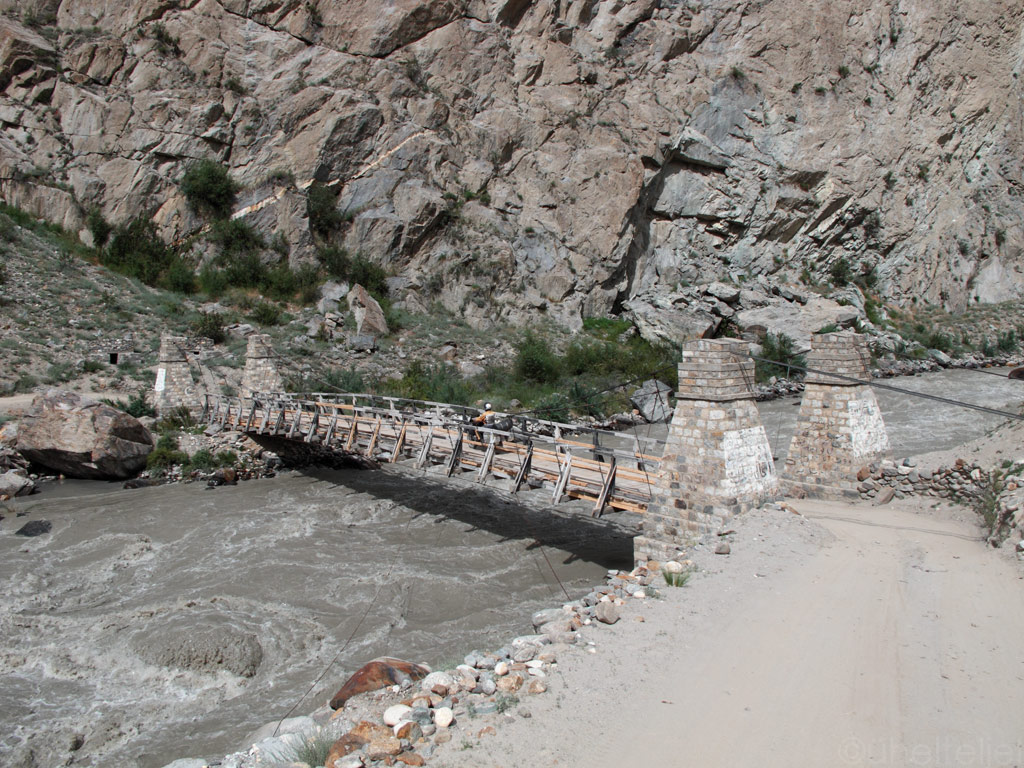
This is the best bridge on the Hushe track.
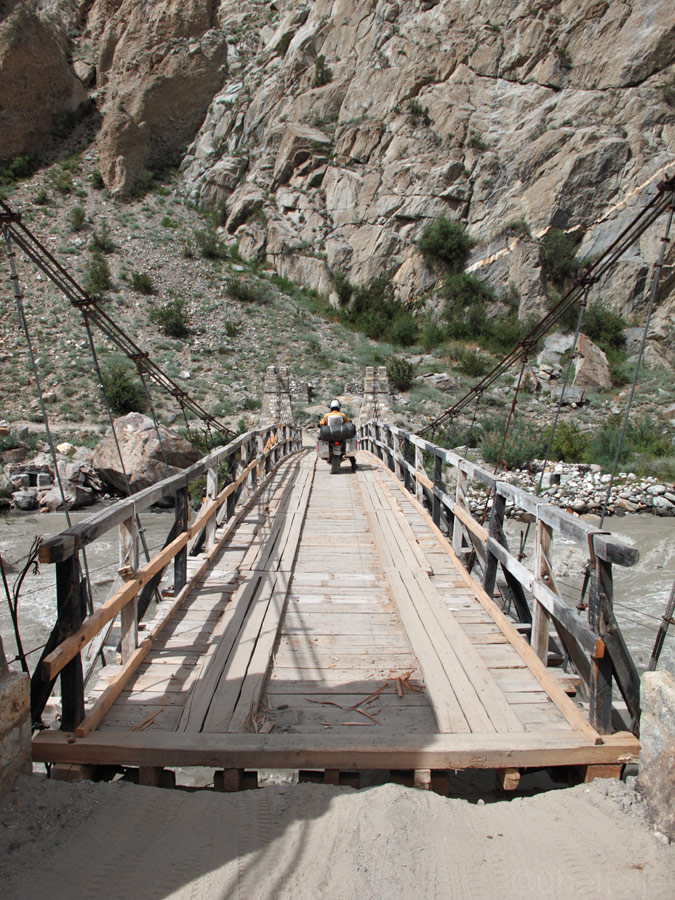
Hushe village is in fact some 700 years old, although the timeless design of the houses there does not give many clues as to how old they might be. Mostly consisting of dry stone walls, they really do make you wonder how they manage to stand and not collapse. Wealthier families live in plastered houses.
The main sources of income for the 140 families living in Hushe are growing crops, livestock and tourism. Women take care of the fields and animals while men offer their services to mountain expeditions as guides, cooks and porters - here, it's one of the best access spots to the high Karakoram. Because of the political situation and US involvement in Pakistan, the last years have been very low in tourist numbers, so we mostly saw men chatting and sipping chai on the street, leaving a somewhat neglected feeling - they say this year only 30 expeditions have visited, yet last year the number was well over 90 teams that went to conquer the extreme high peaks in Karakoram. The setting of the village is, however, fabulous, with 7821 metre (25 659 ft) Masherbrum looming over the valley.
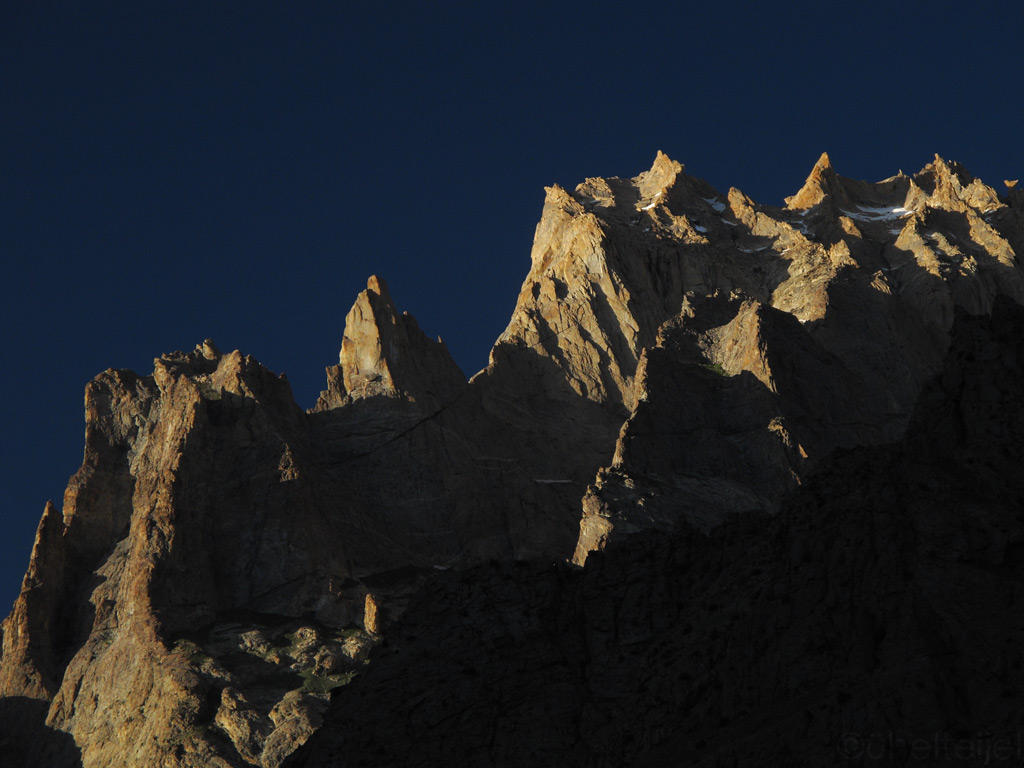
Views from Hushe...
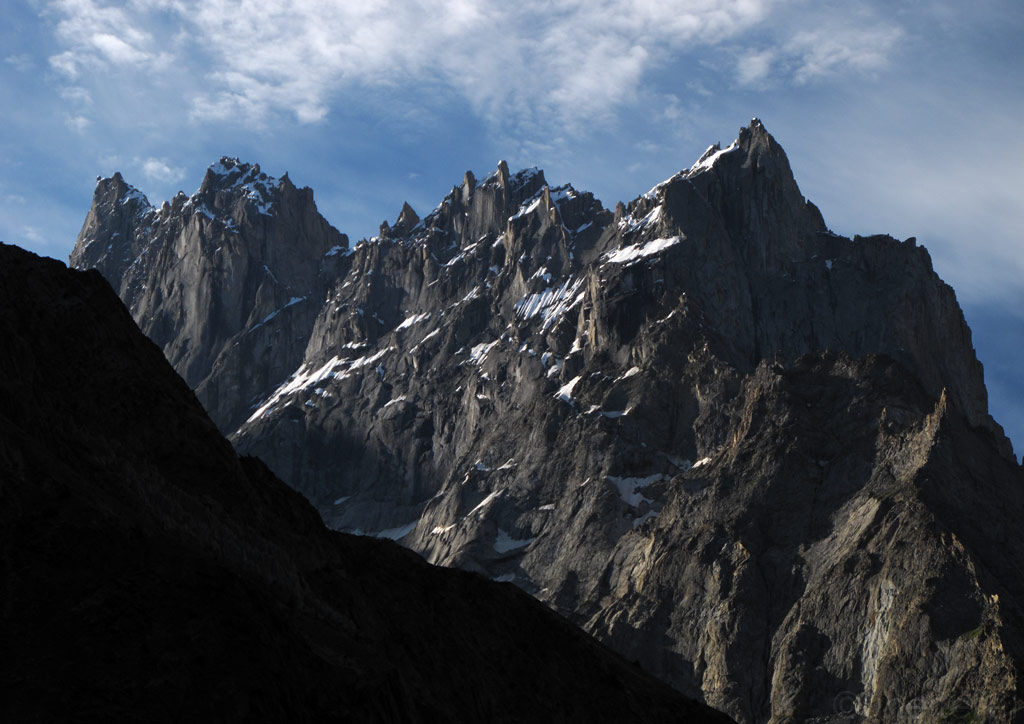
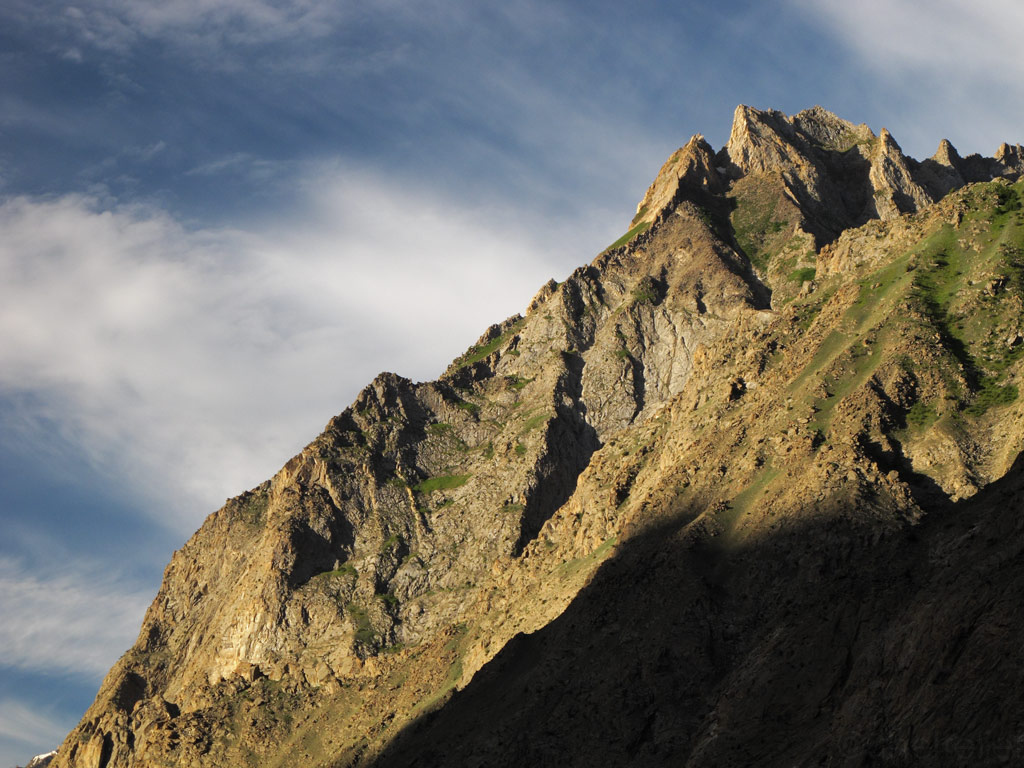

Panorama of Masherbrum (click to enlarge)
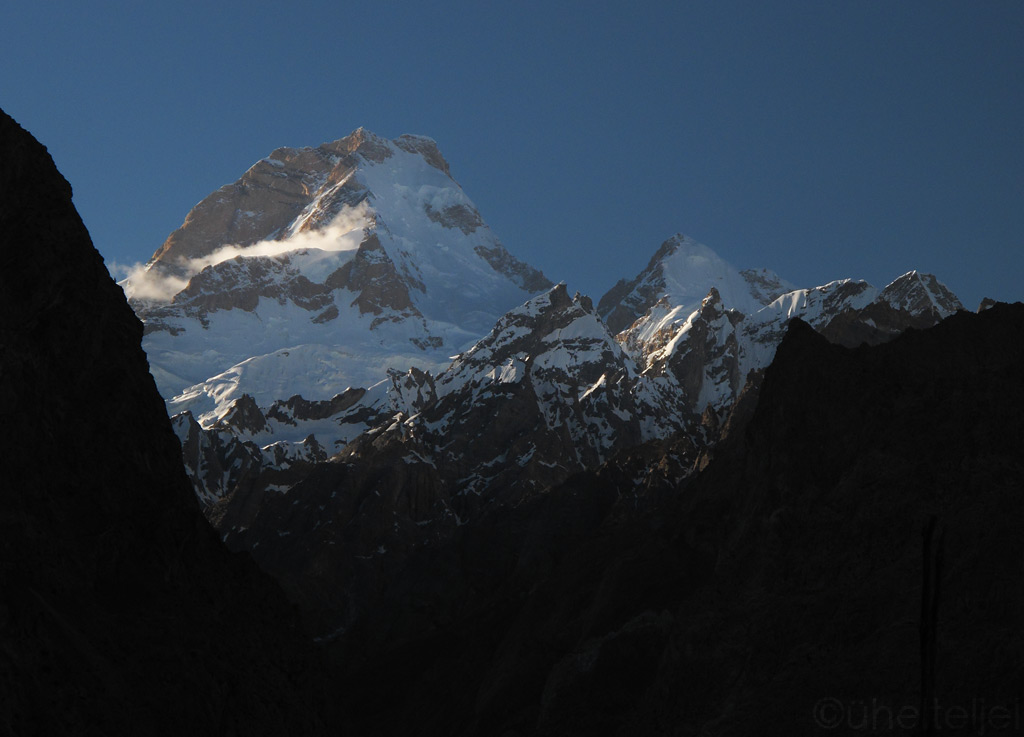
7821 metre (25 659 ft) Masherbrum glows over Hushe
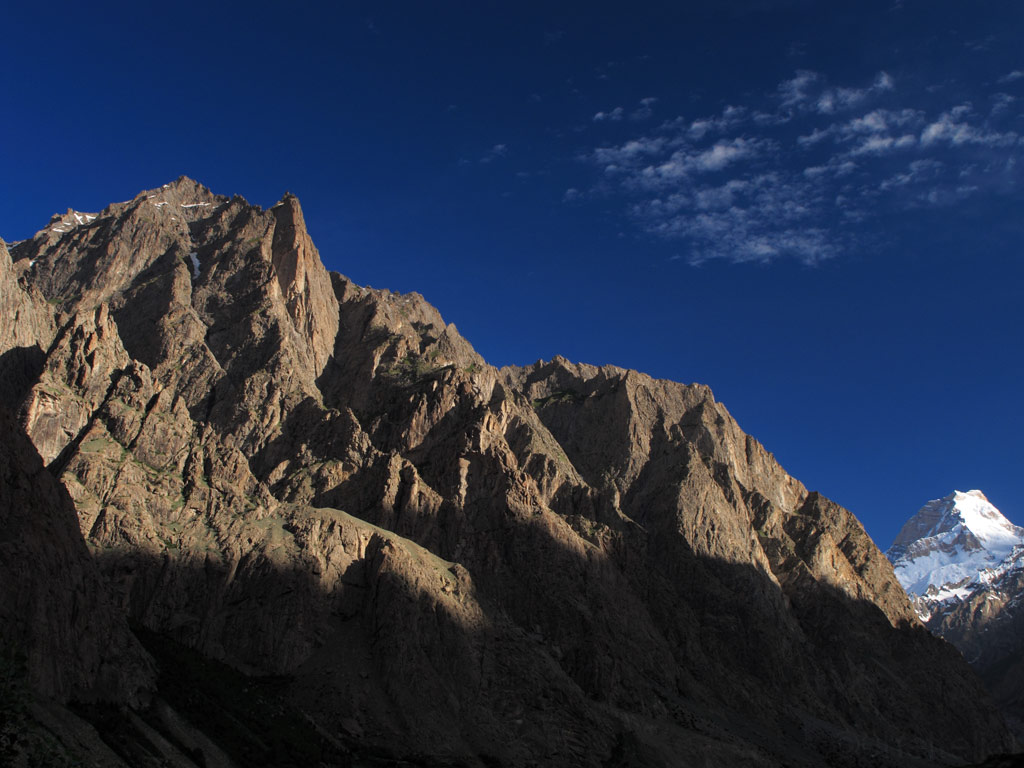
And cliffs that are hard to scale from the pictures...
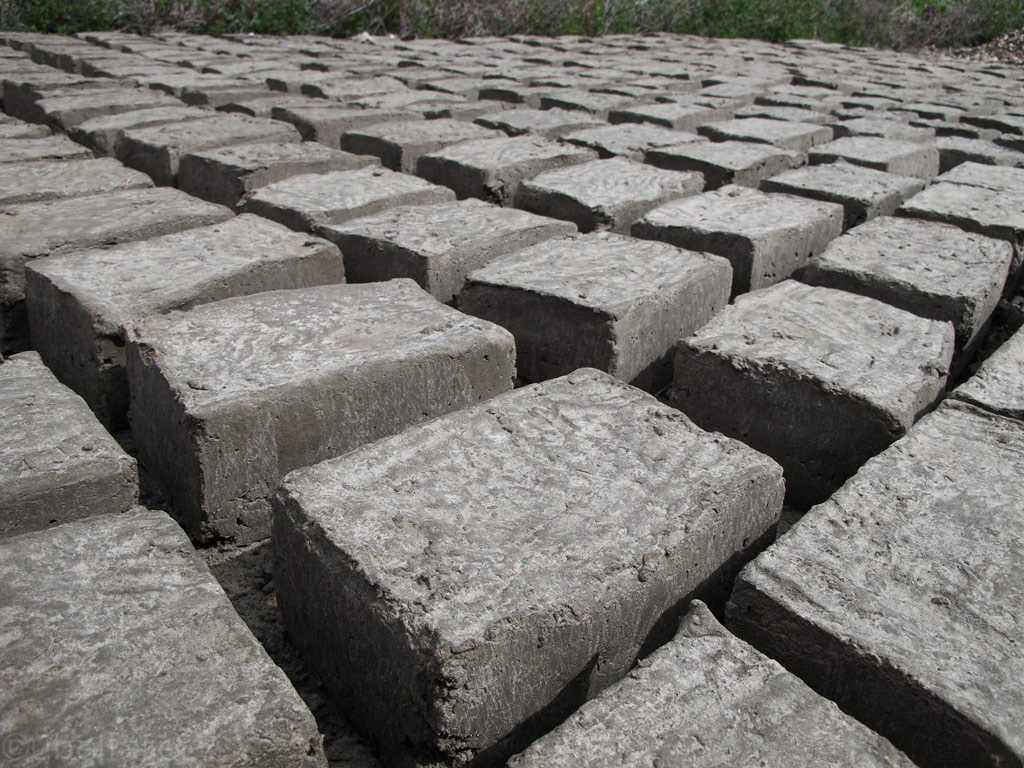
Local brick factory.
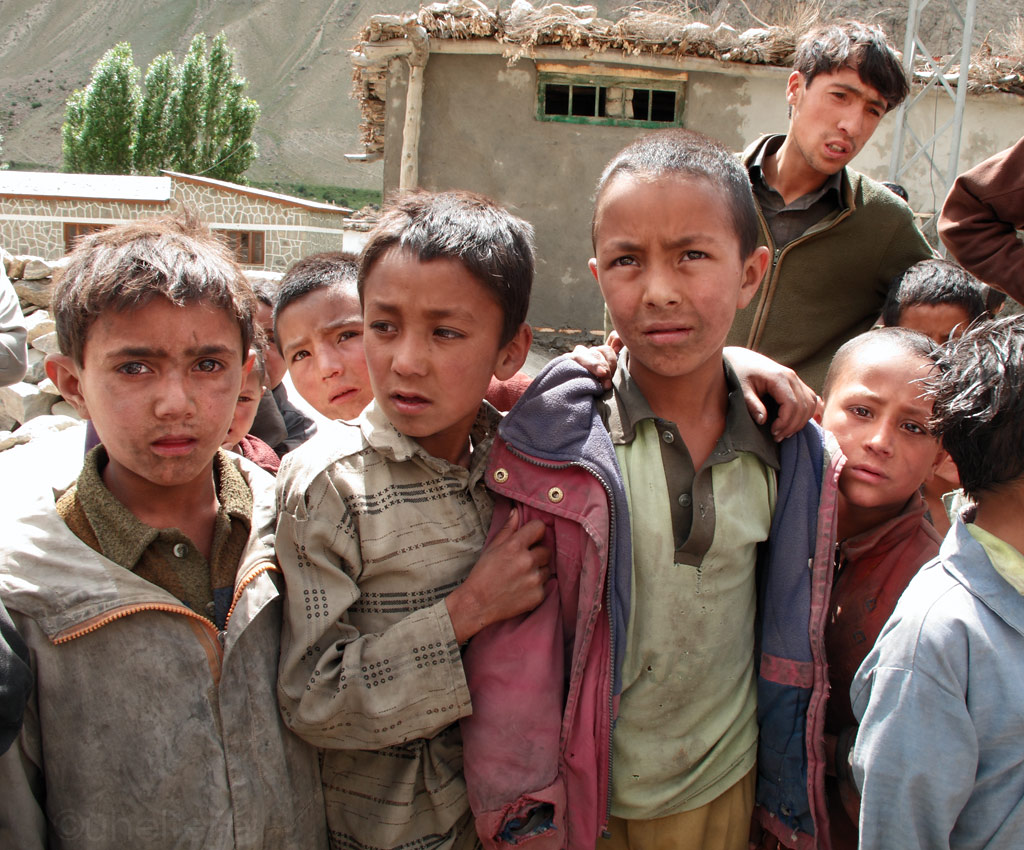
Curious Hushe boys chekcing out our GS and following us everywhere we went in the village.
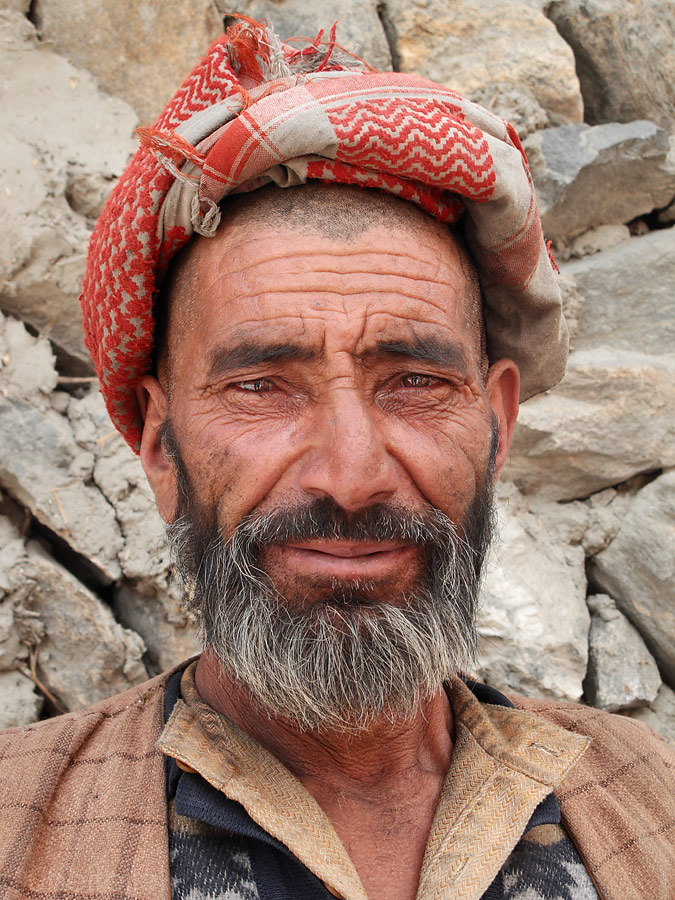
Sufi-muslim in Hushe.
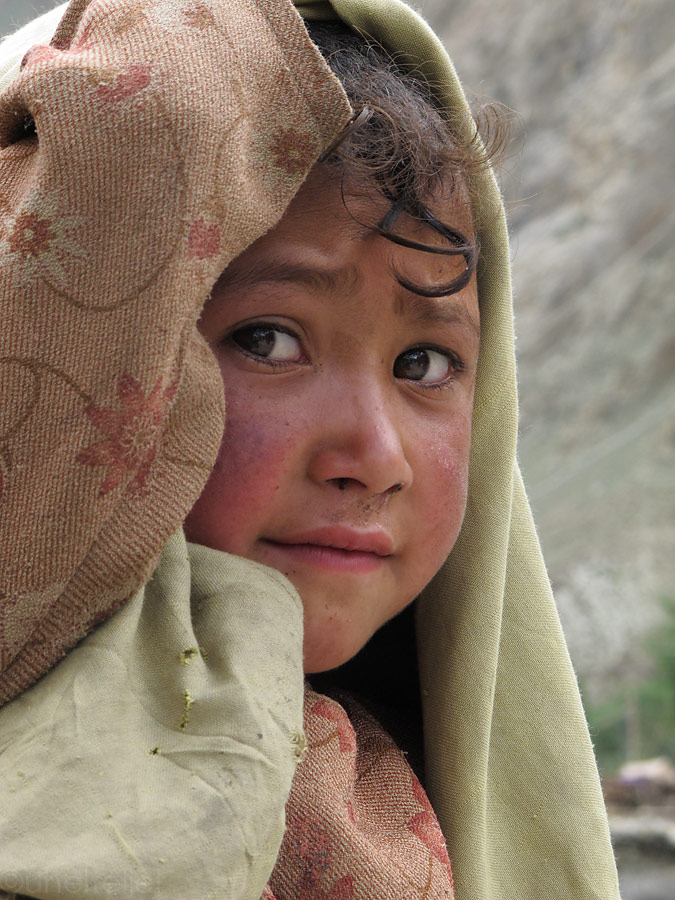
Children.
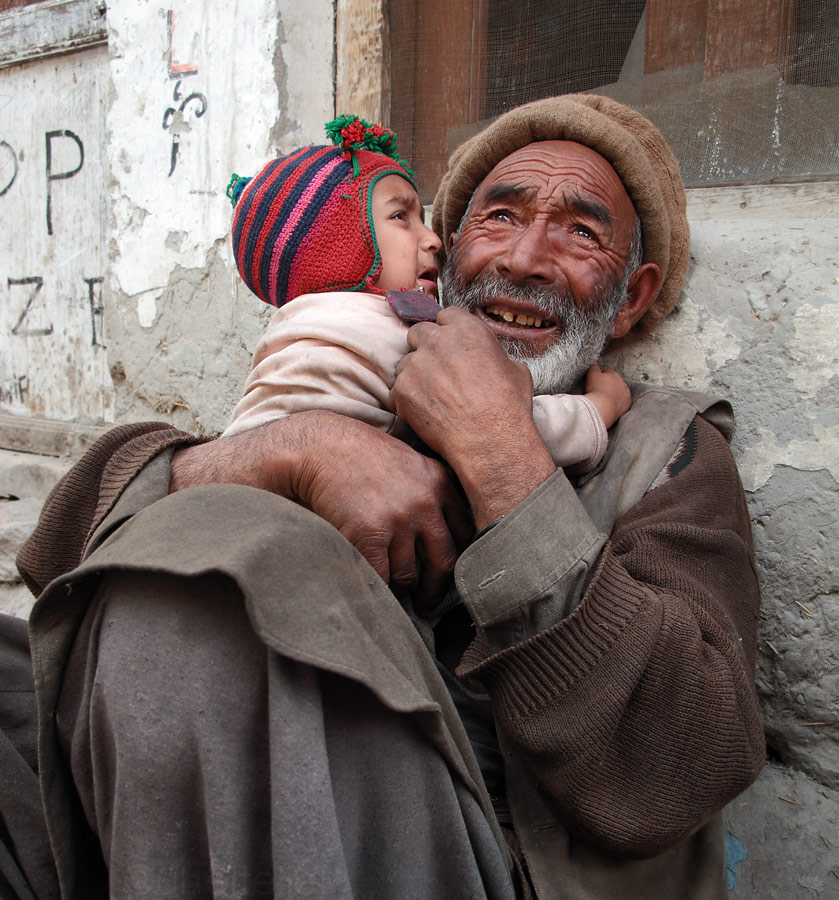
Muslim with a child.
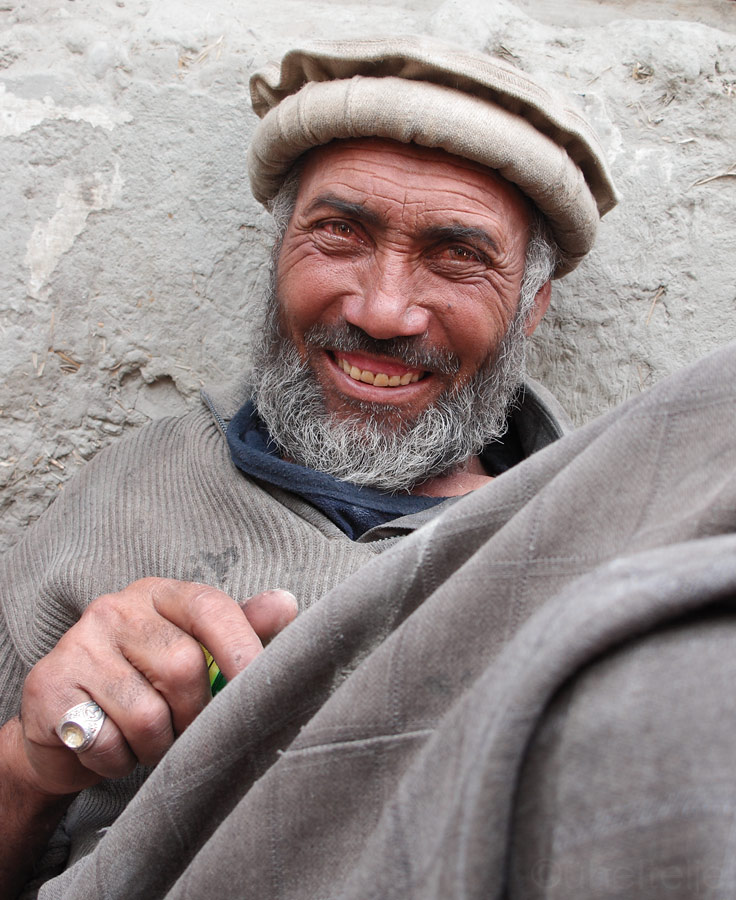
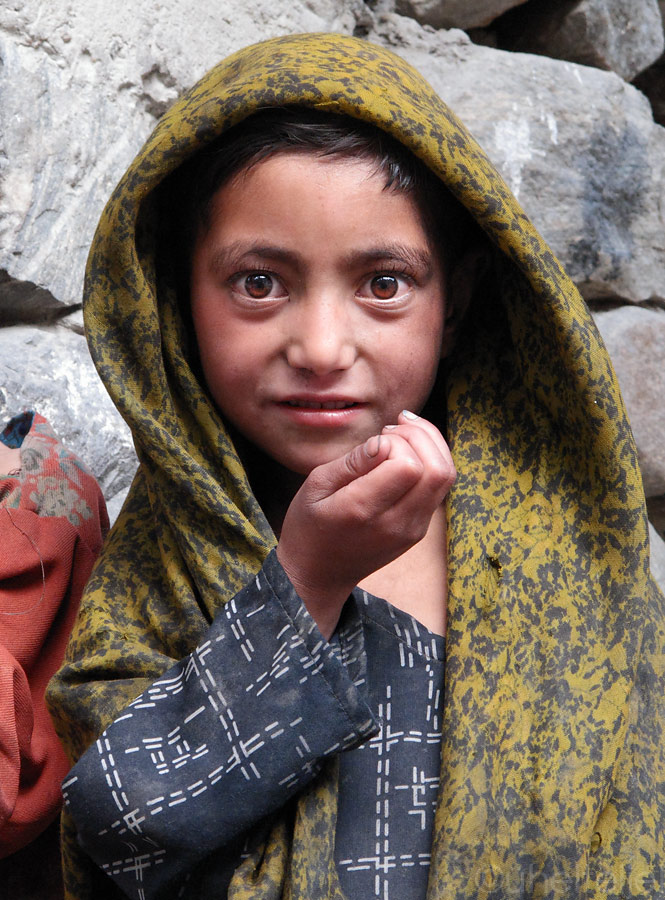
Hushe girl.
So, in order to get a glimpse of the K2, we hired a guide and took off for a trek. It took us some six hours of walking and scrambling along the steep, rocky slopes to get to the viewpoint, ascending some 1100 meters (3 600 ft). After this, our venture into the Ultar canyon in Karimabad really seemed like relaxation - this time it was uphill all the time, sometimes on all four. But most importantly - the higher we got, the broader were the views.
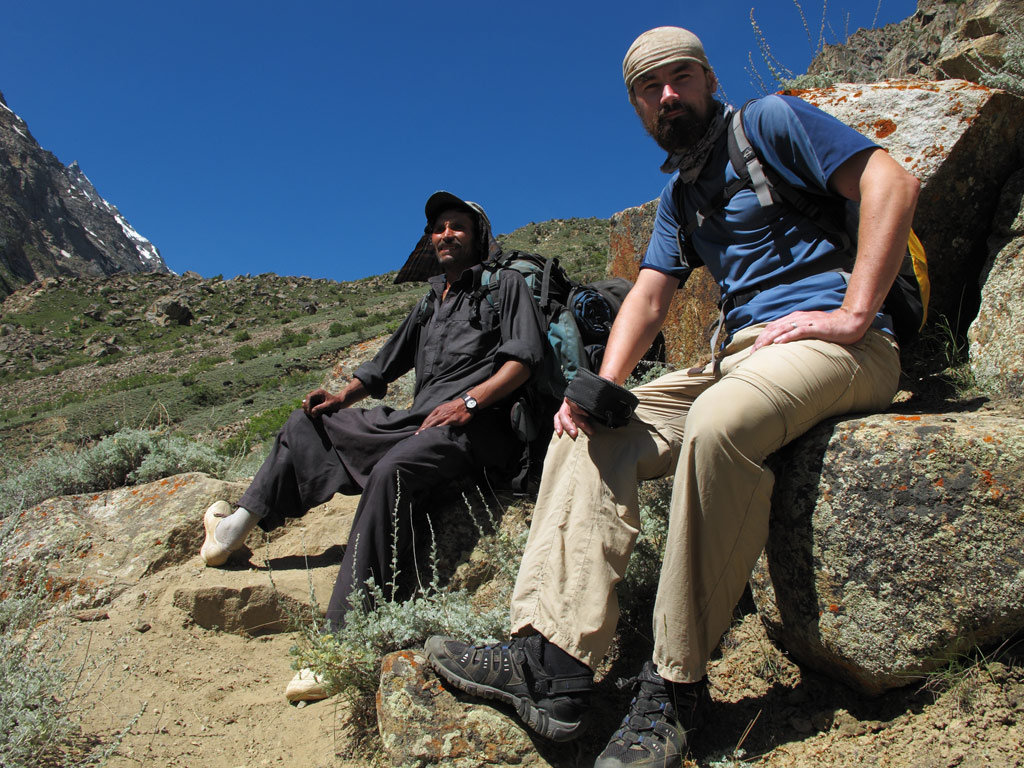
Trekking with our guide.
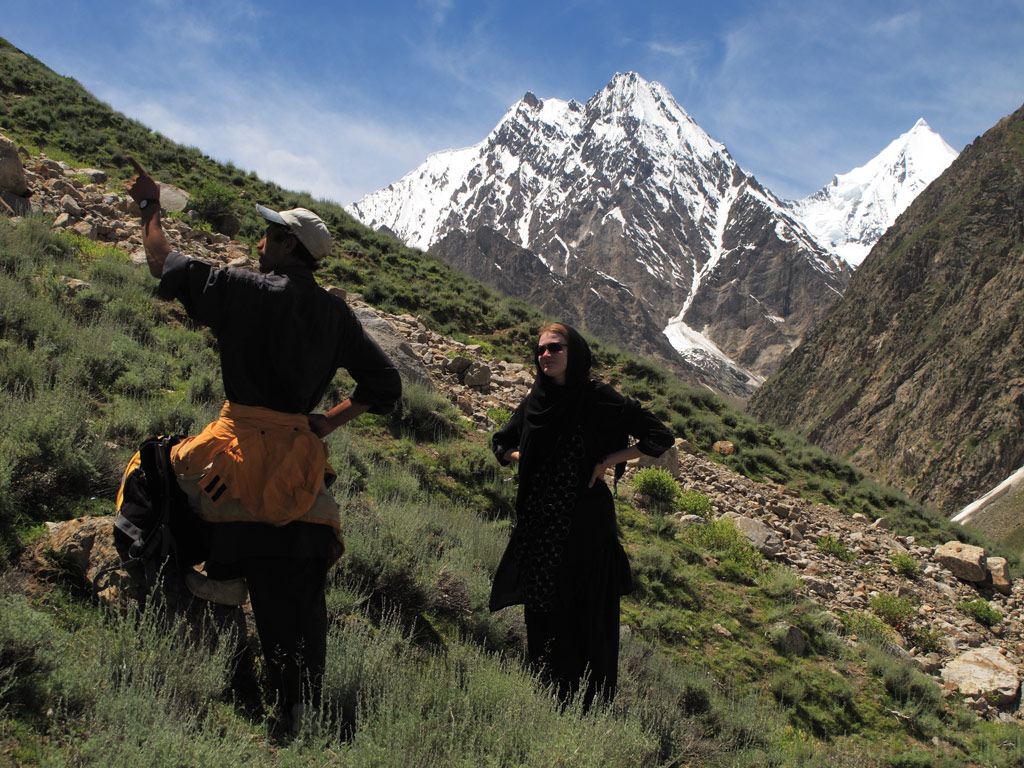
The guide giving explanations of everything - behind is Humbrok Peak.

Panorama from the trek (click to enlarge).
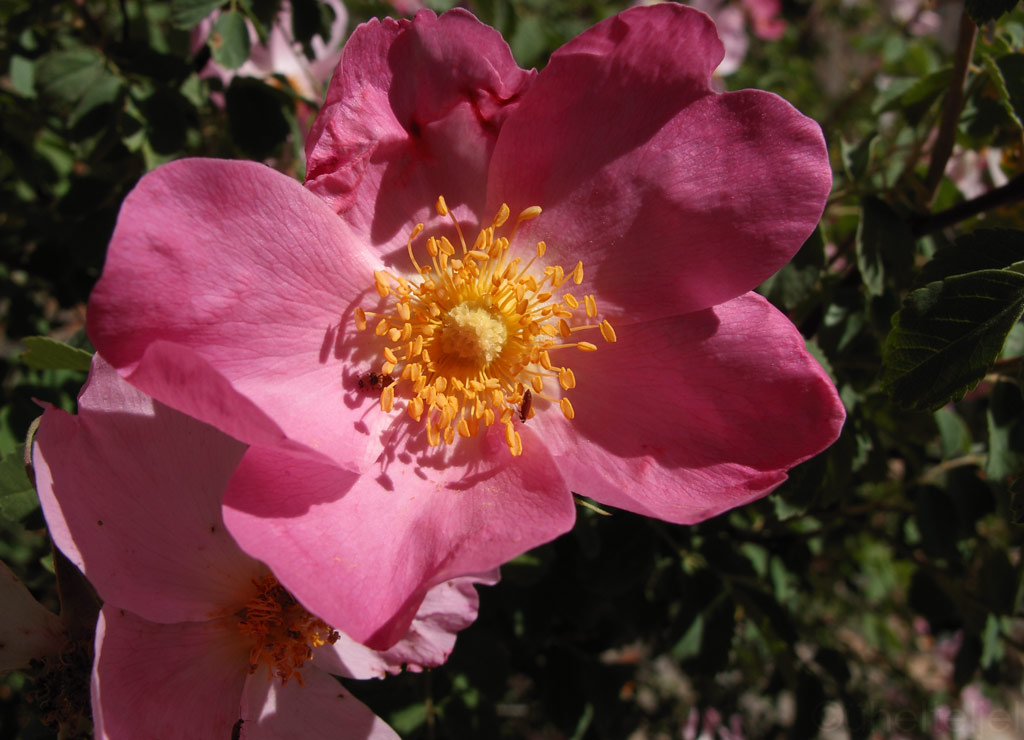
Some flora on the mountainsides - they blossom in August - summer here is short.
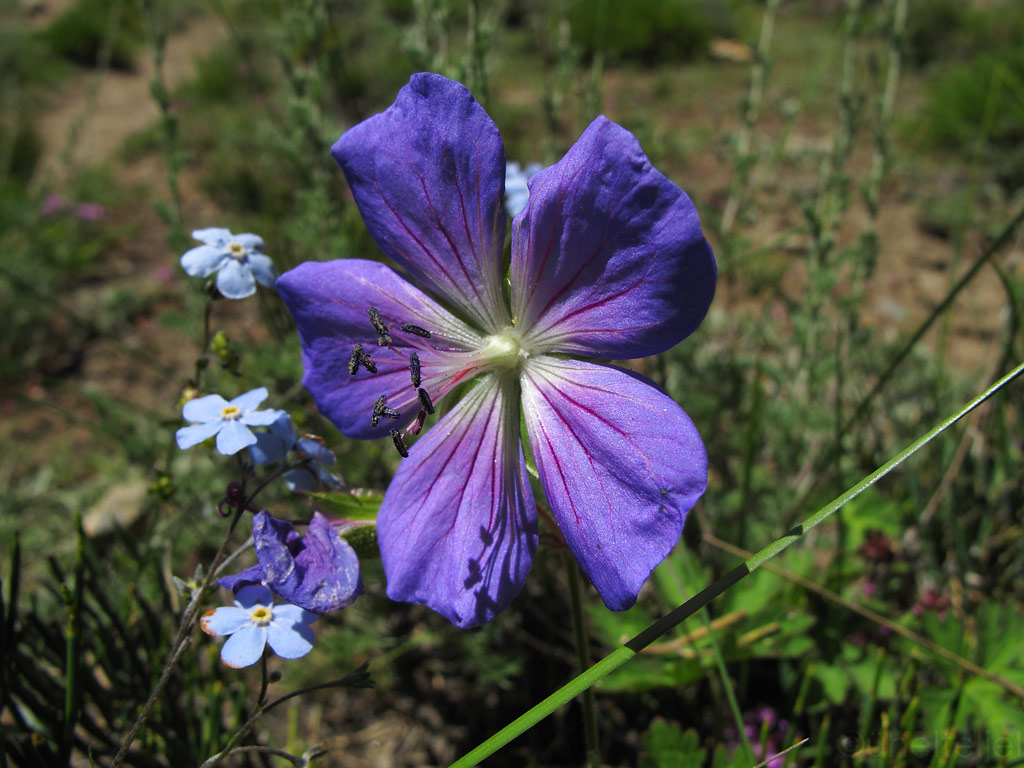
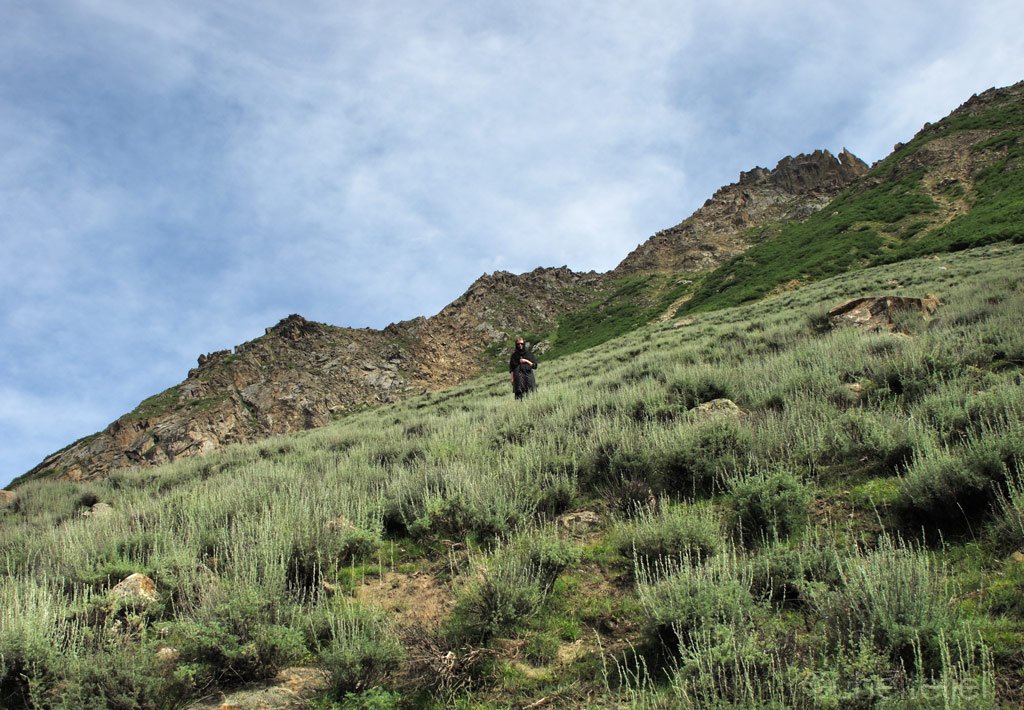
Kariina on the mountainside.
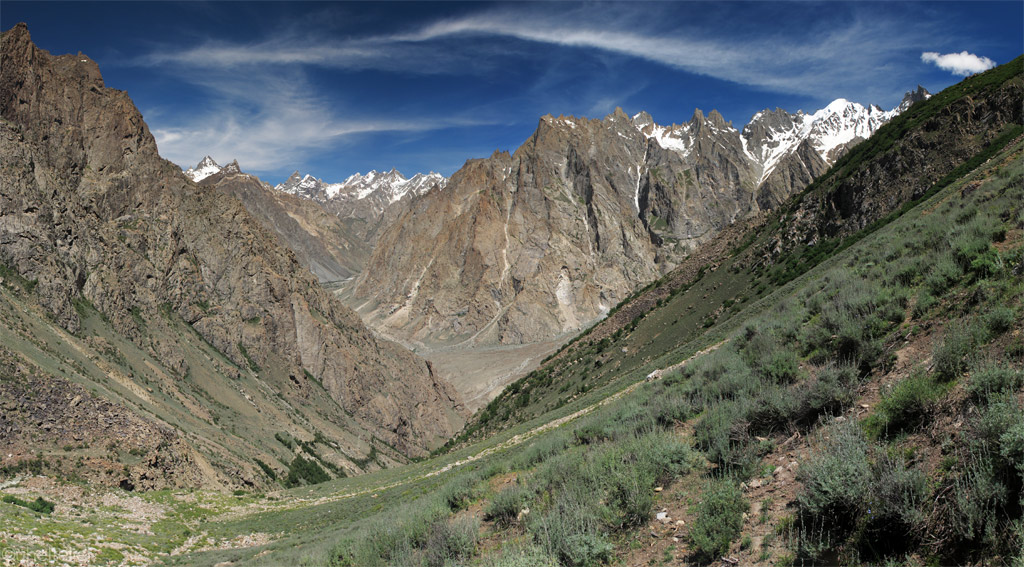
View to the Hushe valley from above.
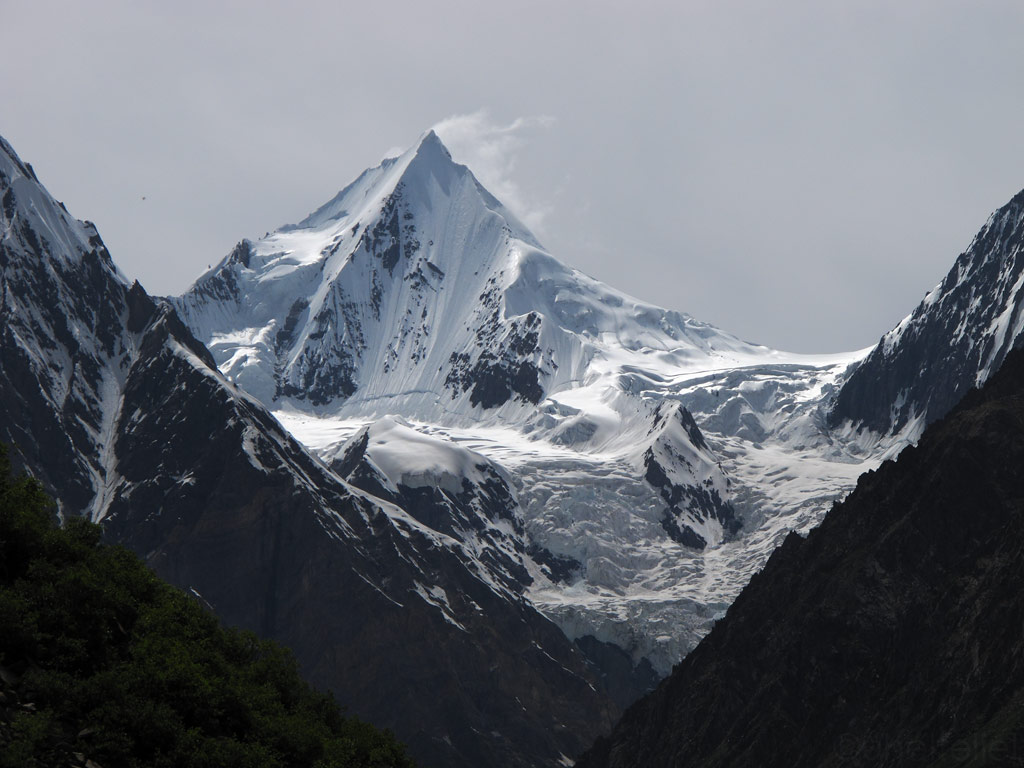
Majestic Cigarette Peak - name comes from the fact that warm winds are always blowing loose snow from its sides - looks like a smoking cigarette.
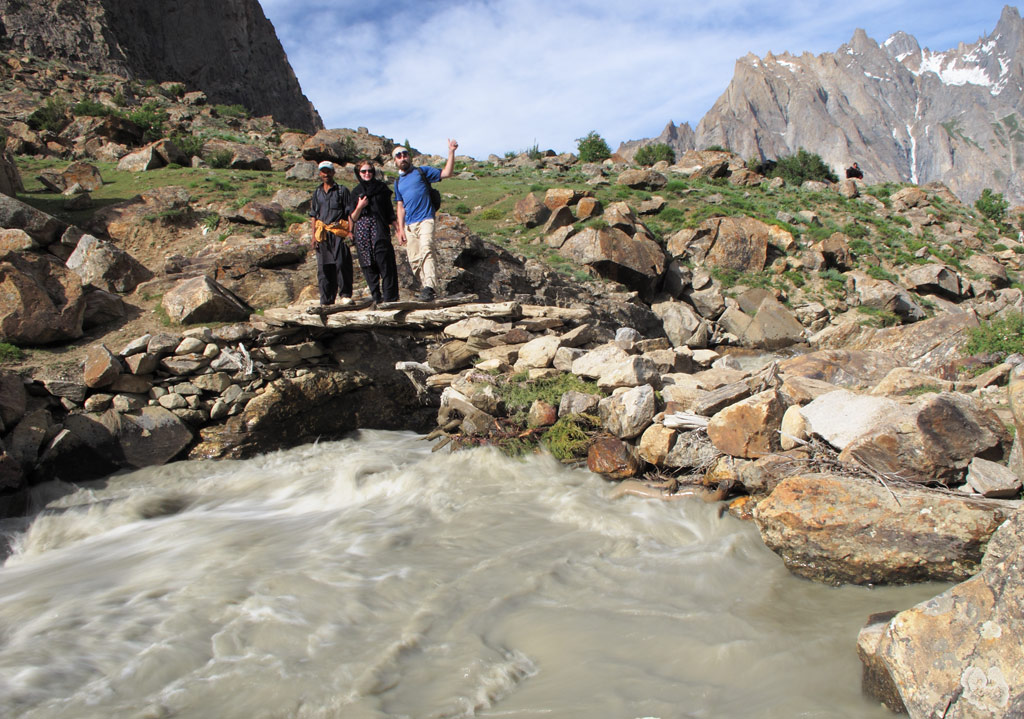
At the end of the trek - our weary bodies need some rest now and pain in the legs is sure to come the next day.
And there it was, K2 (look in the centre of the picture, left of the sharp dark cone)! Far away, and only the top visible of course, but worth the effort - to get the full view of the K2, you need an over a week trek with special permits from Islamabad and special equipment and training for a bit more technical glacier travel (rope technique). So we were happy to get that rare glimpse to the K2 which is very hard to obtain anyway.
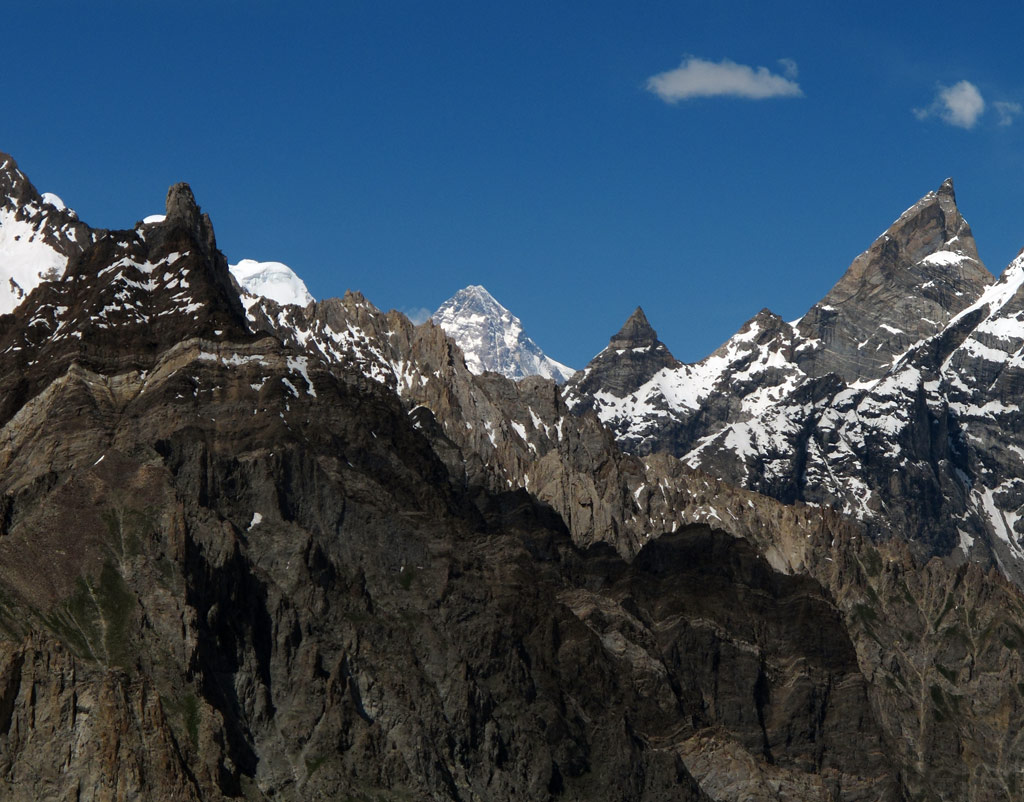
The mighty K2 (8611 m / 28 251 ft) peeking in the middle of the picture.

Panorama of the peaks from the viewpoint - find the sneaky K2 in the picture (click to enlarge).
Descending from the viewpoint, we set our camp in the seasonal village of Humbrok at around 4000 meters above sea level. Most of Hushe's women spend there the whole summer, herding the yak and the cows, and making butter and yoghurt. Younger ones assist by collecting dry wood and cow dung for fire. Living conditions are very simple - sleeping and cooking in stone huts, and washing in streams with ice cold water.
Our appearance was, of course, a big thing, especially among the girls. While our guide, Sher Ali (whom they also called Sherpa) was cooking us some rice, there were some ten little heads sticking in the stone hut doorway, observing the strange white people. Actually, the airflow of the hut was pretty much cut off by all the attention, so the smoke could not get out and we sat in a haze.
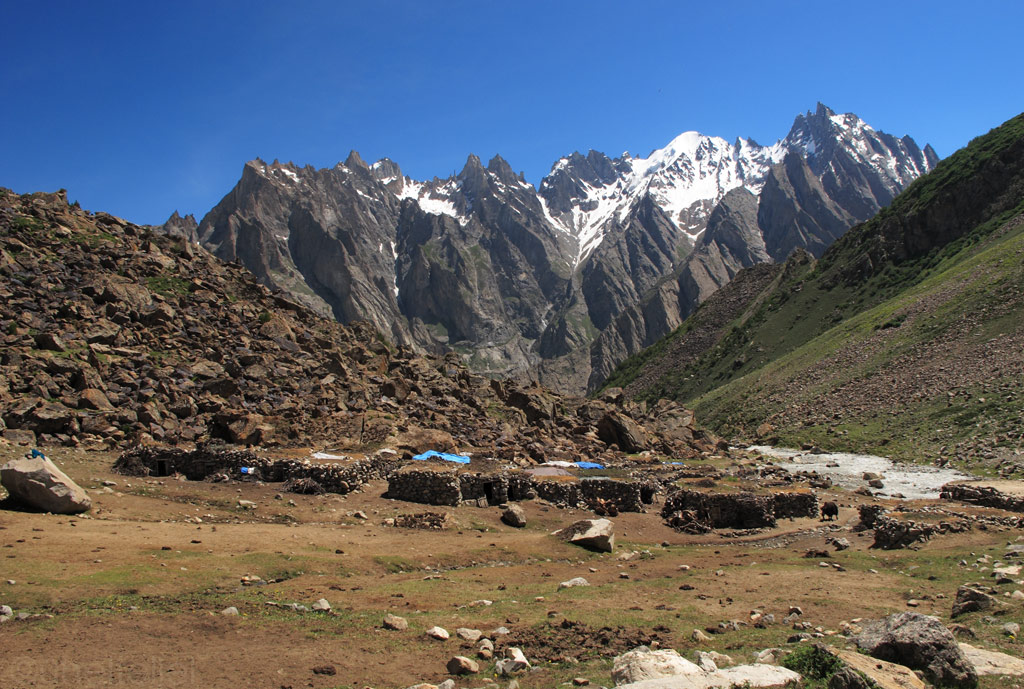
Humbrok village - only women and herd live here in the summer. Most of the year it's under snow.
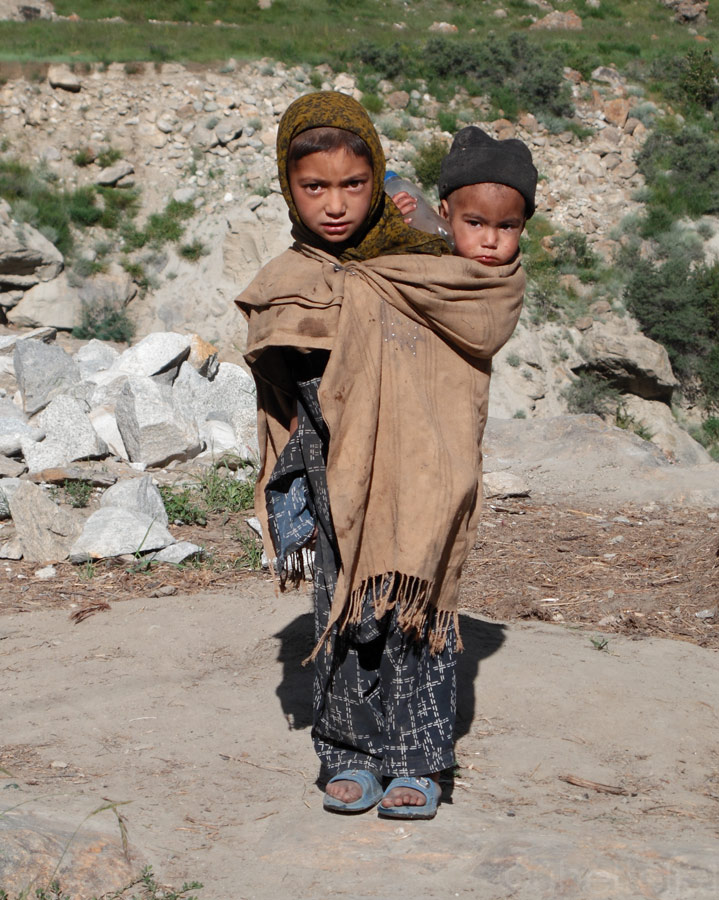
Young girl carrying her brother.
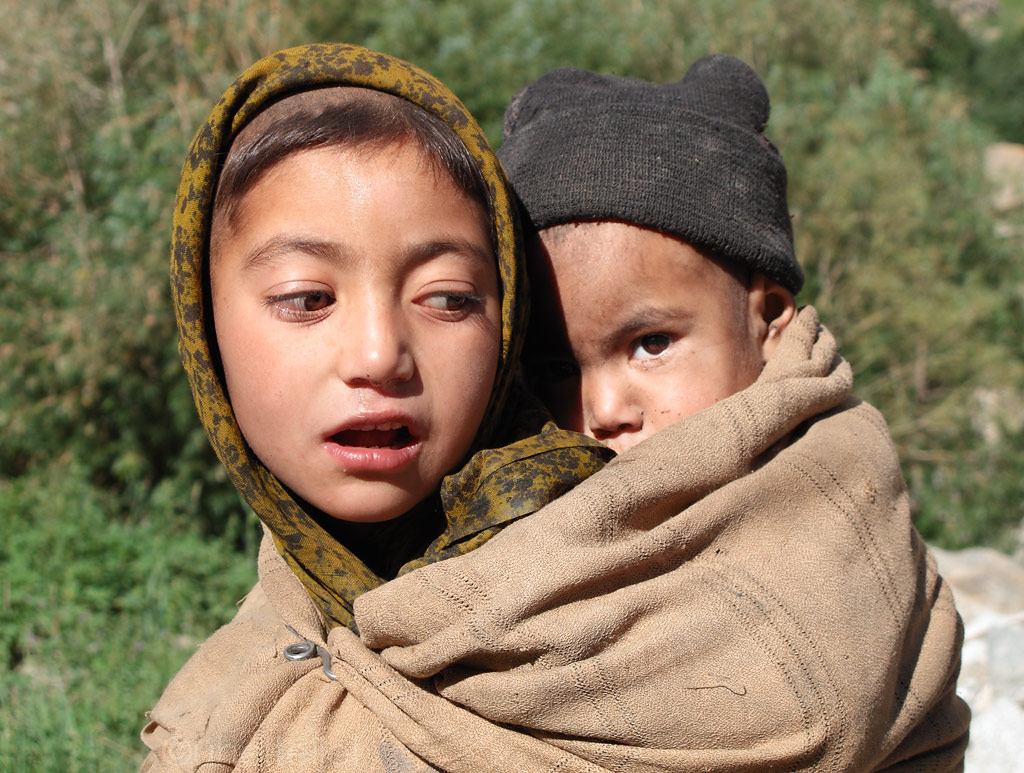
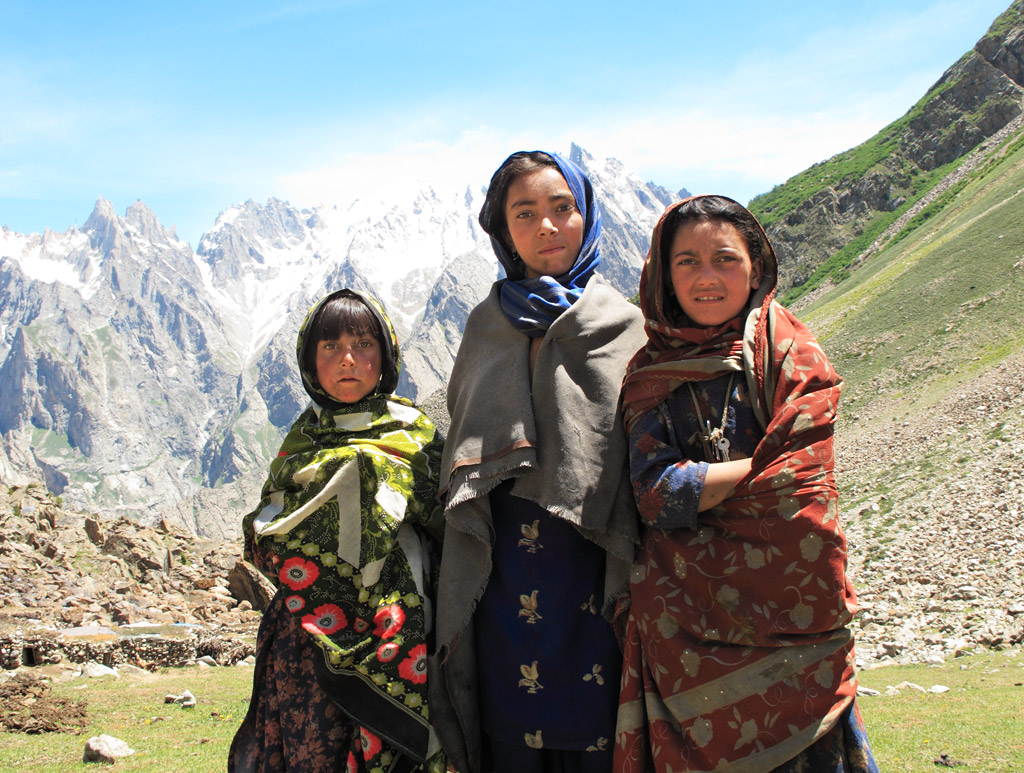
Muslim girls in Humbrok - it took a whole day for them to take us as insiders so we could get a chance to take pictures of them - mostly Muslim women say straight NO to any picture taking of them.
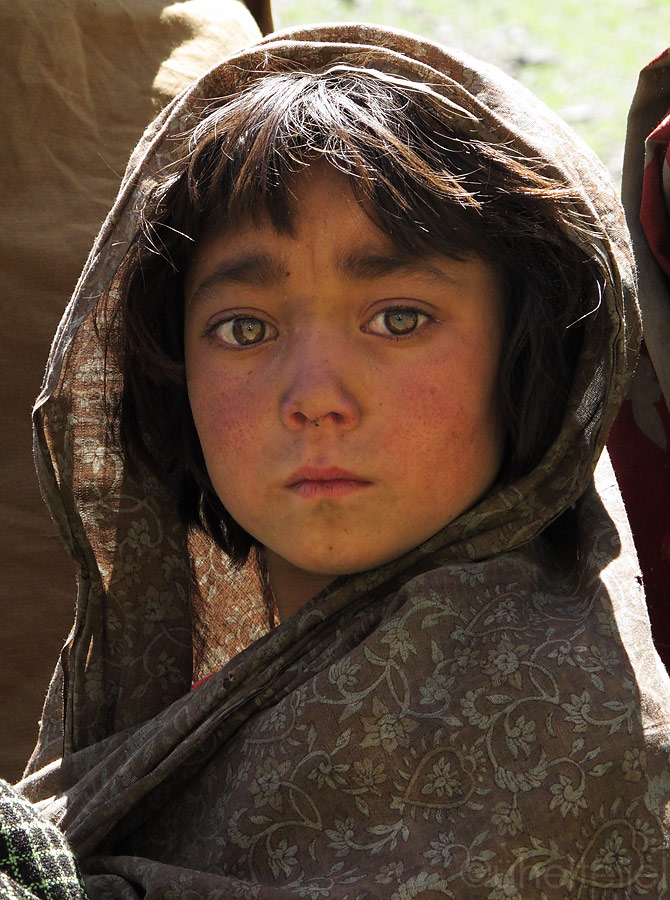
Humbrok children.
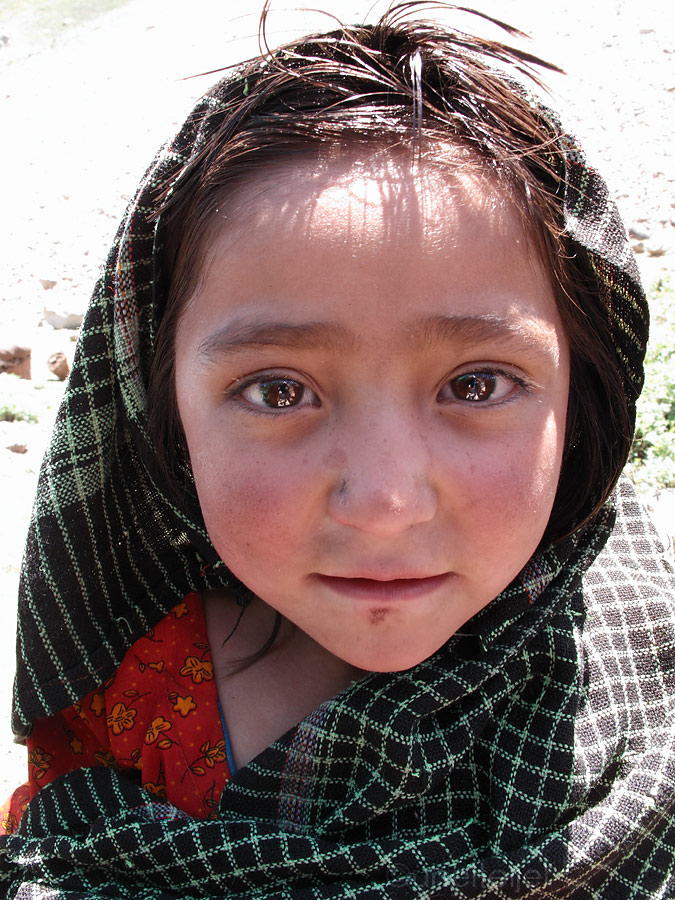
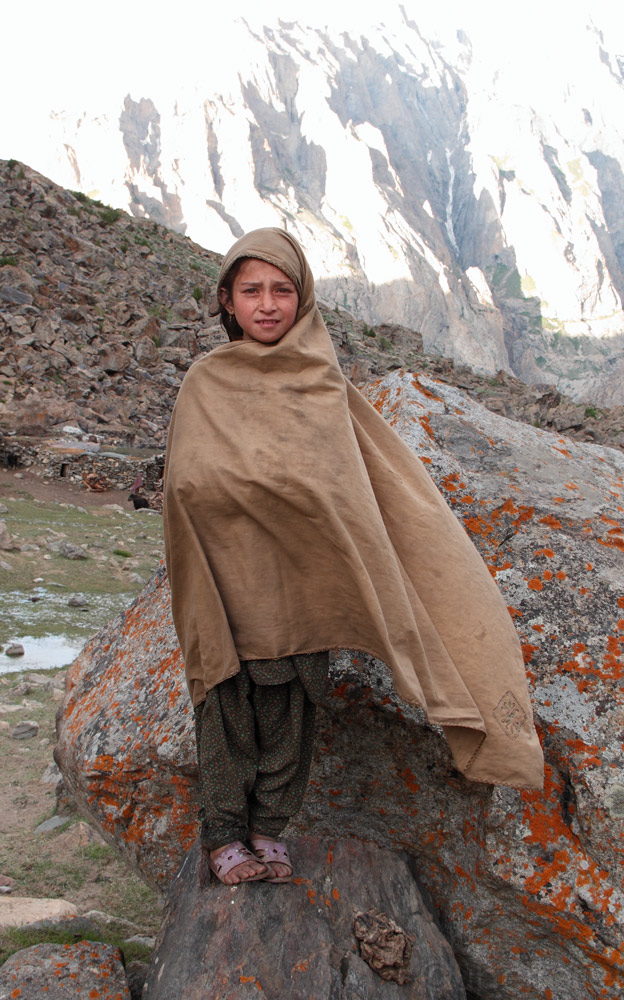
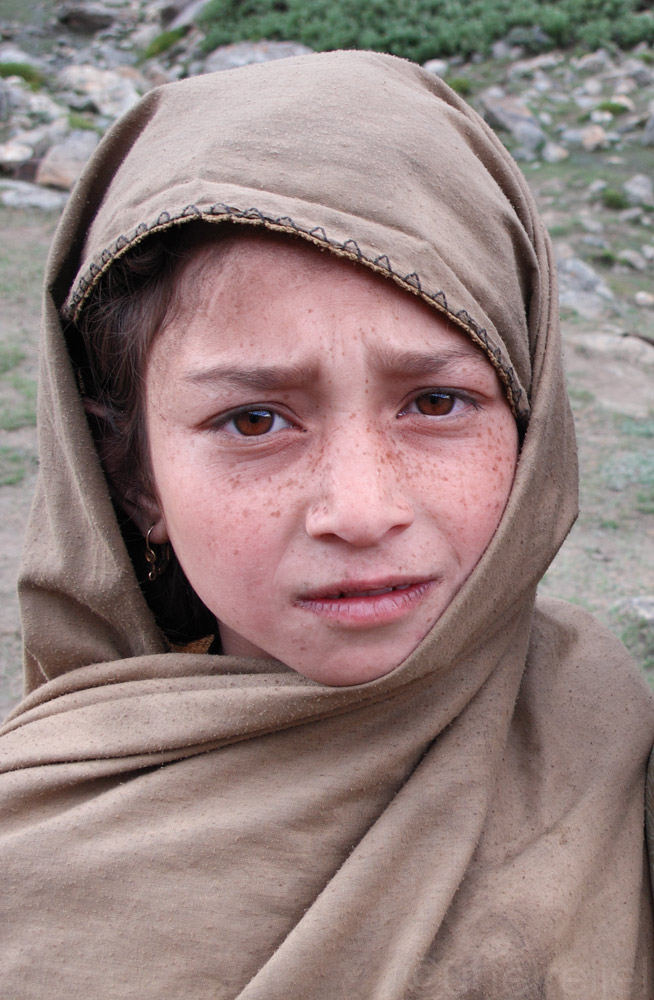
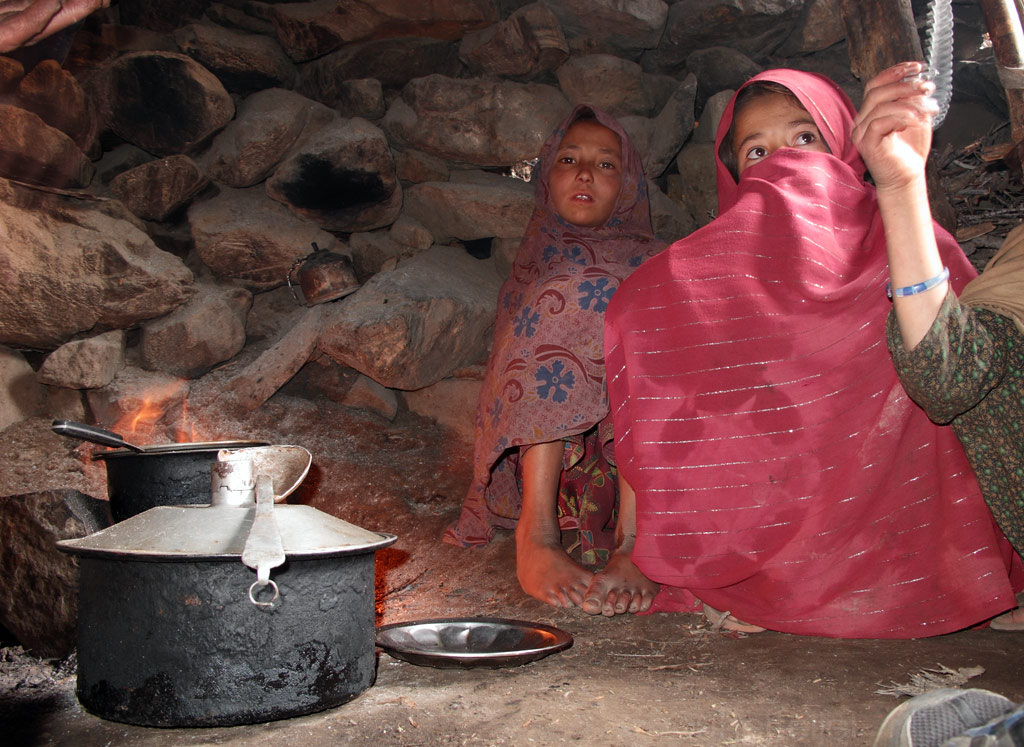
Inside the stone hut.
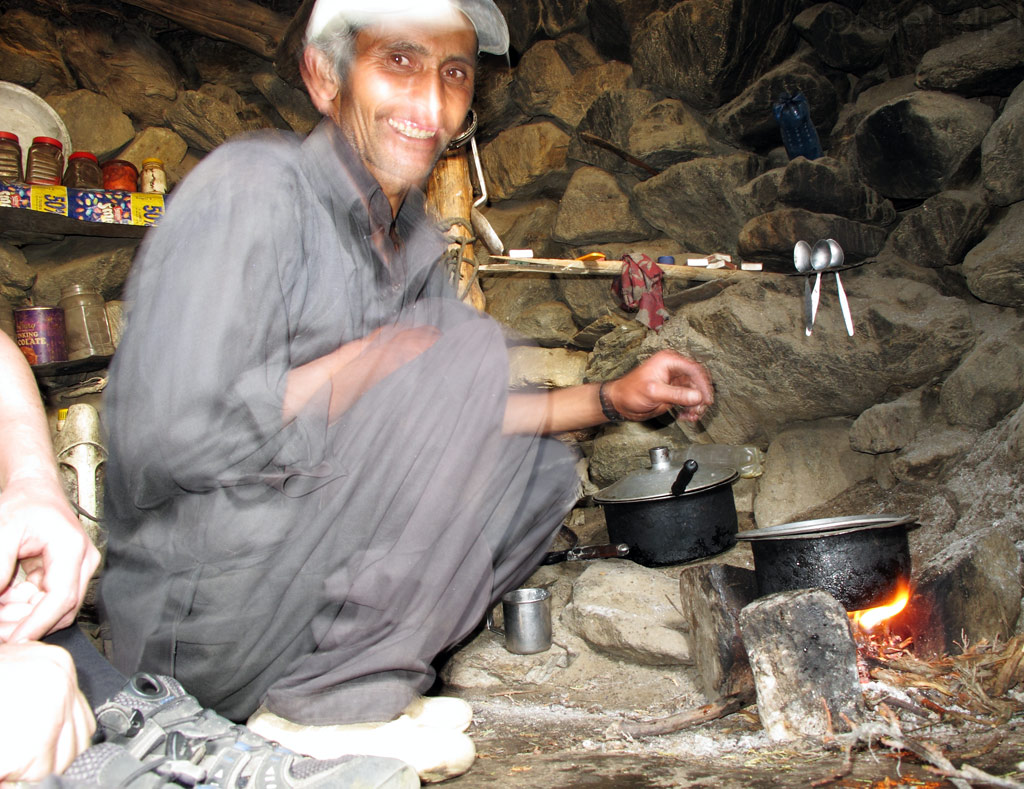
Sherpa making us some chai.
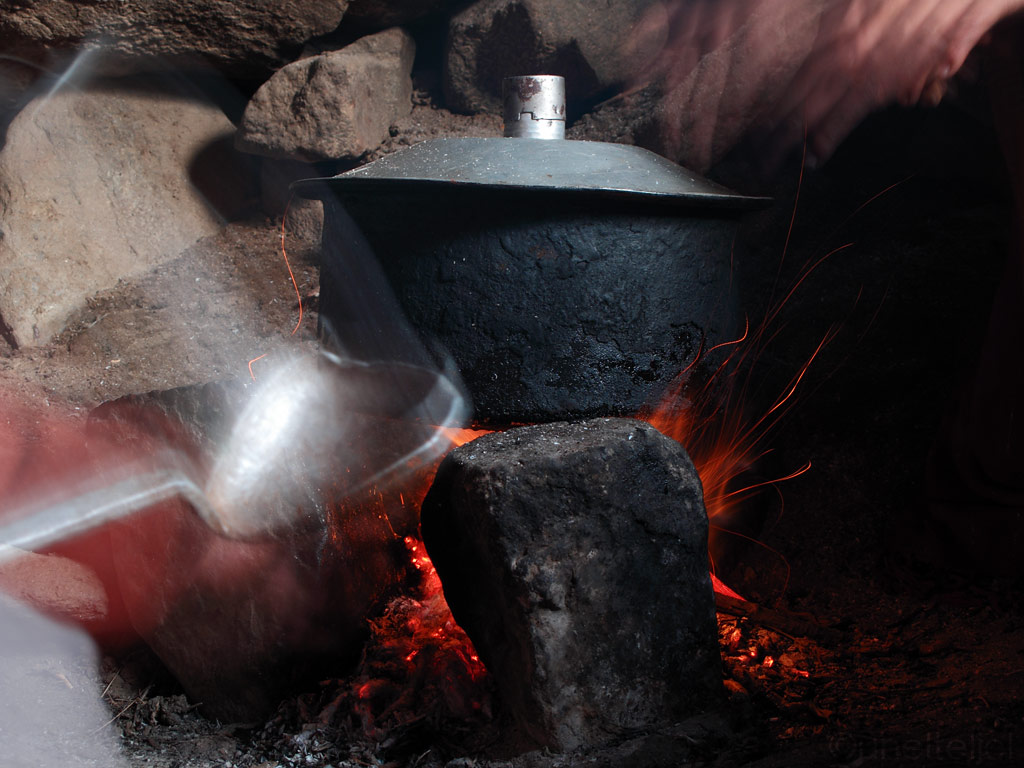
And soon rice was cooked - tasted good after exhausting day trekking in the Karakoram.
It definitely was an experience, and one of the highlights of our stay in Pakistan - to watch the rice cooking in the dimly lit stone hut, and meanwhile to sip the chai made from fresh milk.
Next day as we headed down to Hushe, and sat on the bike for a ride back to civilization, we felt as if Pakistan had turned its smily face towards us. Until… just a little before we reached tarmac… the violent swinging of the rear brought back some old memories. The rear shock was blown, badly.
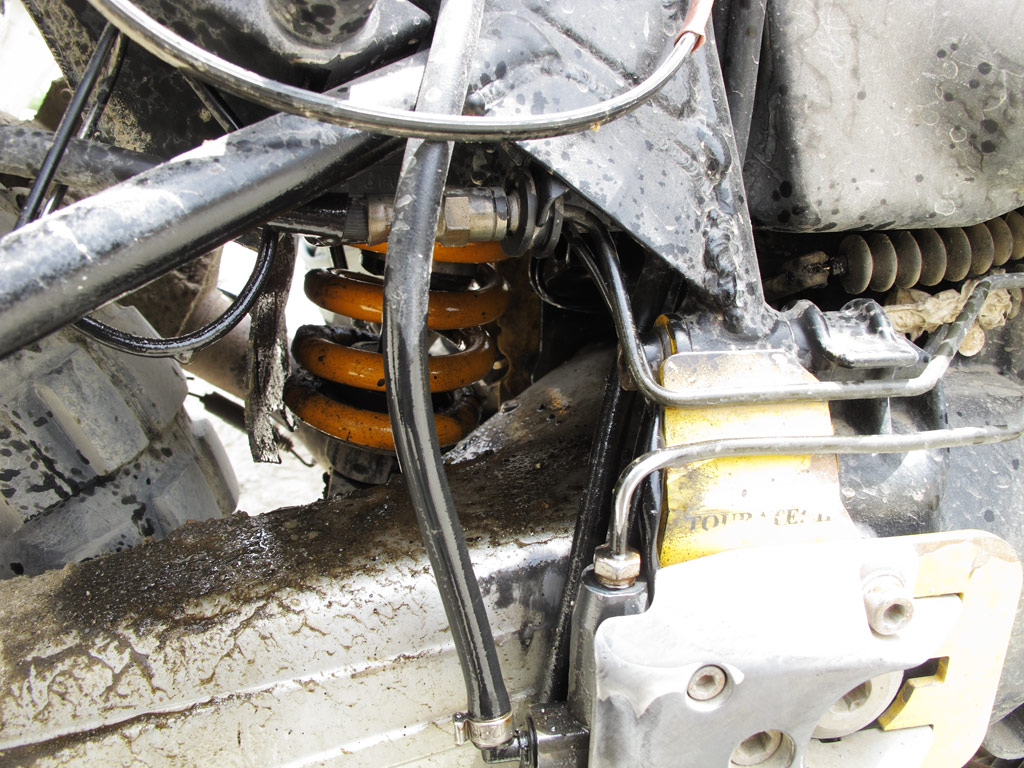
Not again!!!
It was phenomenal this time, the problem. It wasn't the main seal leaking, but the body itself had cracked, with inner seals peeking out. Never would have thought this could happen to a supposed-to-be high quality shock.
Not much left to do with this ingenious creation of Öhlins engineers, we headed to the nearest tyre shop and stuffed the thing with some rubber. Put some duct tape on it to keep the composition from disintegrating, and swinged (not so violently thanks to the rubber) back to Skardu. Even on the relatively smooth tarmac it felt like riding in a horse cart, with speed never exceeding 40 km/h.
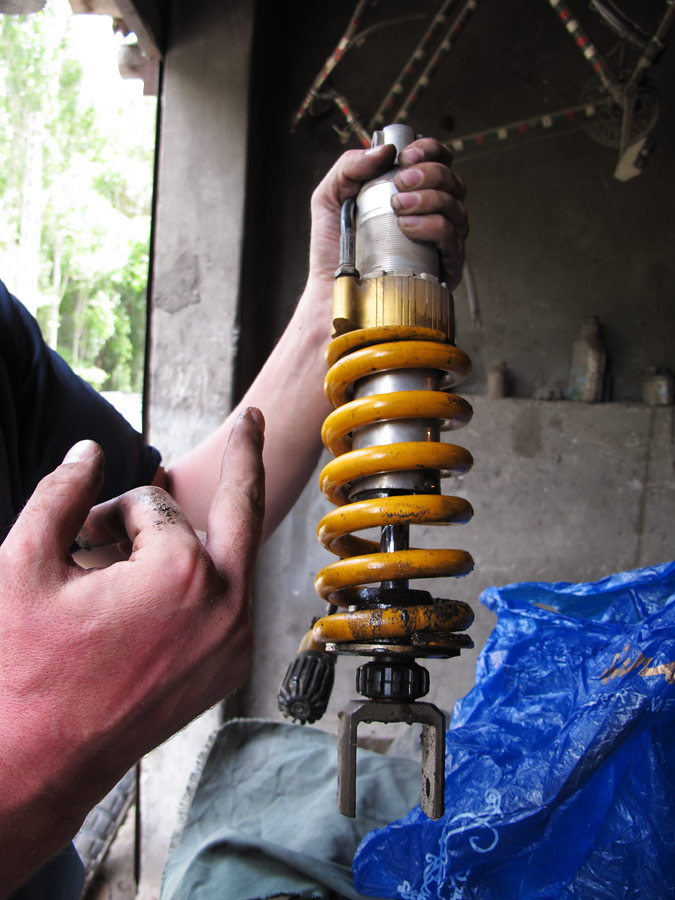
Proper introductions first.
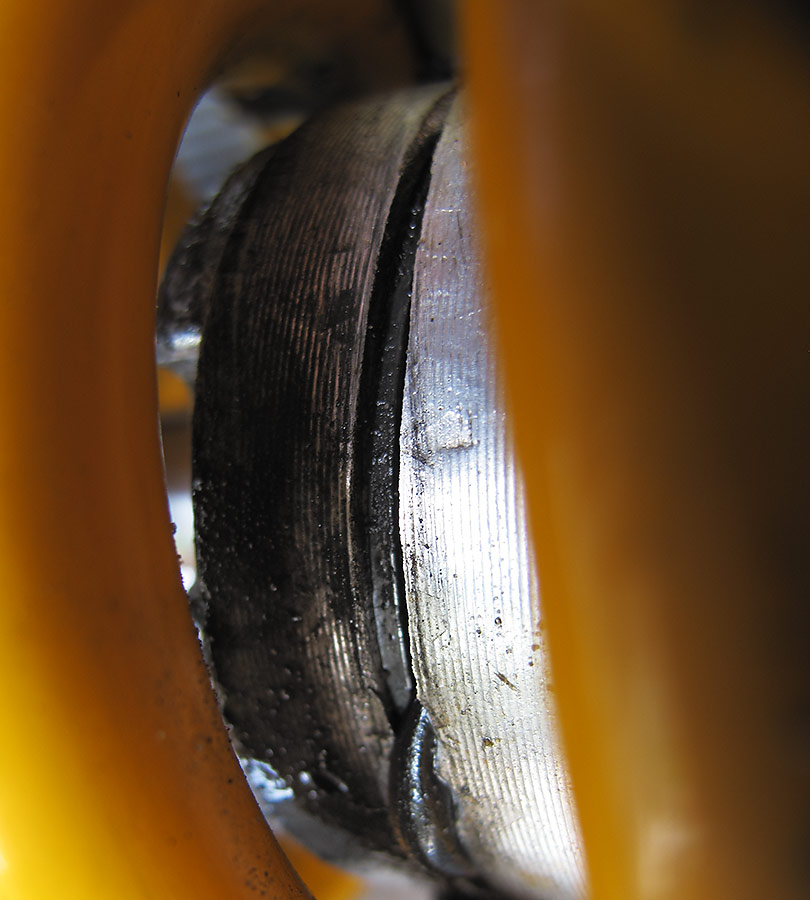
Cracked body of Öhlins shock. The world famous Swedish quality of metallurgy?
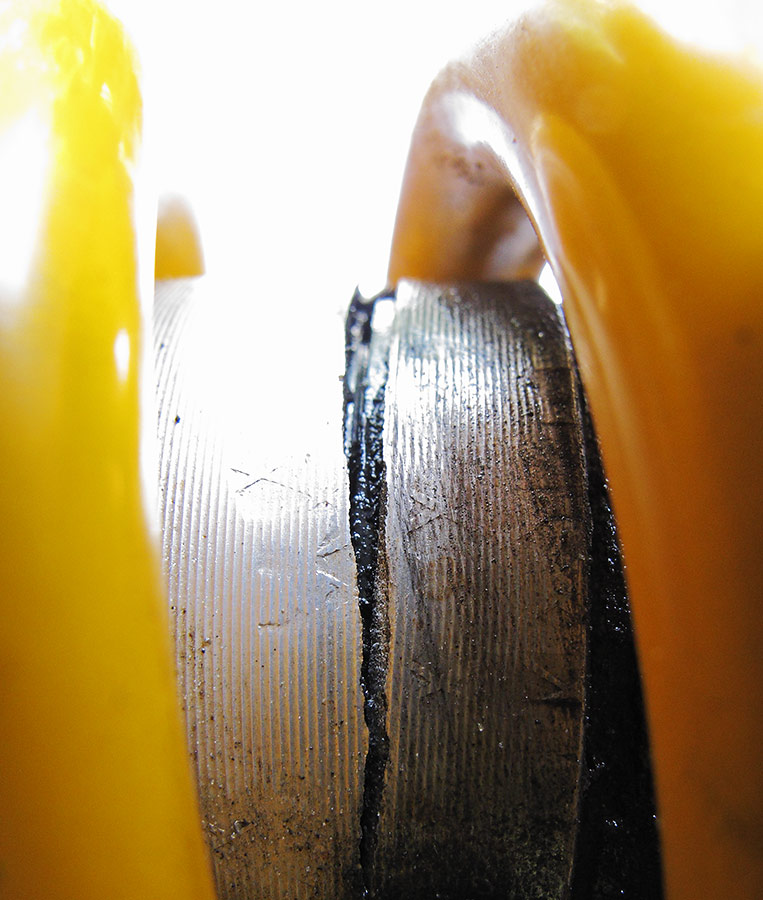
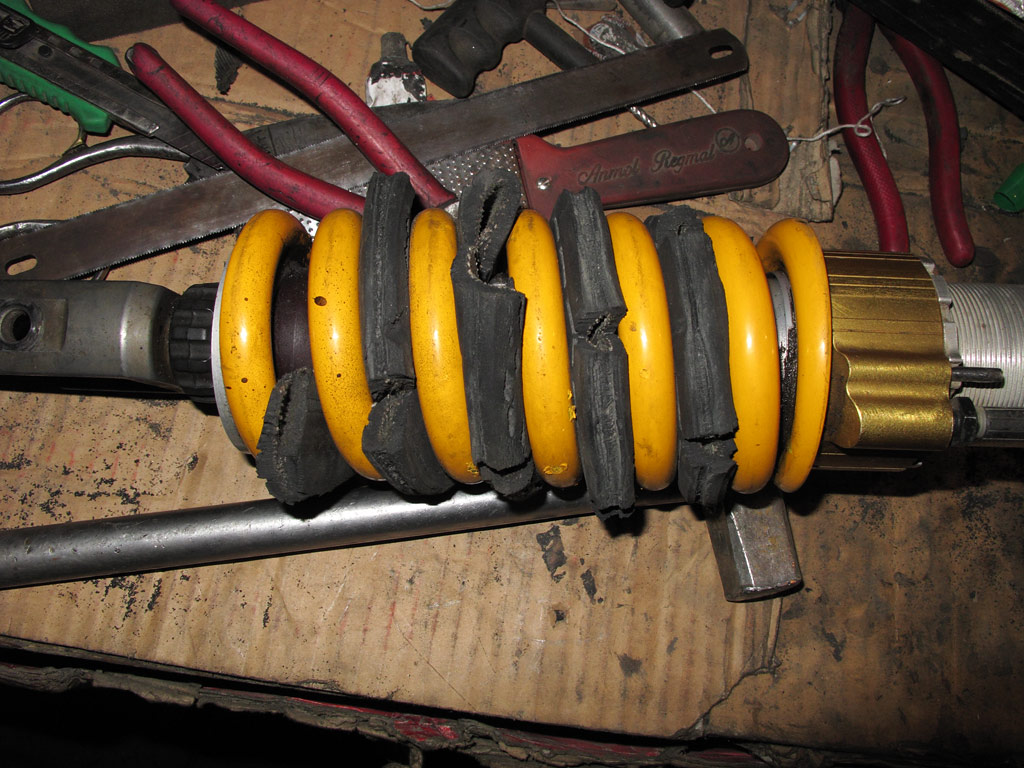
I put rubber between the spring to dampen the shaking.
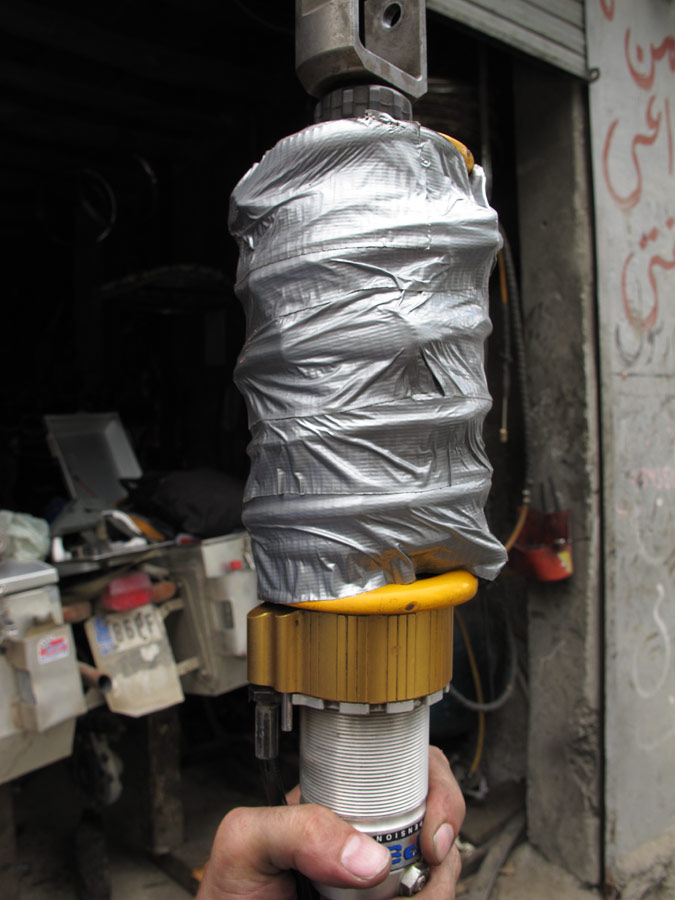
Taped it up so the rubber doesn't jump out.
Farewell all our planned detours to Deosai Plains, Nanga Parbat base camp, Boroghil and Chitral, we now had to figure out what next, because this time the suspension damage was beyond repair, and having a new one shipped to Pakistan is costly to say the least. No easy solutions on this one.
So guess what - we were pretty much screwed!!!
Soon enough we discovered that we were actually stuck in Skardu - while we had been out having fun trekking and destroying our bike, there had been some landslides, and the road back to Islamabad was cut off with no one knowing for sure when it might reopen again. So there we sat, with a broken shock and expired visas (there is no way to extend them there, because obviously Estonia is not one of the 45 countries the citizens of which are entitled to apply for an extension here) - or you could say - illegally. Interesting, how such a thing as a broken shock can become only a secondary problem, but we know that it can.
While we were struggling with all the crap, had a chance to get a closeup of some more cheerful stuff - Pakistani truck art!!!
Although Pakistan has left us a rather grim impression, with public performance considered a taboo in Islam (so no singing or dancing, except for the Ismaili Muslim wedding in Hunza), there still is some colour. I wonder if the truck drivers are (un)consciously trying to create some balance by introducing VERY lively colours and attributes to their trucks. And trucks like these are absolutely normal here - except for some military or police vehicles, all of them are like circus wagons. Amazing.
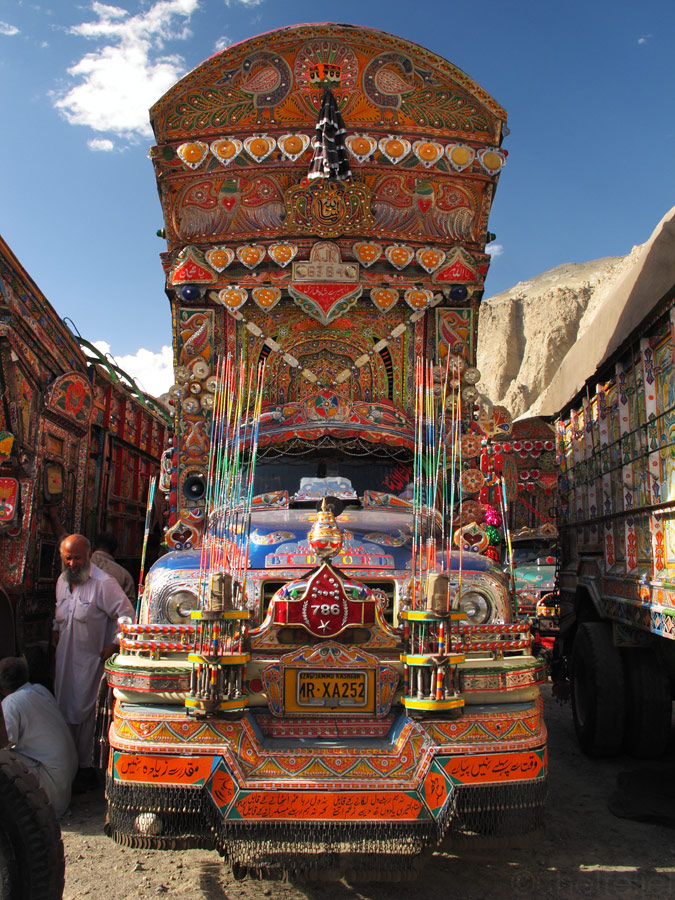
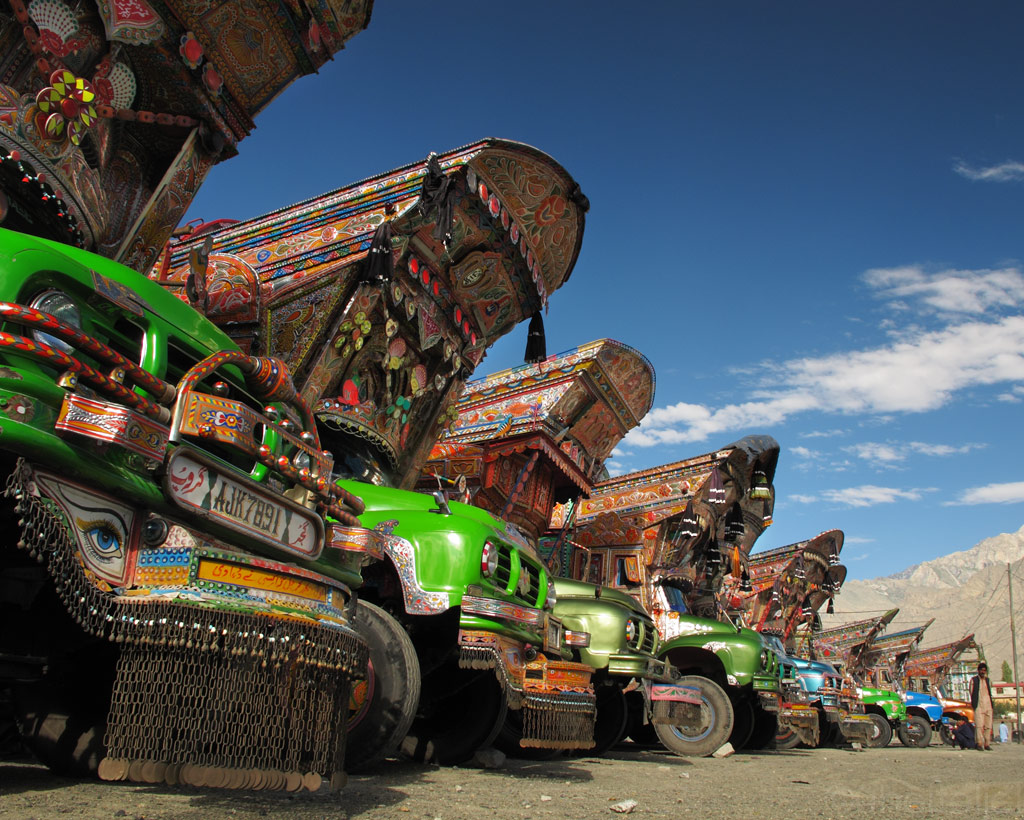
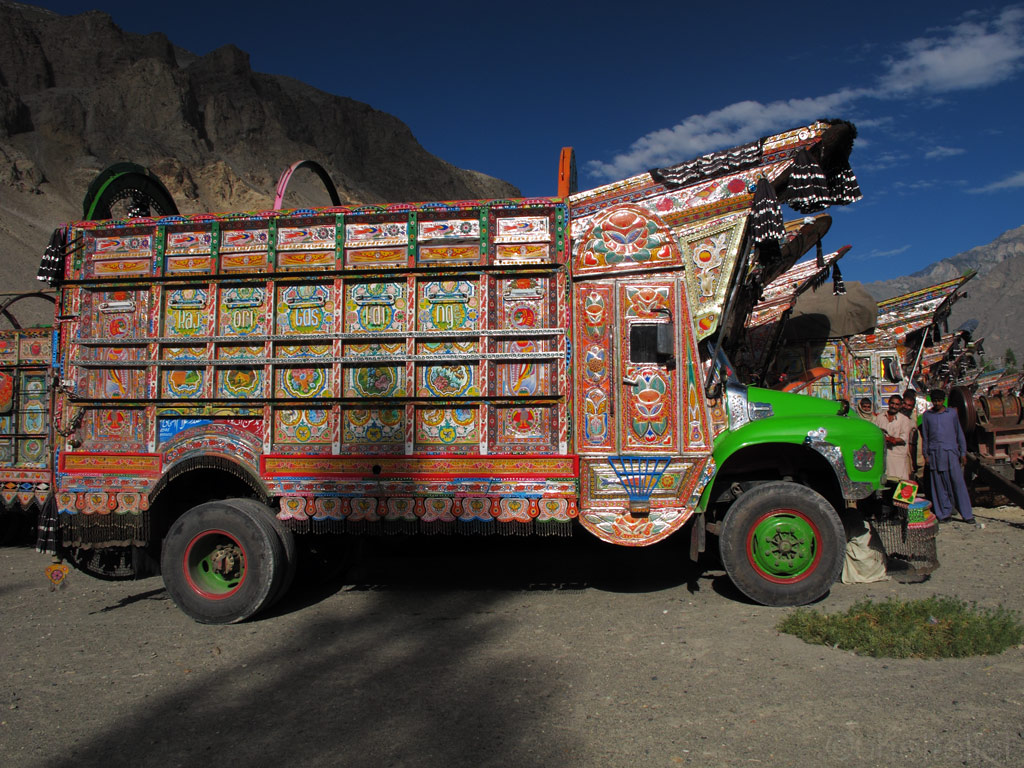
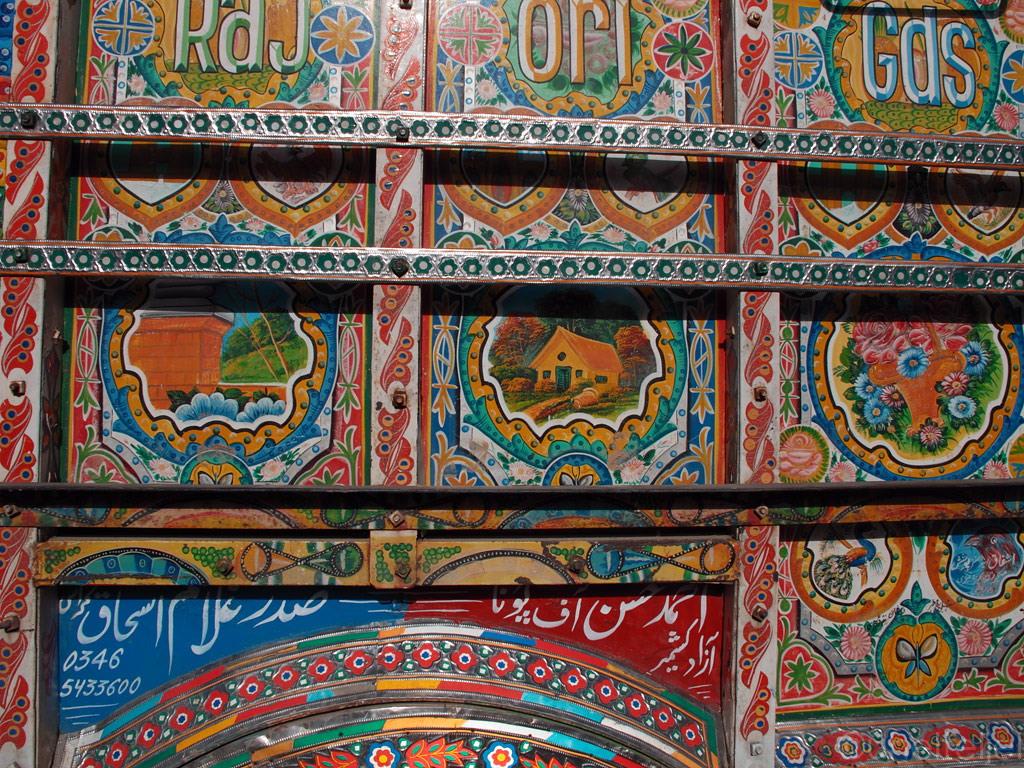
Detail.
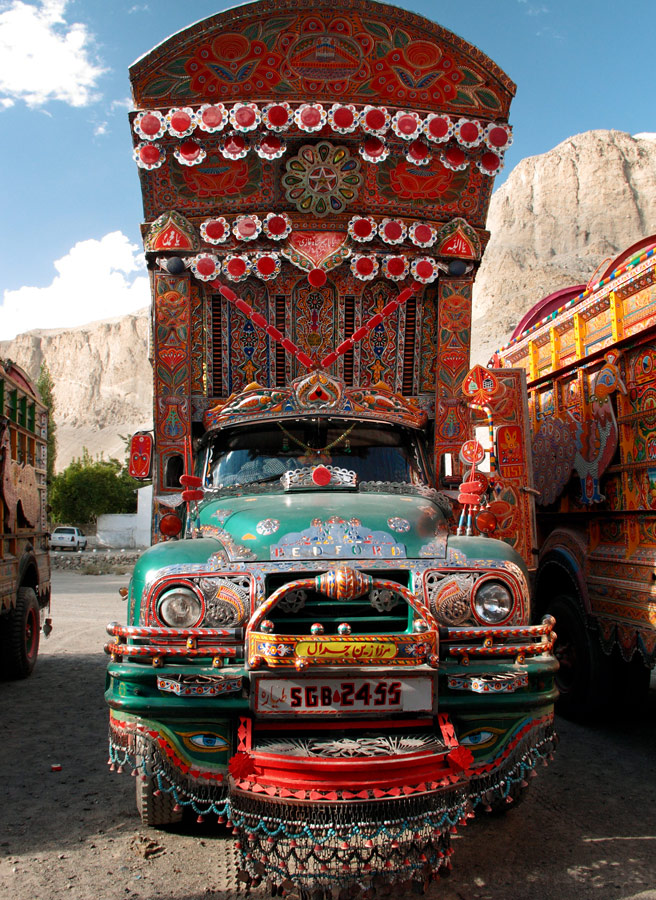
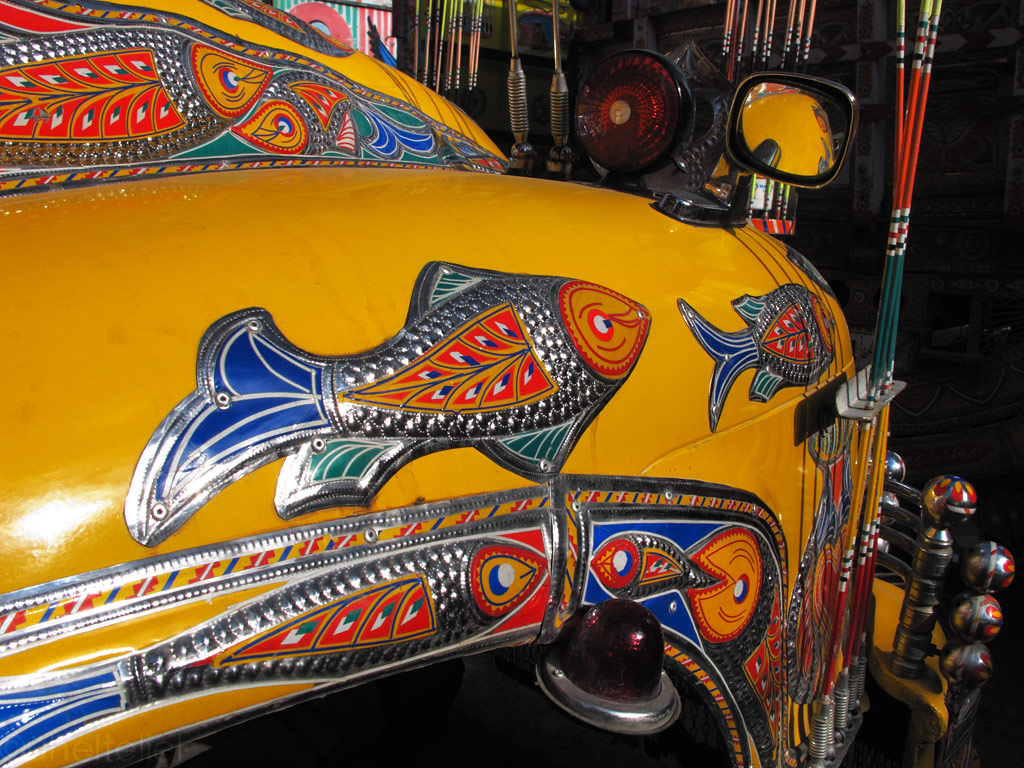
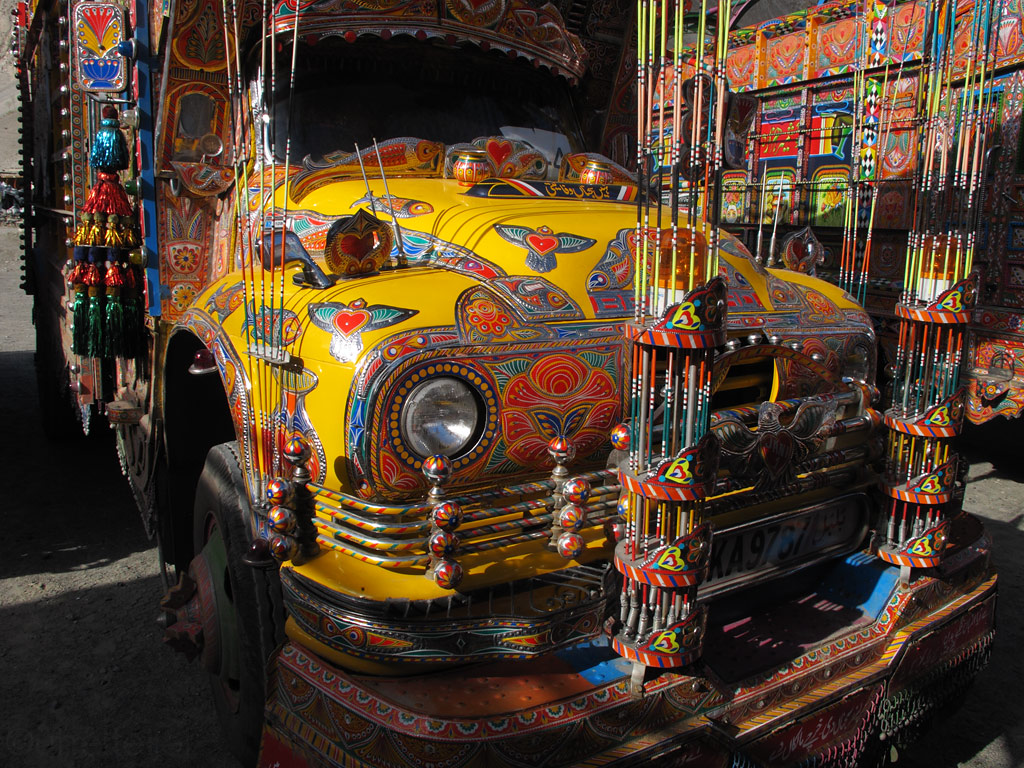
But aside the trucks, not all was so cheerful in Skardu. Soon after the road was blocked, the town ran out of fuel, and it only took a couple of days to run out of chicken and eggs, too. Our main concern, however, was how to get out. We spent countless hours at the local airport, at the local tourism office and the government offices, and after a full week of hassles, with the help from Allah (there were quite many praying for us in Skardu) we were finally back in Islamabad.
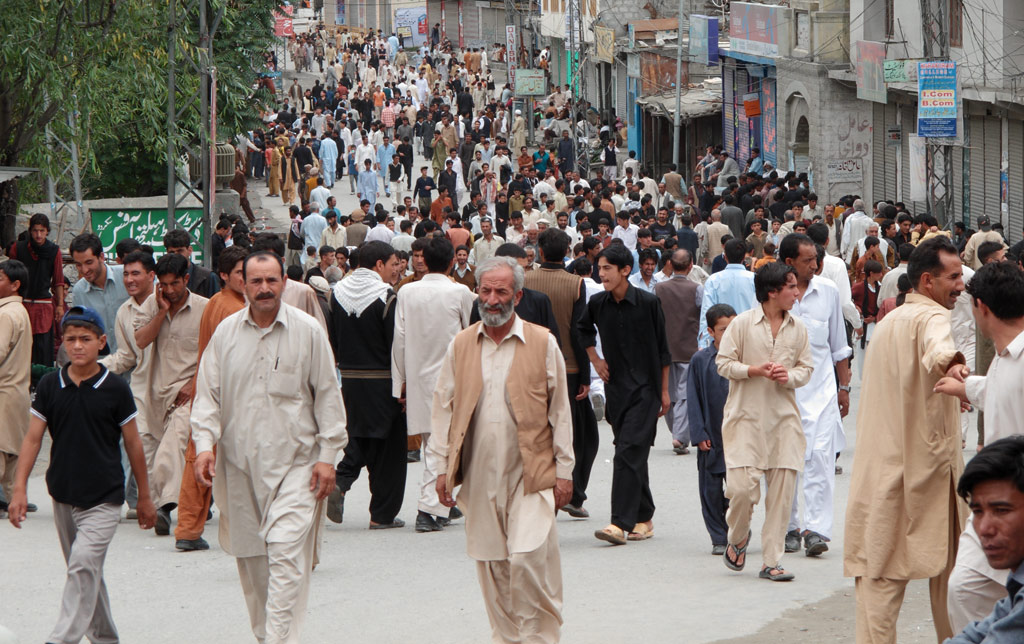
Just a brief reminder from Skardu - how many women do you see on the street? Hence everybody stared at Kariina every time we walked around.
So, first the bike. Sure enough there was no other option than to put the bike on a passenger airplane. Impossible in the developed world, because it is considered dangerous cargo, but who cares, this is Pakistan! We removed everything we could (panniers, of course, and the windshield, but also the front wheel) from the bike in order for it to squeeze through the tiny cargo hold door some 110 cm high and 85 cm wide, but still there was a doubt if it would fit. After some three days of anxious waiting for the weather to clear (landing and taking off amidst Karakoram's mountaneous landscape is no easy feat, so it is no rare case for aircraft to go back where it came from without landing in Skardu just because it is cloudy), the plane came and took our bike. We felt deeply relieved.
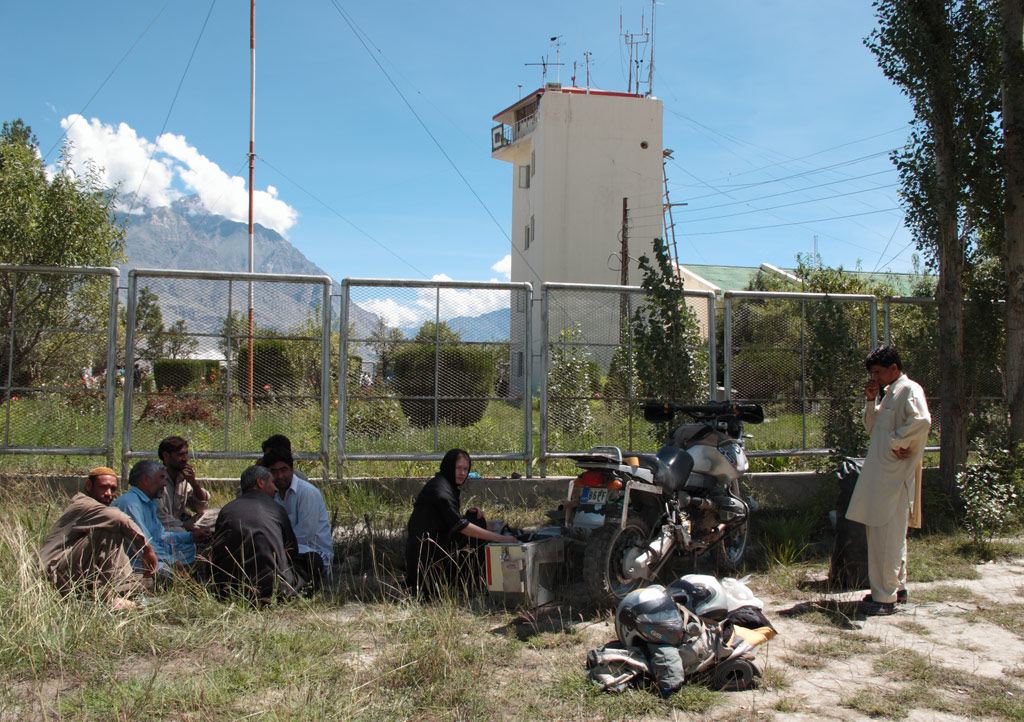
Unpacking at the airport's bush.
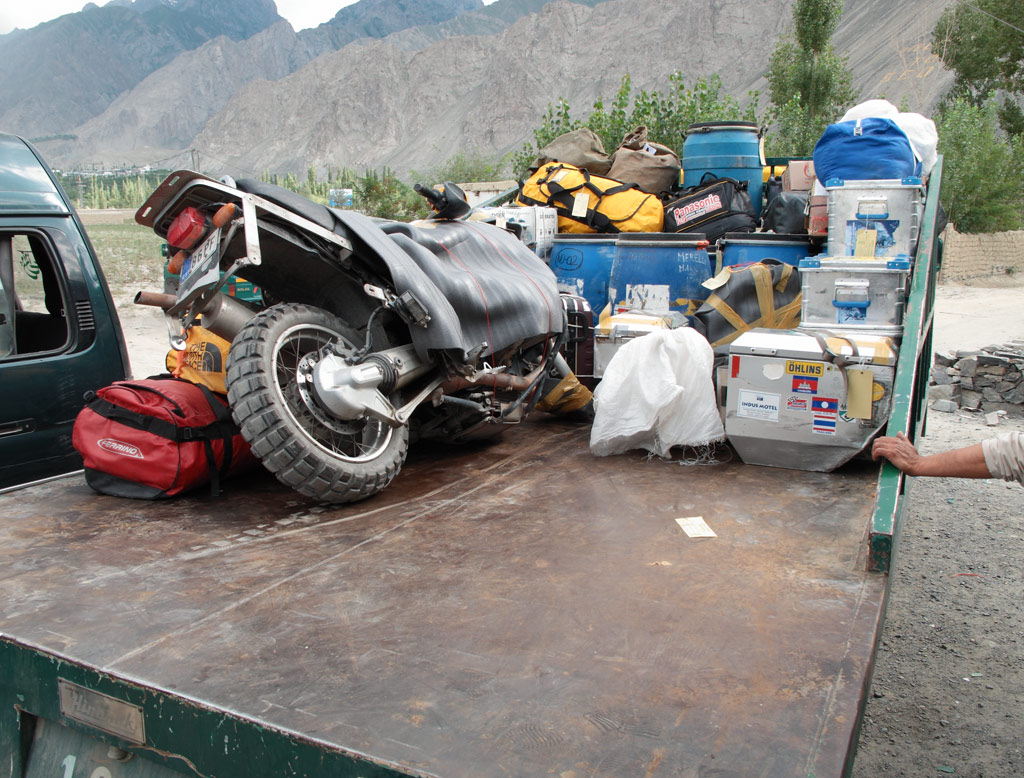
W/o front wheel goes to the plane.
It was time to get ourseves to Islamabad, too. Due to bad weather only some 1/3 of scheduled flights were leaving Skardu, so the waiting list was terribly long. We could have waited for weeks, but since everyone in Pakistan seems to have a close relationship with some high ranking chap, we were put, with the much needed help from an airport maintenance guy, on a list of people requiring quick way out of Skardu - by a military airplane!
To be clear, it turned out to be there were quite many people "in distress" or just grabbing the opportunity for a free ride, so when the mighty C-130 arrived (after having been delayed first due to technical problems, and then by some clouds in the sky) and had been boarded, the huge cargo hold looked like some cattle wagon, with people sitting on the floor, and the bags and each other. Luckily it was only an hour long flight, so it did not really become uncomfortable. We arrived safe and sound, praising the Pakistan Air Force.
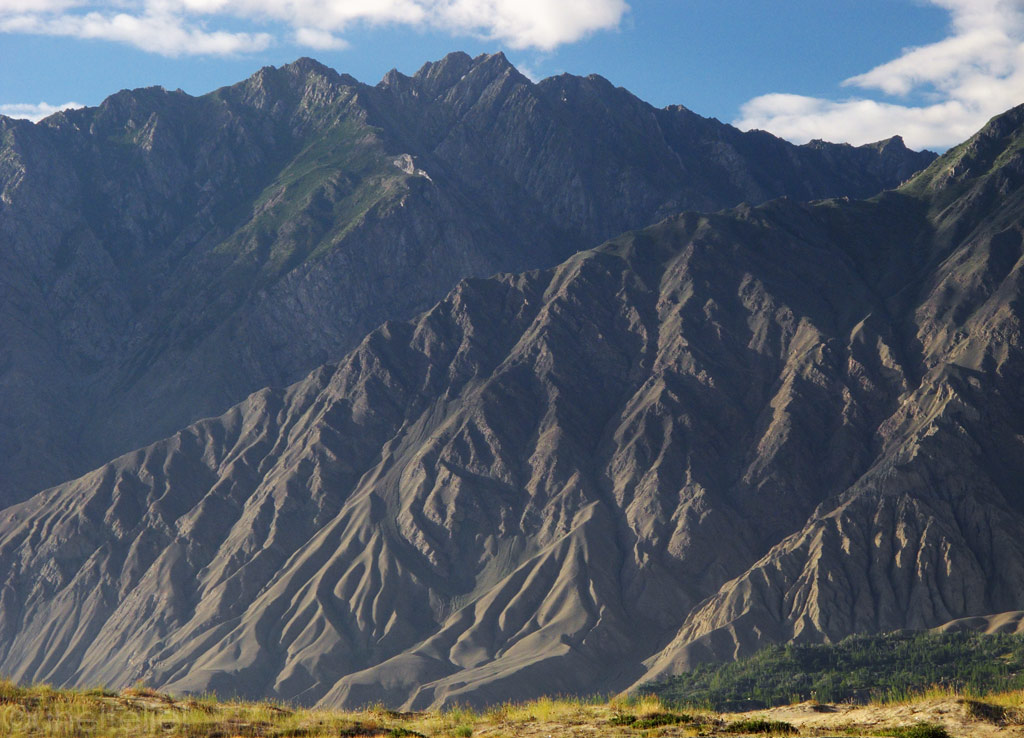
Some pics from the Karakoram mountains around Skardu airfield.
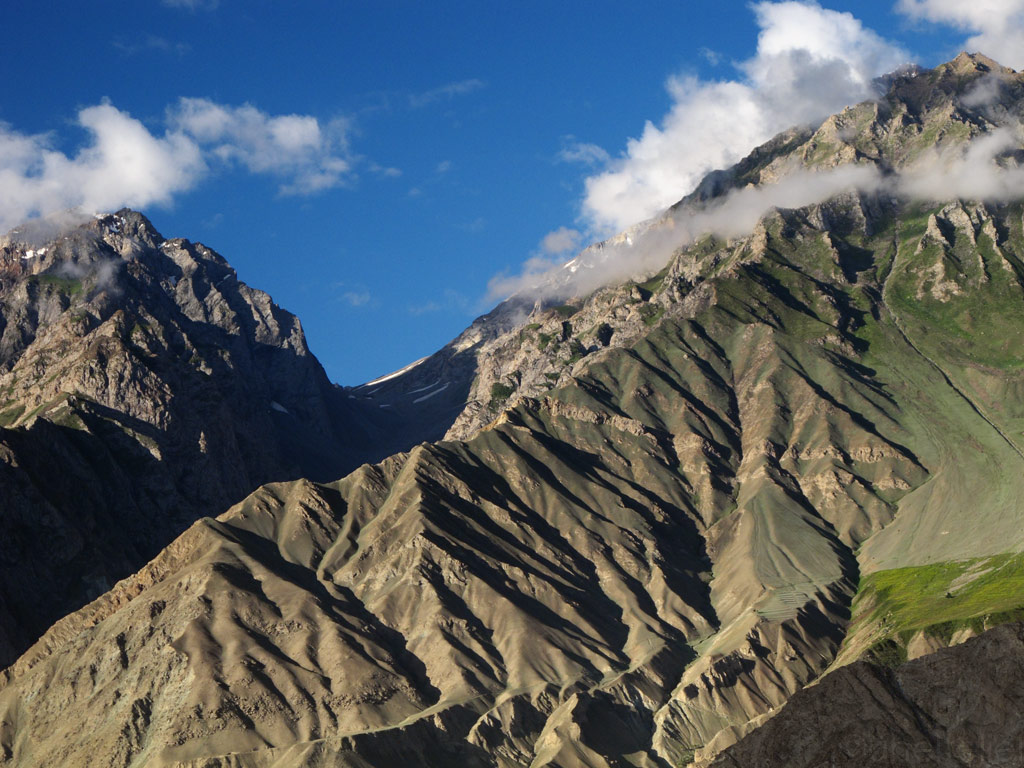
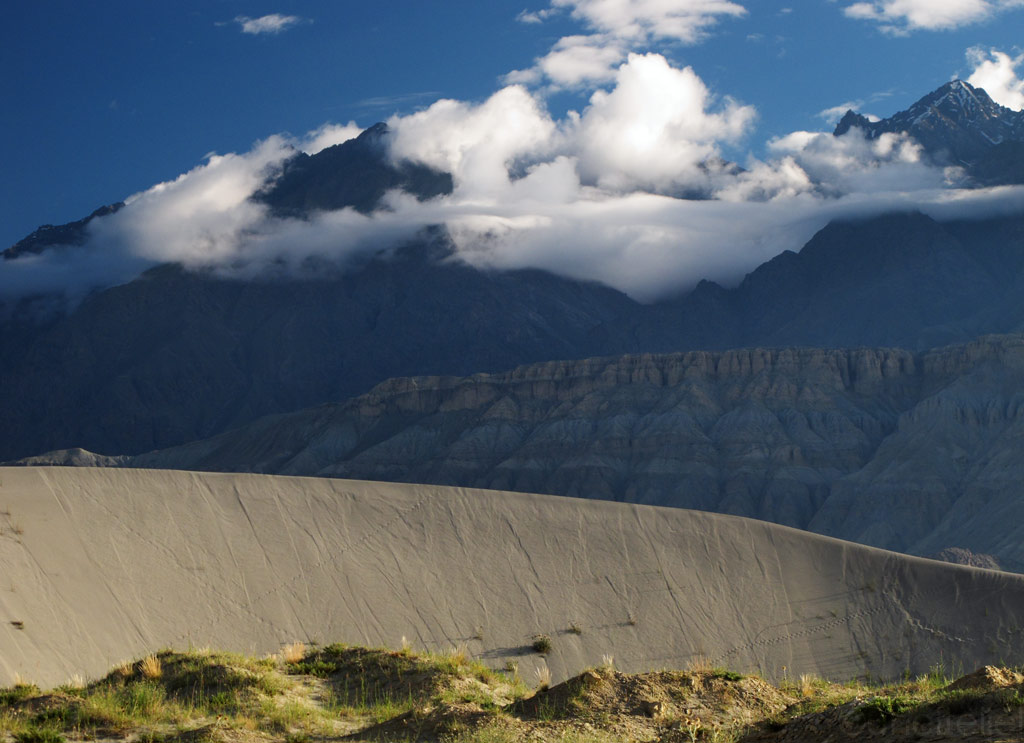
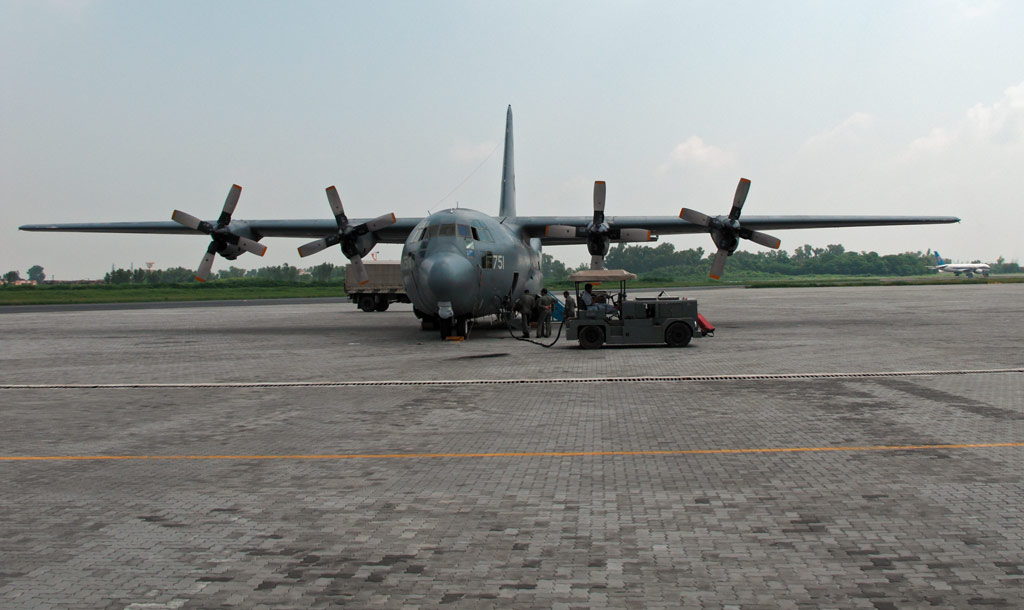
Pakistani Airforce C-130 Hercules that took us on.
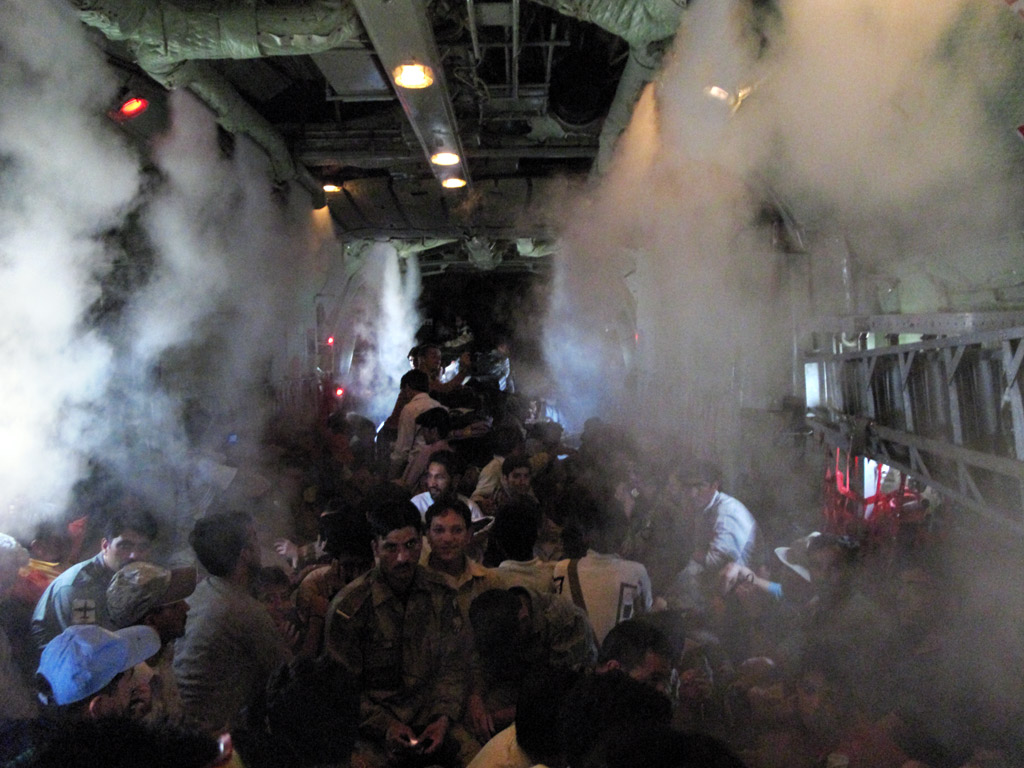
Without any real ventilation, the flight was "exotic" to say the least...
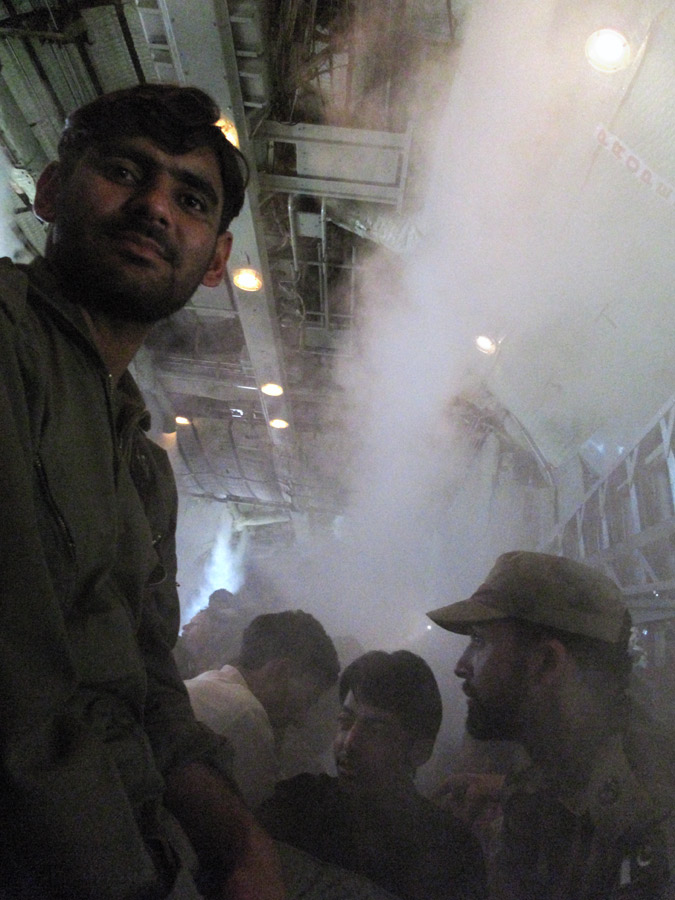
With Pakistani soldiers.
Then we went to get our bike which had obviously been thrown around a bit as the seat was ripped, there were some scratches here and there, and there was a small oli leak from the cylinder. But what do you expect if you only pay USD 75 for the air-lift service!
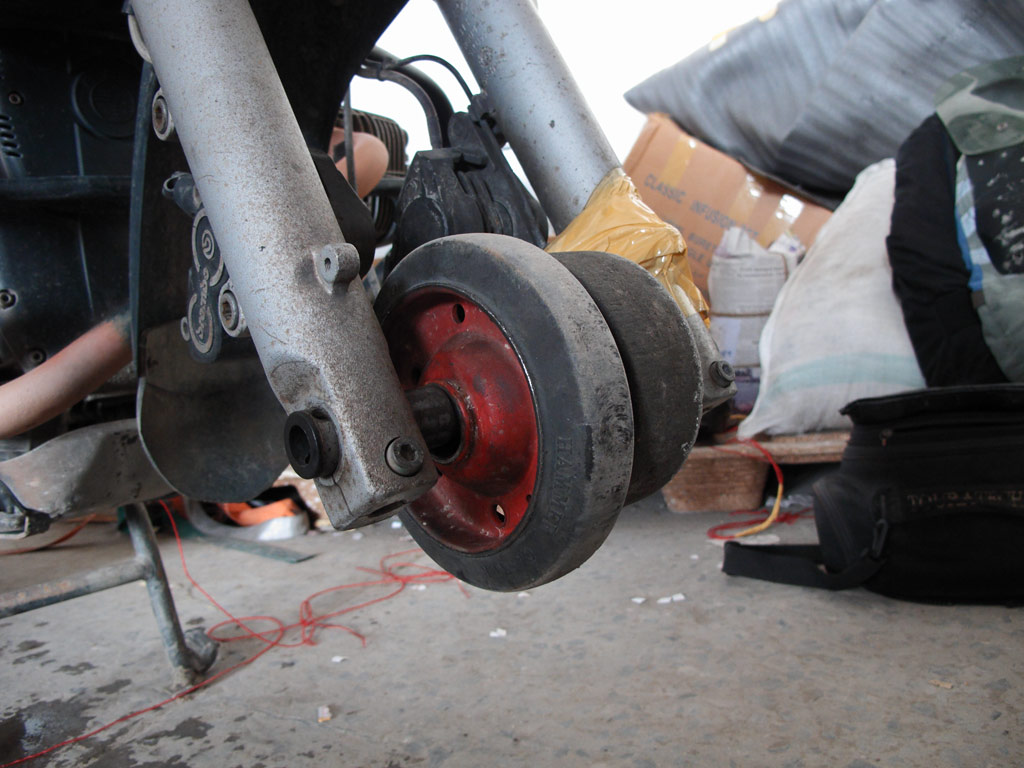
Improvised a small front wheel to drag our heavy bike around.
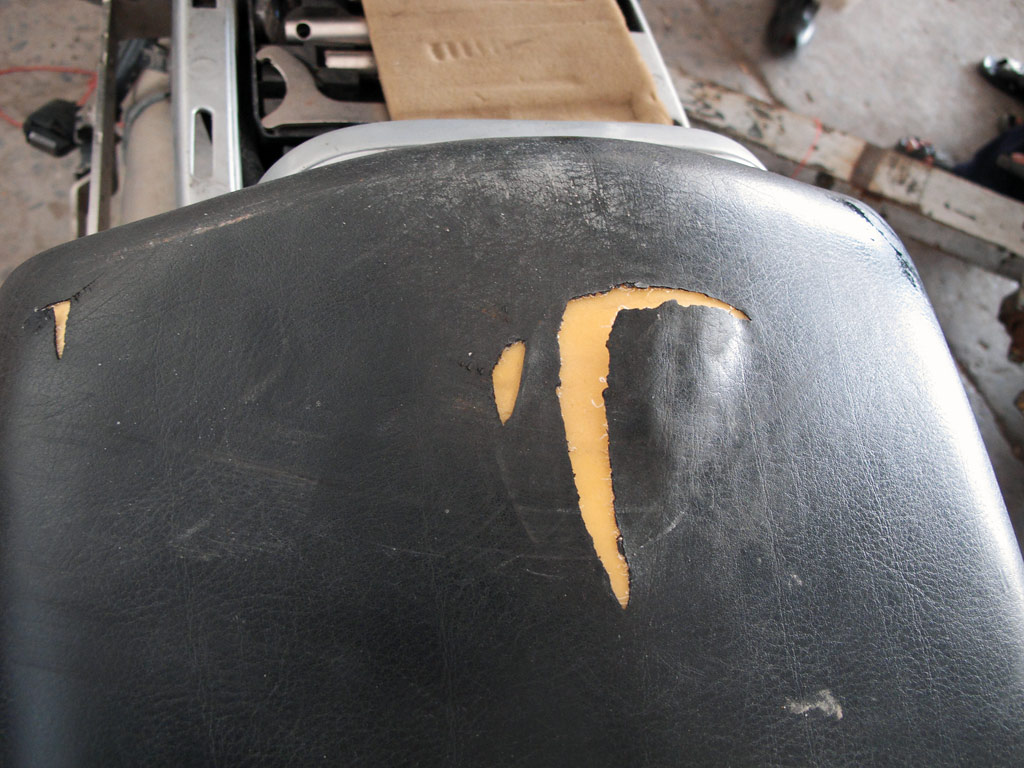
Broken seat after the transport.
So we were back in Islamabad, but our miseries did not end with getting there. With our visas already expired, the Carnet expiring and roads to Iran either too dangerous, off limits to foreigners, or simply washed away, all we could do was repeating to ourselves that this is all part of adventure and that it will make a good story to tell to our grandchildren one day. But before we had to get out of this sticky situation.
As what ever we could do was interrupted by the weekend, to get our minds off the things a little we went to see Malik Bashir, a guy who's also been mentioned on the HUBB as a reliable mechanic. A broken shock is a too big thing to fix in Pakistan, of course, but we got the frame straightened a bit, and did some minor repairs. A decent guy!
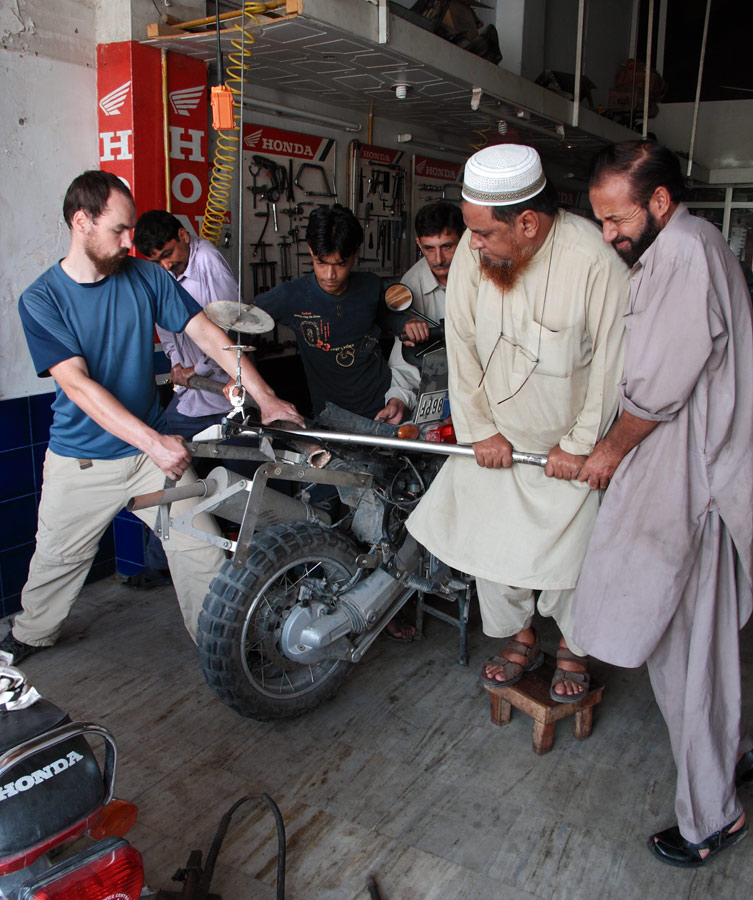
Straightening frame with six men.
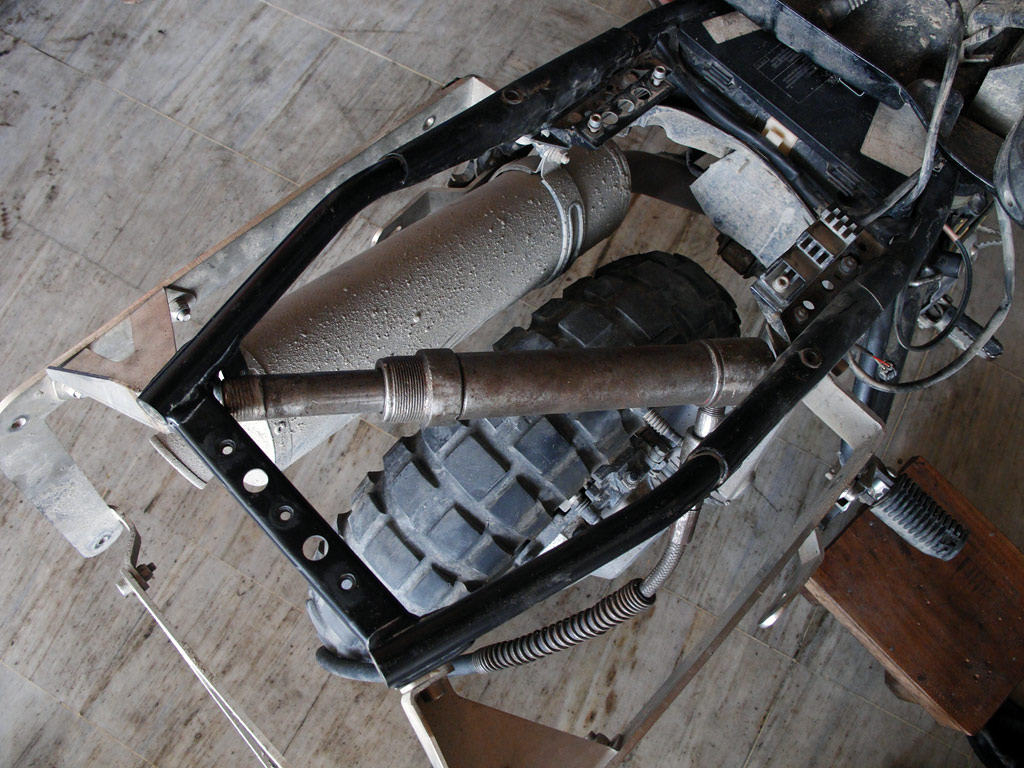
Sideways straightening with hydraulics. Also had to strenghten the front frame. Didn't get everything ideal, but a lot better than it was.
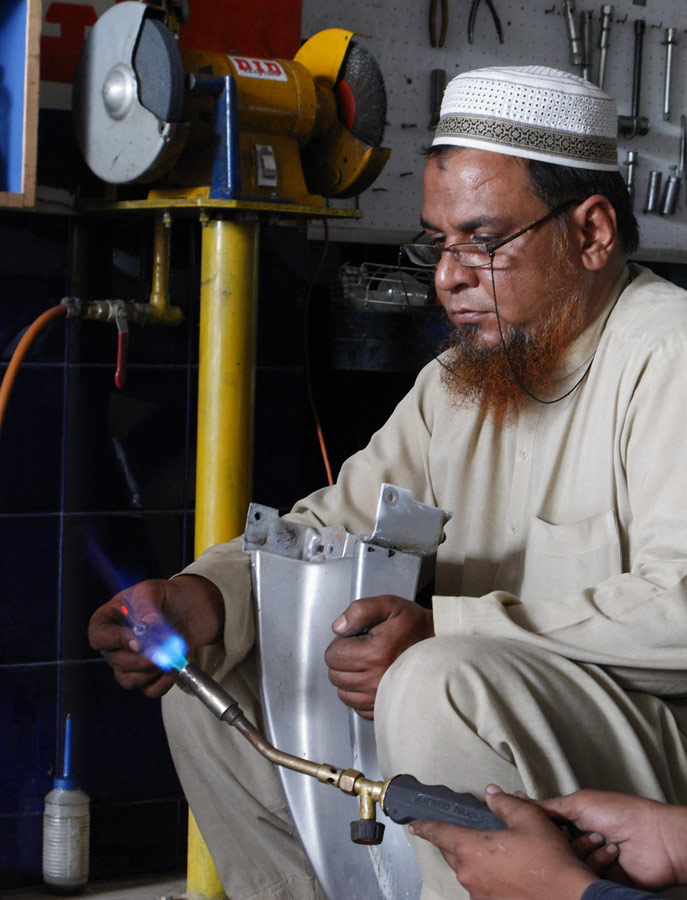
Malik repairing our cracked GS beak.
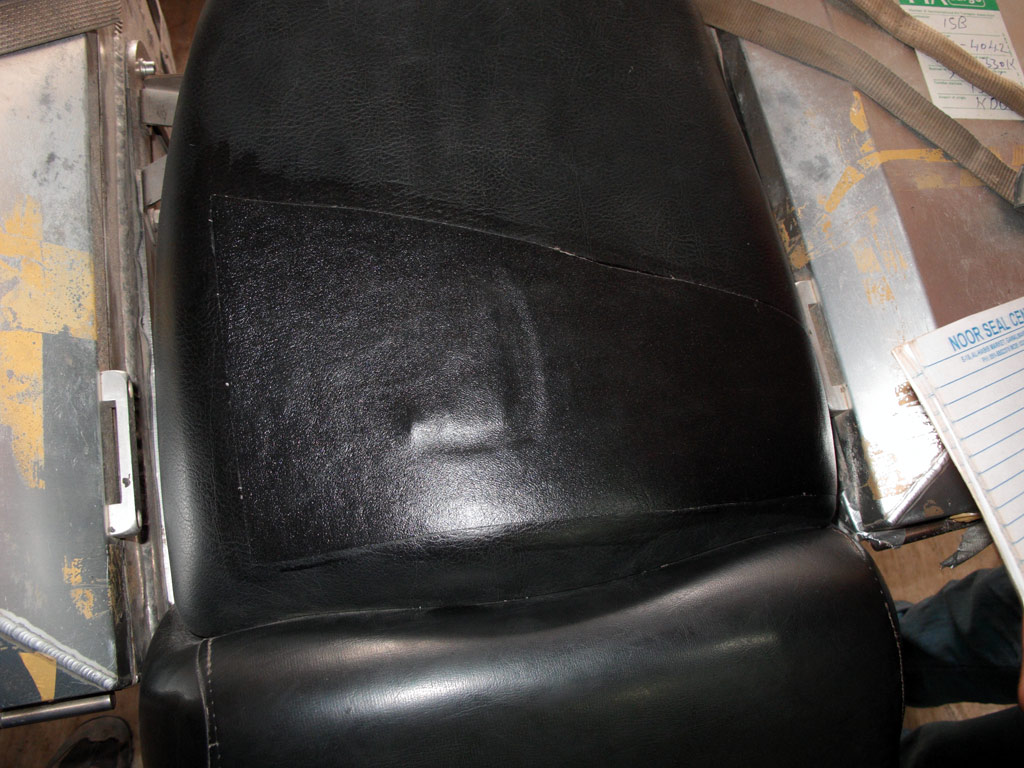
Patched up a broken seat.
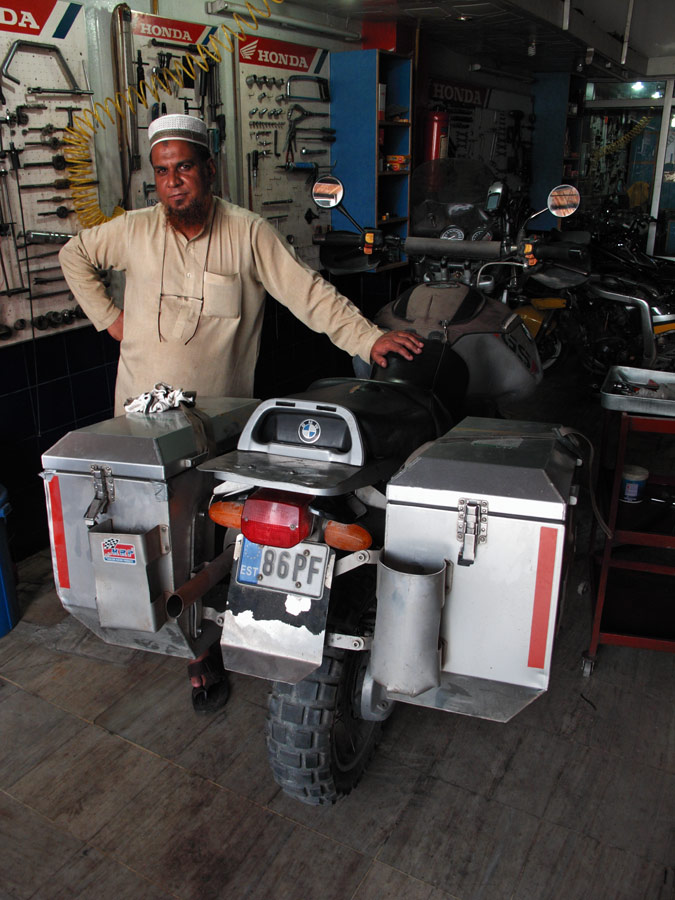
Malik with our GS which he liked a lot to work on - a rare day in Pakistan with 99,99% of the bikes being less than 400cc.
The weekend ended and we agreed that we would try to get to Iran, no matter what. We did our research and paid a visit to the tourist information centre to get the latest updates on the road conditions. We once even thought of putting the bike on a train to get across the floods, but the tracks too appeared to be under water. The one and only way seemed to be to go as far south as Karachi (as the road from Islamabad to Karachi had supposedly not been affected by the flood), and from there to Quetta. From there it is only some 650 km to the Iranian border. It wasn't a very appealing option as it meant a huge detour (with our swinging rear end!) in the heat of the plains, and hundreds of kilometers riding through unstable Balochistan in order to avoid the flooded areas.
With only a week left on our Carnet, and some 3000 kilometers to cover, we agreed that we have to do it. Then, somehow, it appeared to us that, just in case, we should try and ask the national air company it it would be possible to fly the bike to Quetta instead - this would save the bike from quite some bump, and also would give us more time to reach the border. They had done it once, so why not again?! The answer was positive, and before we knew, the GS was packed and ready for another flight. Luckily, there is a bigger Airbus airplane flying to Quetta couple of times a week, so we did not even have to take the front wheel off, which was good indeed.
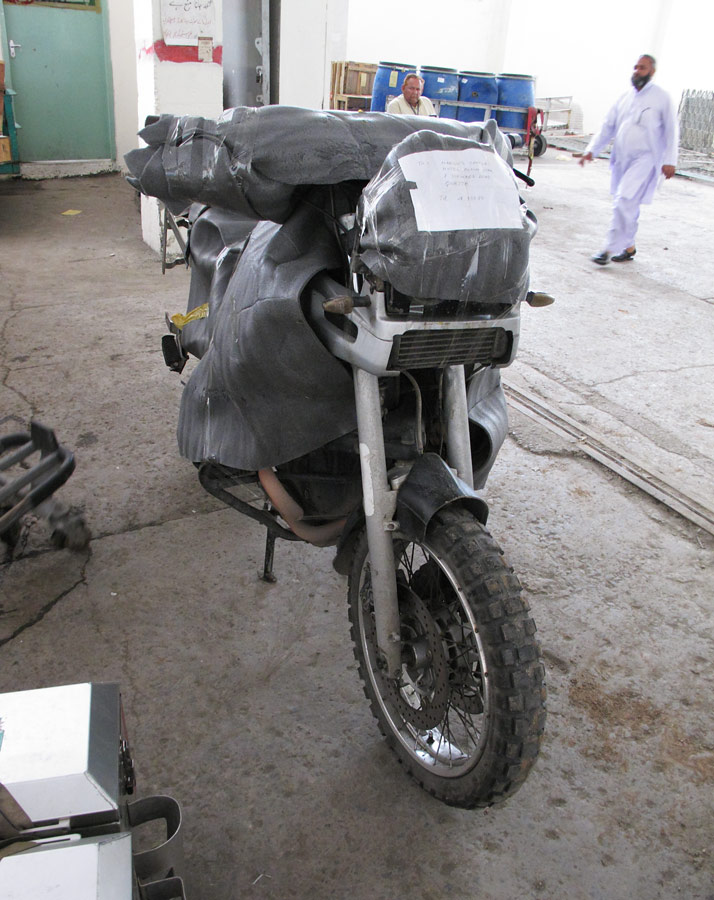
Our bike ready to fly across the flooded areas in Pakistan.
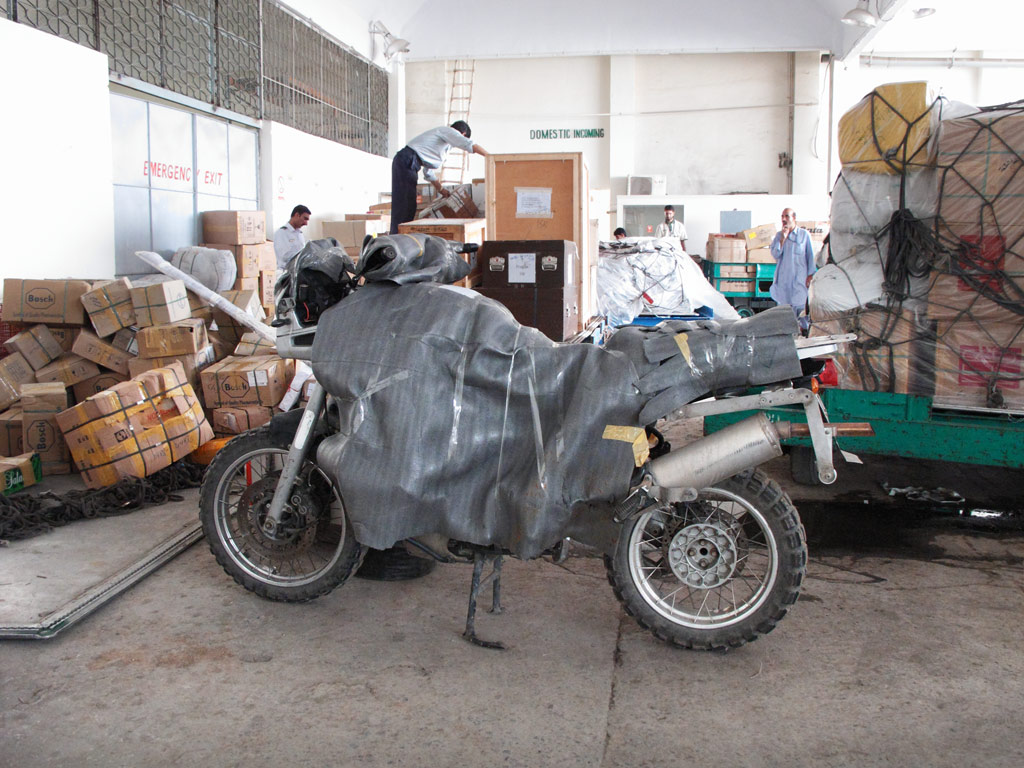
It has to fit on the plane with all that stuff.
By the way, with air tickets in hand, we got our visas extended in mere two hours in the Islamabad's passport office, and we could fly off.
We landed in the desert town of Quetta in a thick red cloud of dust. It definitely is a totally different scene from what we had seen elsewhere in Pakistan. Without much hassle we received the bike and all the luggage - thet had been travelling with us on the same airplane - and found a place to stay for the night.
Quetta does not seem so wild or dangerous as you would expect from the biggest town of Balochistan which is influenced both by action in Afghanistan and the independence movement in the Balochi province itself, but the fact that there are too many gun shops there, and especially the fact that we as white foreigners were strictly banned from going out of our hotel after 6PM, did not make us feel extremely secure either.
When we finally started our journey towards Iranian border, we first had to deal with the incompetency of the mandatory escort service. Even before we got out of town we had to change escorts for three times, and every time we had to wait for the new one ot arrive amidst the curious crowds. I do not know much about escorting, but somehow I feel this is not the way an efficient escort should work.
Once we were left to wait for our next escort at a toll plaza, where a potentially dangerous situation was developing - some guy had a disagreement with the cashier as to how much he should be paying, and suddenly the crowd gathered and started blocking the road. The military, armed with machine guns, already started walking towards the crowd, loading their weapons at the same time (one guy loading his "pump" gun with that specific hand movement, others taking off lock buttons on their AK-47s - a heat up moment like in a Hollywood action film!), as we exchanged terrified looks and subconciously understood that we've already had too much bad experience in Pakistan, now this all was getting into true overkill side in our heads - it's definitely not a normal country. Right at this moment, our escort arrived and we quickly rode off into the horizon without looking back.
Some pics from the road to the Iranian border:
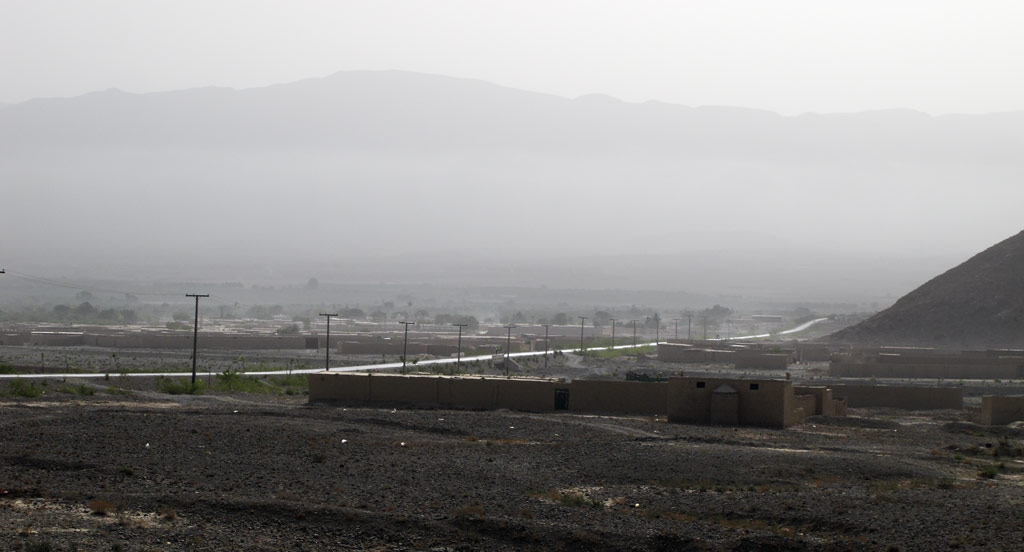
Quetta, Balochistan.
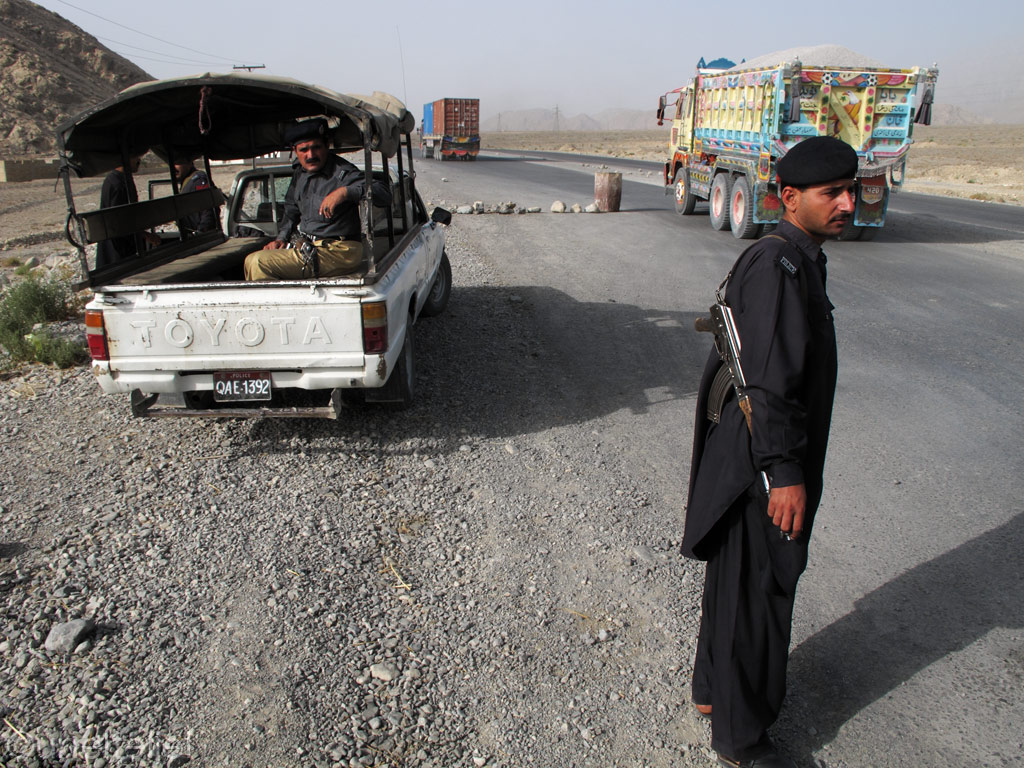
One of our many escorts in Pakistan.
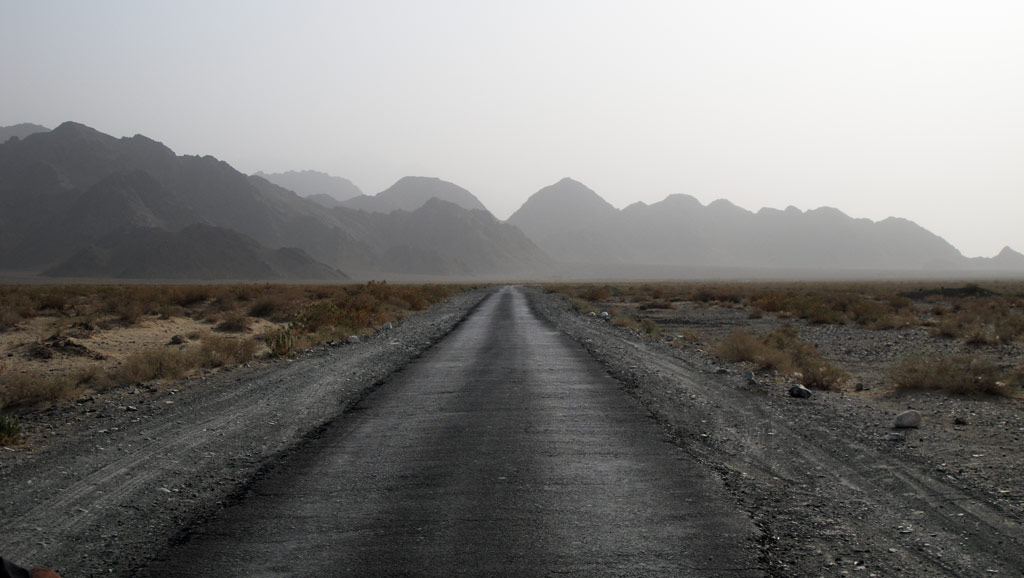
Road through Balochistan's desert.
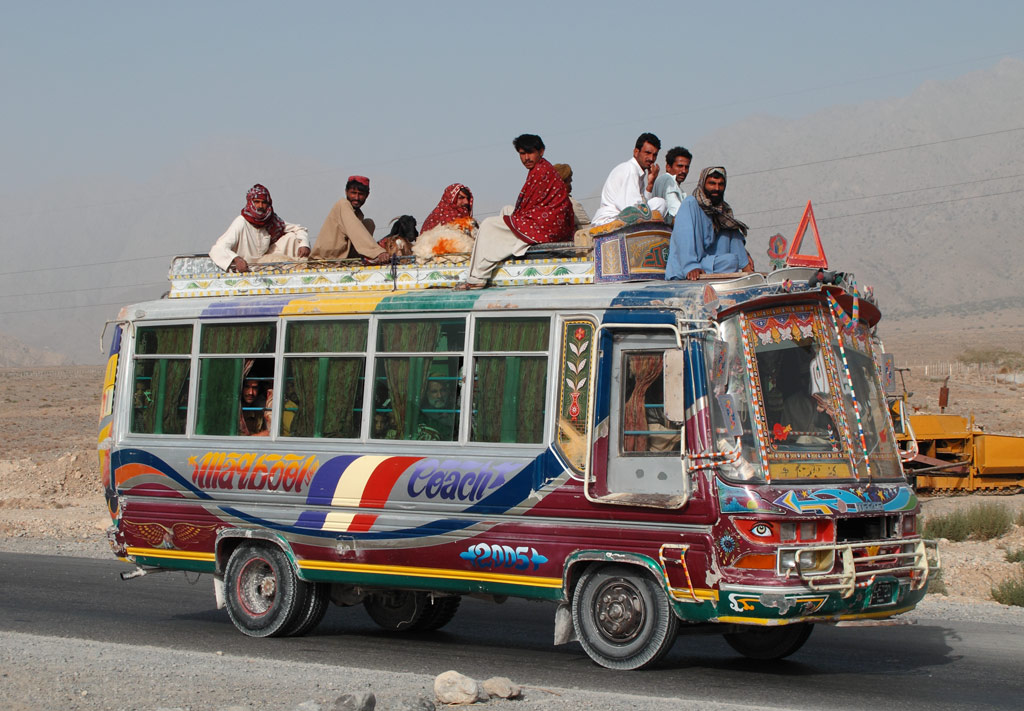
Buses work effectively in Balochistan...
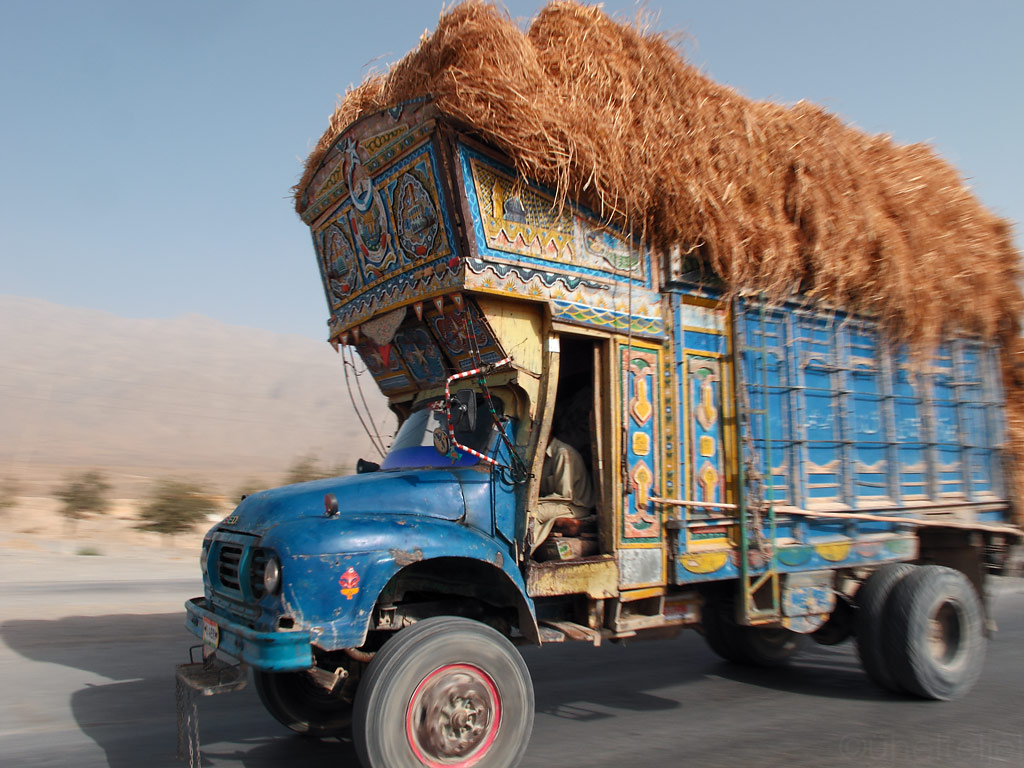
Delivering hay into desert.
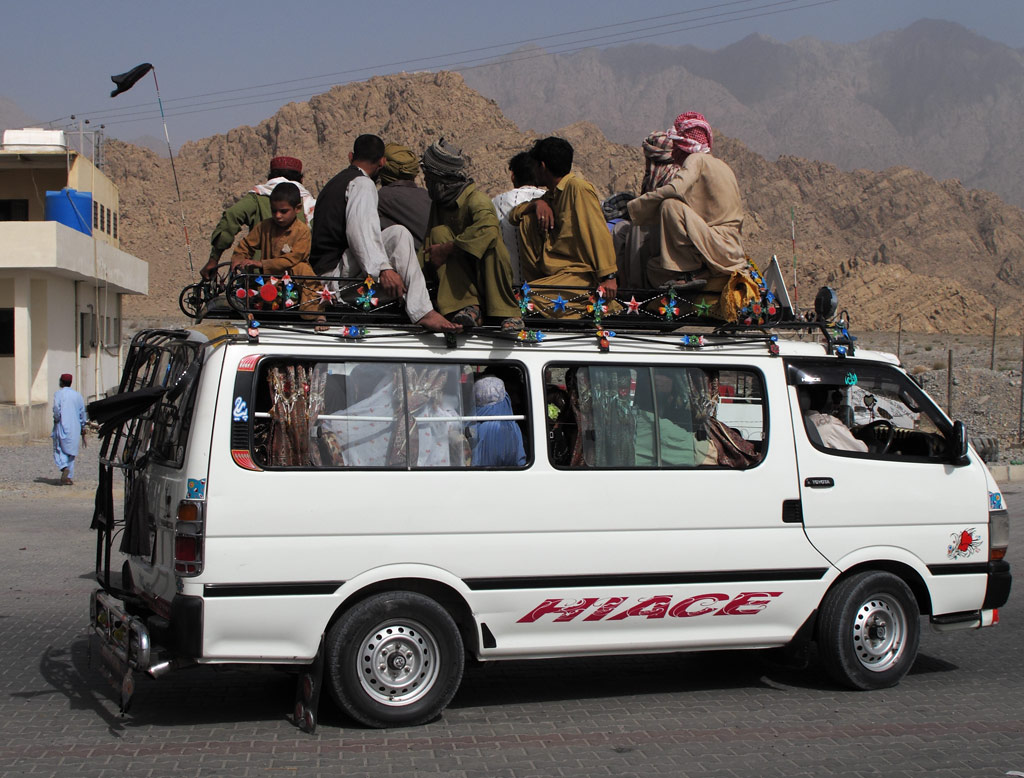
And those crowded small buses run 80mph, must be a lot of fun being on the ceiling without any safety support :lol3
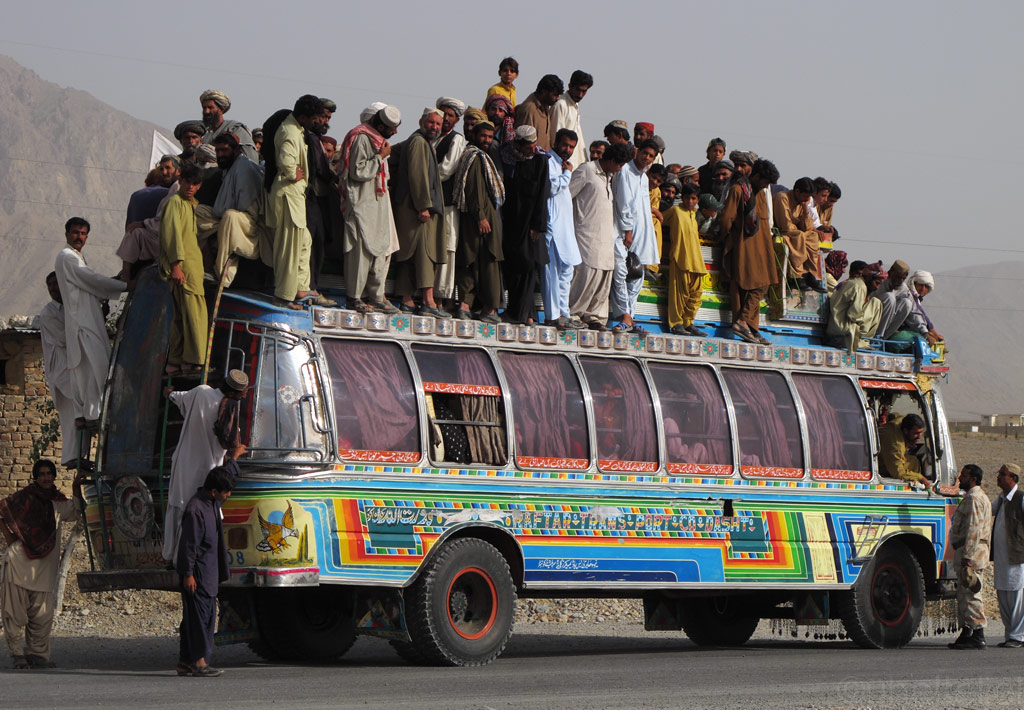
Excuse me, is there a still room for me?
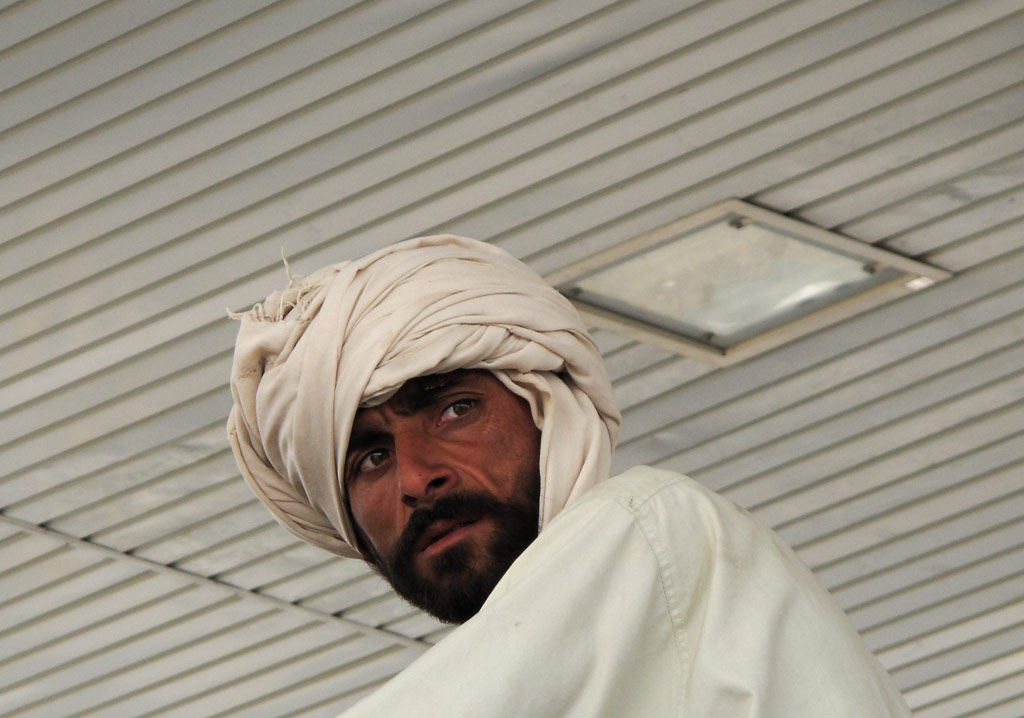
Balochi man.
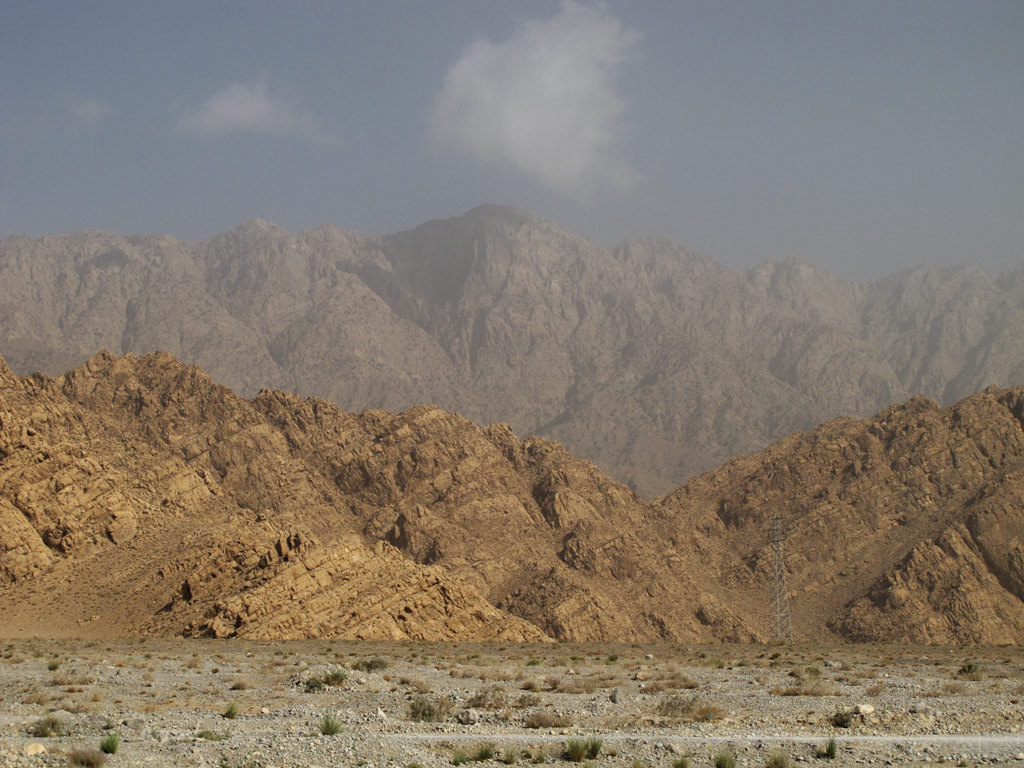
Landscape.
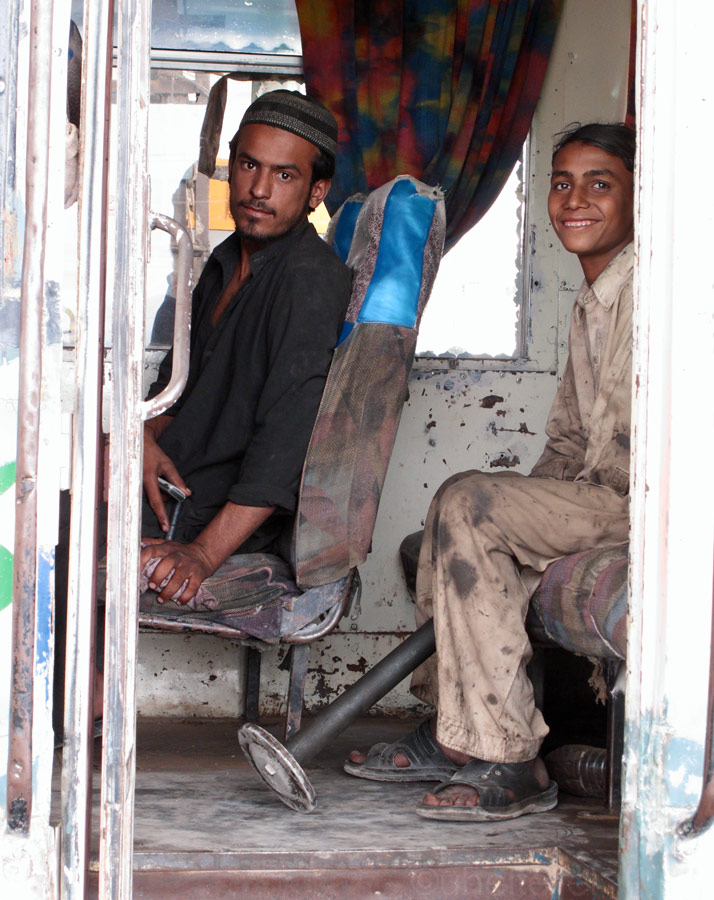
Young Balochi men in transit.
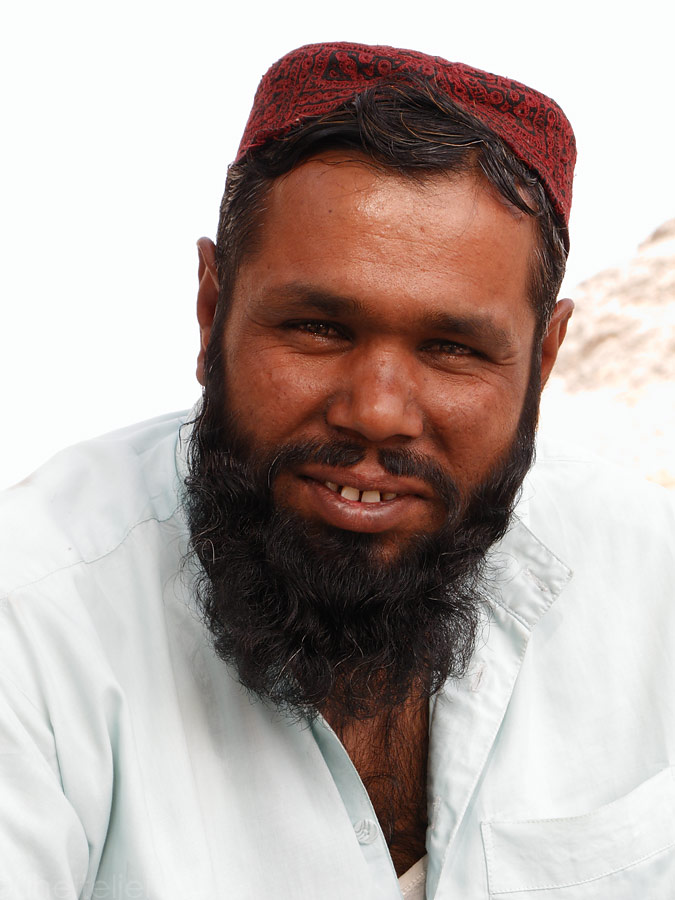
Balochi muslims...
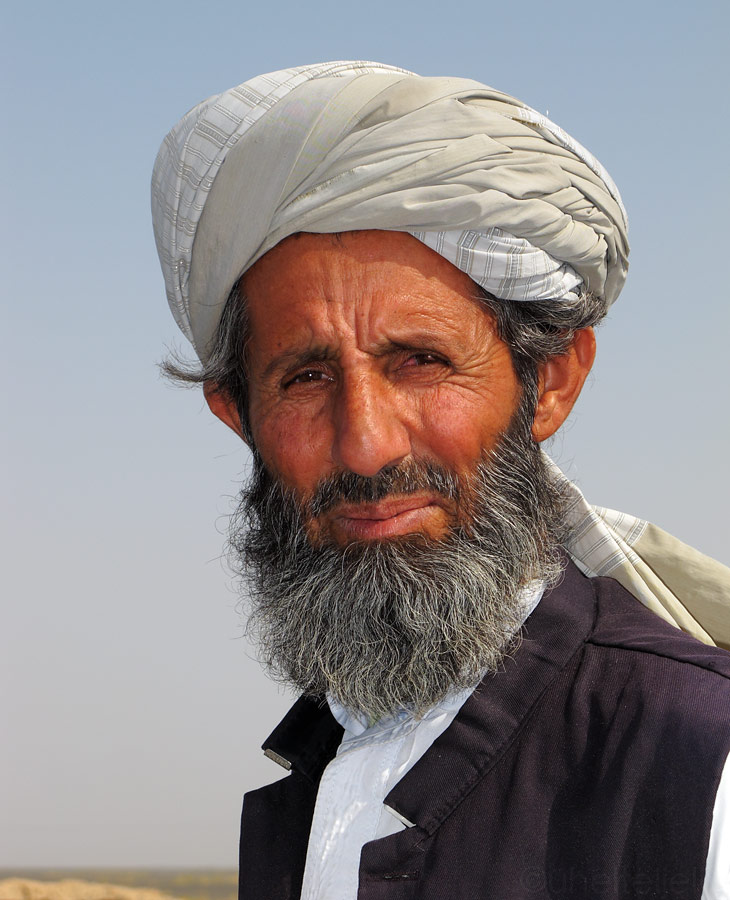
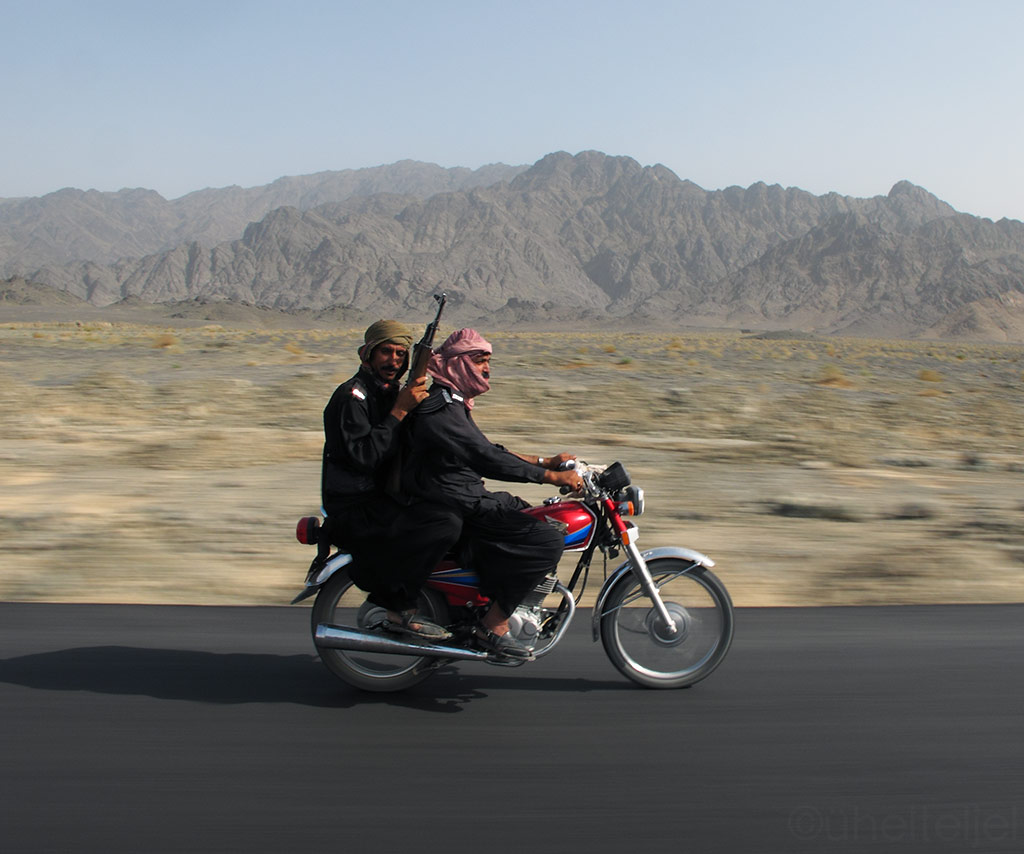
One time we had to ride with an motorcycle escort - a lot better except the little Honda didn't go above 37 mph on straight desert roads.
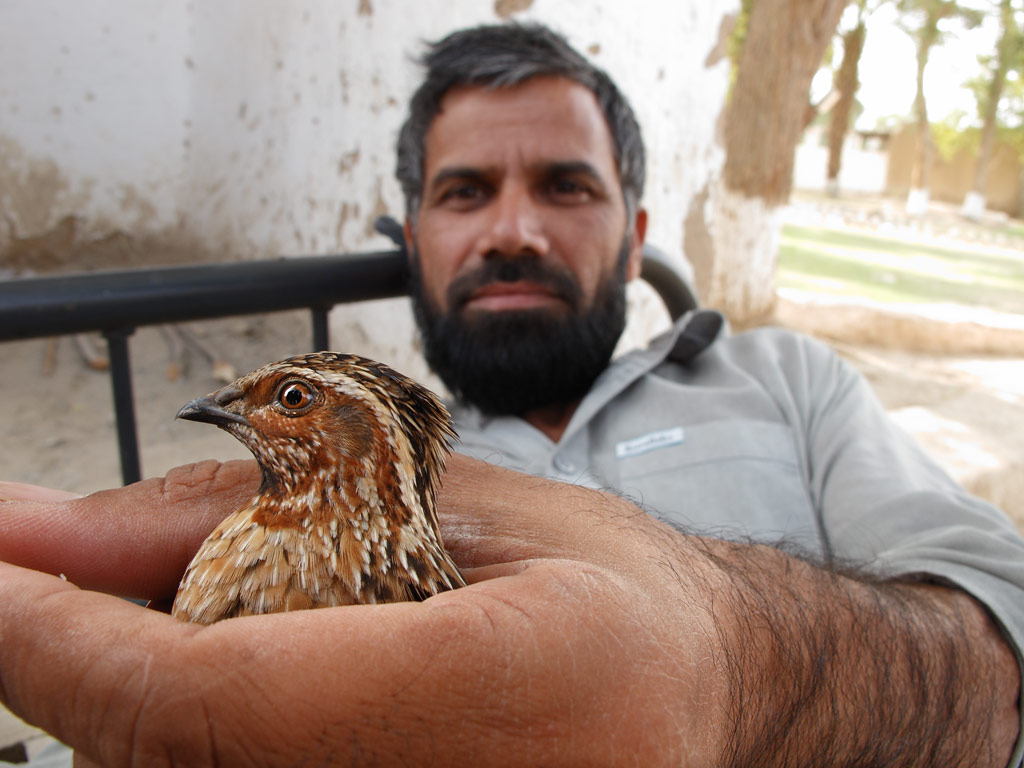
Policeman with a bird in his hand - he was saying something about dinner...
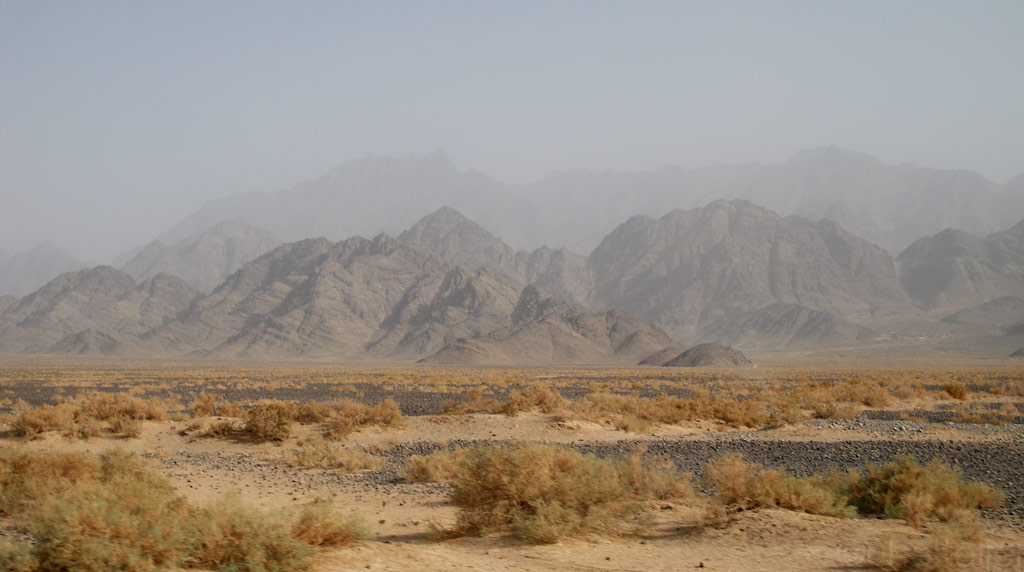
Balochistan.
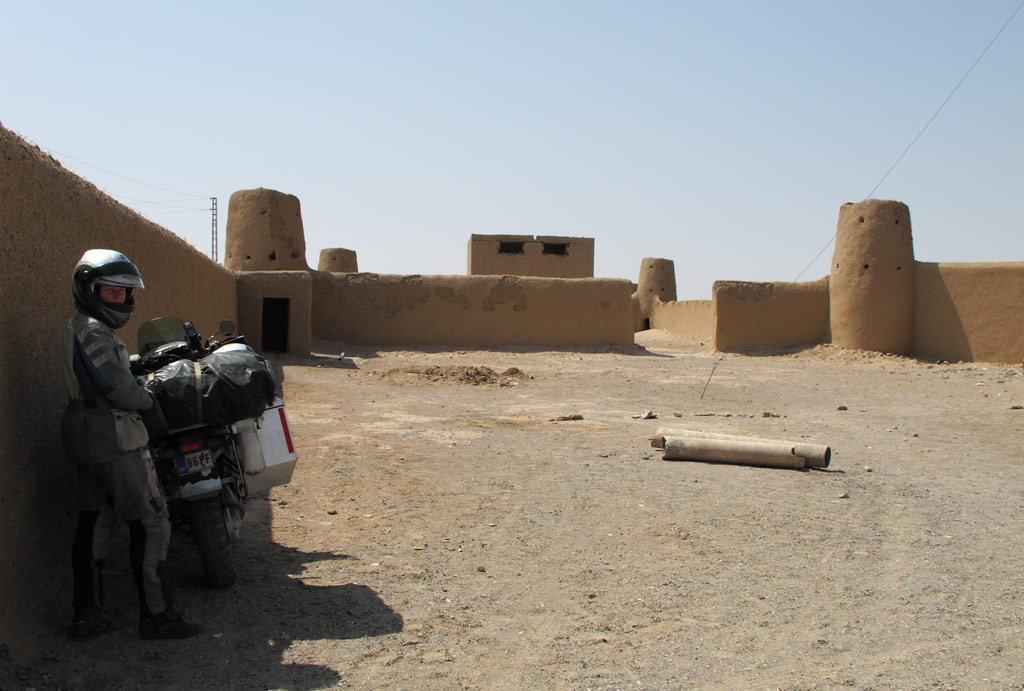
Police station in Balochi desert - the towers are for gunmen.
On the Iranian side, once again an escort was forced upon us, but except for the one case when we had to chase a taxi with an unarmed young soldier who was holding our passports (and they call it an escort!), the escorts in Iran were much more efficient than in Pakistan. I mean, many travellers tell about their nightmare like experiences with rude, plain clothes escorts in Iran, but mostly we were riding behind or in front of a police car full of armed-to-the-teeth soldiers. Not too bad.
Some pics from the Iranian side:
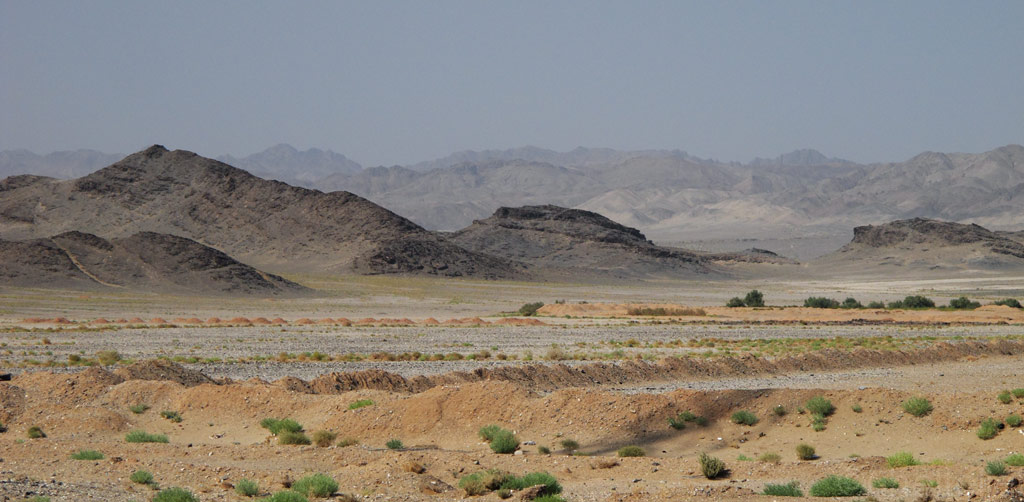
Landscape on Iranian side.
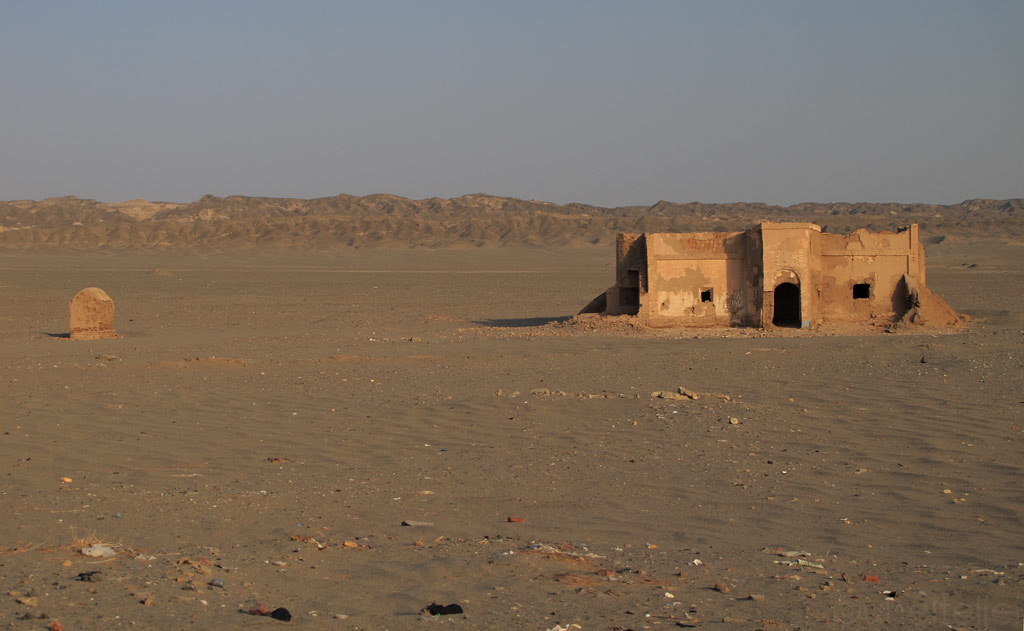
Abandoned buildings in the desert.
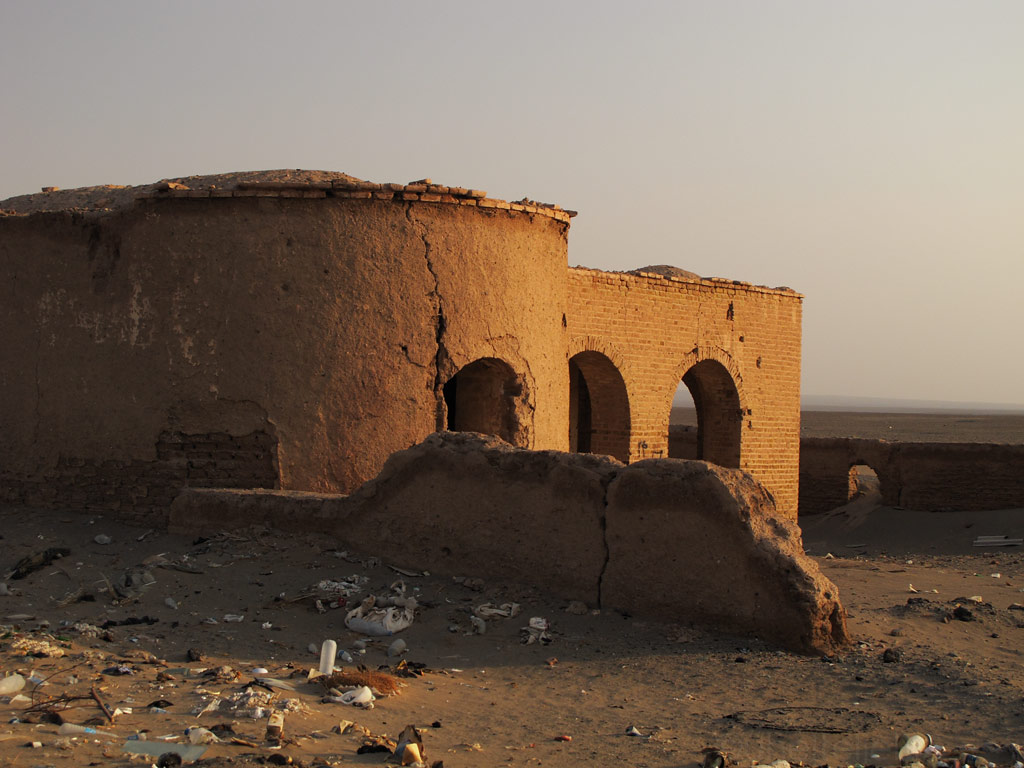
It took a while, and we had to sacrifice quite some nerves, but we have cleared the trouble, at least in some measure, and at least for a while. The shock does not feel too bad on smooth tarmac, so with some luck, we should be able to make it to Dubai where we hope to switch to some more reliable solution than the trusty rubber filling.
It feels good to be back in Iran, the country which inspired us in the first place to start planning for this RTW expedition, but it feels strange at the same time. More in the coming post!
With no power there was not much to do, so we decided to get acquainted with local life at the market. Here are some pics and vids of the goings on.

Boy working at bakery.

Selling tea at the bazaar

Trading routes through the near neighbour - Afghanistan.

Want a cuppa?

Merchants and customers


Spice shop

Gilgit muslims...


<object width="640" height="505"><param name="movie" value="http://www.youtube.com/v/vX1rUiW0yjs&hl=en_US&fs=1"></param><param name="allowFullScreen" value="true"></param><param name="allowscriptaccess" value="always"></param><embed src="http://www.youtube.com/v/vX1rUiW0yjs&hl=en_US&fs=1" type="application/x-shockwave-flash" allowscriptaccess="always" allowfullscreen="true" width="640" height="505"></embed></object>
Selling live chicken by the weight. Where is the GreenPeace?

<object width="640" height="505"><param name="movie" value="http://www.youtube.com/v/uCq2HIxpVAI&hl=en_US&fs=1"></param><param name="allowFullScreen" value="true"></param><param name="allowscriptaccess" value="always"></param><embed src="http://www.youtube.com/v/uCq2HIxpVAI&hl=en_US&fs=1" type="application/x-shockwave-flash" allowscriptaccess="always" allowfullscreen="true" width="640" height="505"></embed></object>
Tasty naan bread in the making. Check out the tandoori oven!
Our Iran visa applications still pending (three weeks already!), we decided to spend some time in the area known as Baltistan. On our road there we were accompanied by the mighty Indus, changing its face from fast and furious to slow and serene.

Road to Skardu is mostly cut into rock, the raging Indus river below - hard to believe the same river right now is causing devastating floods in the South of Pakistan.

Indus goes into wide and "silent" mood near Skardu.

Reflections.
The main reason for going to Baltistan was to get a glimpse of K2, the second highest mountain in the world. One might think that it is an awkward name for one of the highest points on our planet, but the thing is that it is so remote (not even visible from any village) that until recently it did not have a name at all. It was in 1856 that Thomas Montgomerie undertook a survey and charted the highest peaks of the Karakoram range. The nearest neighbours of K2 were marked down as K1, K3, K4 and K5, but were later renamed Masherbrum, Broad Peak, Gasherbrum I and Gasherbrum II respectively, using their native names as a basis.
Located right on the border of China and Pakistan, the densest area of high peaks and glaciers in the World, this 8611 metre (28 251 ft) mountain is difficult to access (and even more difficult to ascend - till now only 302 people have made it to the top, compared to more than four thousand that have summited Mt Everest). Even to get a distant view of it, one has to abandon the wheels and do some trekking.
To get to the right point we first rode as far east as we possibly could. Since Baltistan is basically a disputed territory (administered by Pakistan, claimed by India), there is quite a lot of military presence, and foreigners are not allowed anywhere near the so-called Line of Control. It is interesting to note that at some point we were as close to Kargil (where we passed some two months earlier) as some 60 kilometers (40 miles), so one could say we had not progressed too much on our route. In the very eastern part of the disputed territory lies the Siachen glacier, the very big thing clouding the relations between the two countries - Siachen is the highest battleground on Earth at 6000 meters. Soldiers fight in thick snow, extremely low oxygen environment, at 100 mph winds (bullets fly in unpredictable directions) and -50C (-60F) nights, fighting with avalanches and cervasses. Obviously the murderous extreme conditions has taken a lot more lives than the bullets from the enemy's guns.

(Military) road to Siachen area is strictly off limits to foreigners.
From there we turned north into Hushe valley, towards a village with the same name. This is where the road ends, if one can call it a road. This jeep track has it all - sand, water, mud, loose rocks, swinging bridges and irrigation ditches dug right across. It isn't long, but it definitely is torturous.

This is a good part of Hushe track.

Bridges are mostly made out of wood and are quite unstable and questionable.

This is the best bridge on the Hushe track.

Hushe village is in fact some 700 years old, although the timeless design of the houses there does not give many clues as to how old they might be. Mostly consisting of dry stone walls, they really do make you wonder how they manage to stand and not collapse. Wealthier families live in plastered houses.
The main sources of income for the 140 families living in Hushe are growing crops, livestock and tourism. Women take care of the fields and animals while men offer their services to mountain expeditions as guides, cooks and porters - here, it's one of the best access spots to the high Karakoram. Because of the political situation and US involvement in Pakistan, the last years have been very low in tourist numbers, so we mostly saw men chatting and sipping chai on the street, leaving a somewhat neglected feeling - they say this year only 30 expeditions have visited, yet last year the number was well over 90 teams that went to conquer the extreme high peaks in Karakoram. The setting of the village is, however, fabulous, with 7821 metre (25 659 ft) Masherbrum looming over the valley.

Views from Hushe...



Panorama of Masherbrum (click to enlarge)

7821 metre (25 659 ft) Masherbrum glows over Hushe

And cliffs that are hard to scale from the pictures...

Local brick factory.

Curious Hushe boys chekcing out our GS and following us everywhere we went in the village.

Sufi-muslim in Hushe.

Children.

Muslim with a child.


Hushe girl.
So, in order to get a glimpse of the K2, we hired a guide and took off for a trek. It took us some six hours of walking and scrambling along the steep, rocky slopes to get to the viewpoint, ascending some 1100 meters (3 600 ft). After this, our venture into the Ultar canyon in Karimabad really seemed like relaxation - this time it was uphill all the time, sometimes on all four. But most importantly - the higher we got, the broader were the views.

Trekking with our guide.

The guide giving explanations of everything - behind is Humbrok Peak.

Panorama from the trek (click to enlarge).

Some flora on the mountainsides - they blossom in August - summer here is short.


Kariina on the mountainside.

View to the Hushe valley from above.

Majestic Cigarette Peak - name comes from the fact that warm winds are always blowing loose snow from its sides - looks like a smoking cigarette.

At the end of the trek - our weary bodies need some rest now and pain in the legs is sure to come the next day.
And there it was, K2 (look in the centre of the picture, left of the sharp dark cone)! Far away, and only the top visible of course, but worth the effort - to get the full view of the K2, you need an over a week trek with special permits from Islamabad and special equipment and training for a bit more technical glacier travel (rope technique). So we were happy to get that rare glimpse to the K2 which is very hard to obtain anyway.

The mighty K2 (8611 m / 28 251 ft) peeking in the middle of the picture.

Panorama of the peaks from the viewpoint - find the sneaky K2 in the picture (click to enlarge).
Descending from the viewpoint, we set our camp in the seasonal village of Humbrok at around 4000 meters above sea level. Most of Hushe's women spend there the whole summer, herding the yak and the cows, and making butter and yoghurt. Younger ones assist by collecting dry wood and cow dung for fire. Living conditions are very simple - sleeping and cooking in stone huts, and washing in streams with ice cold water.
Our appearance was, of course, a big thing, especially among the girls. While our guide, Sher Ali (whom they also called Sherpa) was cooking us some rice, there were some ten little heads sticking in the stone hut doorway, observing the strange white people. Actually, the airflow of the hut was pretty much cut off by all the attention, so the smoke could not get out and we sat in a haze.

Humbrok village - only women and herd live here in the summer. Most of the year it's under snow.

Young girl carrying her brother.


Muslim girls in Humbrok - it took a whole day for them to take us as insiders so we could get a chance to take pictures of them - mostly Muslim women say straight NO to any picture taking of them.

Humbrok children.




Inside the stone hut.

Sherpa making us some chai.

And soon rice was cooked - tasted good after exhausting day trekking in the Karakoram.
It definitely was an experience, and one of the highlights of our stay in Pakistan - to watch the rice cooking in the dimly lit stone hut, and meanwhile to sip the chai made from fresh milk.
Next day as we headed down to Hushe, and sat on the bike for a ride back to civilization, we felt as if Pakistan had turned its smily face towards us. Until… just a little before we reached tarmac… the violent swinging of the rear brought back some old memories. The rear shock was blown, badly.

Not again!!!
It was phenomenal this time, the problem. It wasn't the main seal leaking, but the body itself had cracked, with inner seals peeking out. Never would have thought this could happen to a supposed-to-be high quality shock.
Not much left to do with this ingenious creation of Öhlins engineers, we headed to the nearest tyre shop and stuffed the thing with some rubber. Put some duct tape on it to keep the composition from disintegrating, and swinged (not so violently thanks to the rubber) back to Skardu. Even on the relatively smooth tarmac it felt like riding in a horse cart, with speed never exceeding 40 km/h.

Proper introductions first.

Cracked body of Öhlins shock. The world famous Swedish quality of metallurgy?


I put rubber between the spring to dampen the shaking.

Taped it up so the rubber doesn't jump out.
Farewell all our planned detours to Deosai Plains, Nanga Parbat base camp, Boroghil and Chitral, we now had to figure out what next, because this time the suspension damage was beyond repair, and having a new one shipped to Pakistan is costly to say the least. No easy solutions on this one.
So guess what - we were pretty much screwed!!!
Soon enough we discovered that we were actually stuck in Skardu - while we had been out having fun trekking and destroying our bike, there had been some landslides, and the road back to Islamabad was cut off with no one knowing for sure when it might reopen again. So there we sat, with a broken shock and expired visas (there is no way to extend them there, because obviously Estonia is not one of the 45 countries the citizens of which are entitled to apply for an extension here) - or you could say - illegally. Interesting, how such a thing as a broken shock can become only a secondary problem, but we know that it can.
While we were struggling with all the crap, had a chance to get a closeup of some more cheerful stuff - Pakistani truck art!!!
Although Pakistan has left us a rather grim impression, with public performance considered a taboo in Islam (so no singing or dancing, except for the Ismaili Muslim wedding in Hunza), there still is some colour. I wonder if the truck drivers are (un)consciously trying to create some balance by introducing VERY lively colours and attributes to their trucks. And trucks like these are absolutely normal here - except for some military or police vehicles, all of them are like circus wagons. Amazing.




Detail.



But aside the trucks, not all was so cheerful in Skardu. Soon after the road was blocked, the town ran out of fuel, and it only took a couple of days to run out of chicken and eggs, too. Our main concern, however, was how to get out. We spent countless hours at the local airport, at the local tourism office and the government offices, and after a full week of hassles, with the help from Allah (there were quite many praying for us in Skardu) we were finally back in Islamabad.

Just a brief reminder from Skardu - how many women do you see on the street? Hence everybody stared at Kariina every time we walked around.
So, first the bike. Sure enough there was no other option than to put the bike on a passenger airplane. Impossible in the developed world, because it is considered dangerous cargo, but who cares, this is Pakistan! We removed everything we could (panniers, of course, and the windshield, but also the front wheel) from the bike in order for it to squeeze through the tiny cargo hold door some 110 cm high and 85 cm wide, but still there was a doubt if it would fit. After some three days of anxious waiting for the weather to clear (landing and taking off amidst Karakoram's mountaneous landscape is no easy feat, so it is no rare case for aircraft to go back where it came from without landing in Skardu just because it is cloudy), the plane came and took our bike. We felt deeply relieved.

Unpacking at the airport's bush.

W/o front wheel goes to the plane.
It was time to get ourseves to Islamabad, too. Due to bad weather only some 1/3 of scheduled flights were leaving Skardu, so the waiting list was terribly long. We could have waited for weeks, but since everyone in Pakistan seems to have a close relationship with some high ranking chap, we were put, with the much needed help from an airport maintenance guy, on a list of people requiring quick way out of Skardu - by a military airplane!
To be clear, it turned out to be there were quite many people "in distress" or just grabbing the opportunity for a free ride, so when the mighty C-130 arrived (after having been delayed first due to technical problems, and then by some clouds in the sky) and had been boarded, the huge cargo hold looked like some cattle wagon, with people sitting on the floor, and the bags and each other. Luckily it was only an hour long flight, so it did not really become uncomfortable. We arrived safe and sound, praising the Pakistan Air Force.

Some pics from the Karakoram mountains around Skardu airfield.



Pakistani Airforce C-130 Hercules that took us on.

Without any real ventilation, the flight was "exotic" to say the least...

With Pakistani soldiers.
Then we went to get our bike which had obviously been thrown around a bit as the seat was ripped, there were some scratches here and there, and there was a small oli leak from the cylinder. But what do you expect if you only pay USD 75 for the air-lift service!

Improvised a small front wheel to drag our heavy bike around.

Broken seat after the transport.
So we were back in Islamabad, but our miseries did not end with getting there. With our visas already expired, the Carnet expiring and roads to Iran either too dangerous, off limits to foreigners, or simply washed away, all we could do was repeating to ourselves that this is all part of adventure and that it will make a good story to tell to our grandchildren one day. But before we had to get out of this sticky situation.
As what ever we could do was interrupted by the weekend, to get our minds off the things a little we went to see Malik Bashir, a guy who's also been mentioned on the HUBB as a reliable mechanic. A broken shock is a too big thing to fix in Pakistan, of course, but we got the frame straightened a bit, and did some minor repairs. A decent guy!

Straightening frame with six men.

Sideways straightening with hydraulics. Also had to strenghten the front frame. Didn't get everything ideal, but a lot better than it was.

Malik repairing our cracked GS beak.

Patched up a broken seat.

Malik with our GS which he liked a lot to work on - a rare day in Pakistan with 99,99% of the bikes being less than 400cc.
The weekend ended and we agreed that we would try to get to Iran, no matter what. We did our research and paid a visit to the tourist information centre to get the latest updates on the road conditions. We once even thought of putting the bike on a train to get across the floods, but the tracks too appeared to be under water. The one and only way seemed to be to go as far south as Karachi (as the road from Islamabad to Karachi had supposedly not been affected by the flood), and from there to Quetta. From there it is only some 650 km to the Iranian border. It wasn't a very appealing option as it meant a huge detour (with our swinging rear end!) in the heat of the plains, and hundreds of kilometers riding through unstable Balochistan in order to avoid the flooded areas.
With only a week left on our Carnet, and some 3000 kilometers to cover, we agreed that we have to do it. Then, somehow, it appeared to us that, just in case, we should try and ask the national air company it it would be possible to fly the bike to Quetta instead - this would save the bike from quite some bump, and also would give us more time to reach the border. They had done it once, so why not again?! The answer was positive, and before we knew, the GS was packed and ready for another flight. Luckily, there is a bigger Airbus airplane flying to Quetta couple of times a week, so we did not even have to take the front wheel off, which was good indeed.

Our bike ready to fly across the flooded areas in Pakistan.

It has to fit on the plane with all that stuff.
By the way, with air tickets in hand, we got our visas extended in mere two hours in the Islamabad's passport office, and we could fly off.
We landed in the desert town of Quetta in a thick red cloud of dust. It definitely is a totally different scene from what we had seen elsewhere in Pakistan. Without much hassle we received the bike and all the luggage - thet had been travelling with us on the same airplane - and found a place to stay for the night.
Quetta does not seem so wild or dangerous as you would expect from the biggest town of Balochistan which is influenced both by action in Afghanistan and the independence movement in the Balochi province itself, but the fact that there are too many gun shops there, and especially the fact that we as white foreigners were strictly banned from going out of our hotel after 6PM, did not make us feel extremely secure either.
When we finally started our journey towards Iranian border, we first had to deal with the incompetency of the mandatory escort service. Even before we got out of town we had to change escorts for three times, and every time we had to wait for the new one ot arrive amidst the curious crowds. I do not know much about escorting, but somehow I feel this is not the way an efficient escort should work.
Once we were left to wait for our next escort at a toll plaza, where a potentially dangerous situation was developing - some guy had a disagreement with the cashier as to how much he should be paying, and suddenly the crowd gathered and started blocking the road. The military, armed with machine guns, already started walking towards the crowd, loading their weapons at the same time (one guy loading his "pump" gun with that specific hand movement, others taking off lock buttons on their AK-47s - a heat up moment like in a Hollywood action film!), as we exchanged terrified looks and subconciously understood that we've already had too much bad experience in Pakistan, now this all was getting into true overkill side in our heads - it's definitely not a normal country. Right at this moment, our escort arrived and we quickly rode off into the horizon without looking back.
Some pics from the road to the Iranian border:

Quetta, Balochistan.

One of our many escorts in Pakistan.

Road through Balochistan's desert.

Buses work effectively in Balochistan...

Delivering hay into desert.

And those crowded small buses run 80mph, must be a lot of fun being on the ceiling without any safety support :lol3

Excuse me, is there a still room for me?

Balochi man.

Landscape.

Young Balochi men in transit.

Balochi muslims...


One time we had to ride with an motorcycle escort - a lot better except the little Honda didn't go above 37 mph on straight desert roads.

Policeman with a bird in his hand - he was saying something about dinner...

Balochistan.

Police station in Balochi desert - the towers are for gunmen.
On the Iranian side, once again an escort was forced upon us, but except for the one case when we had to chase a taxi with an unarmed young soldier who was holding our passports (and they call it an escort!), the escorts in Iran were much more efficient than in Pakistan. I mean, many travellers tell about their nightmare like experiences with rude, plain clothes escorts in Iran, but mostly we were riding behind or in front of a police car full of armed-to-the-teeth soldiers. Not too bad.
Some pics from the Iranian side:

Landscape on Iranian side.

Abandoned buildings in the desert.

It took a while, and we had to sacrifice quite some nerves, but we have cleared the trouble, at least in some measure, and at least for a while. The shock does not feel too bad on smooth tarmac, so with some luck, we should be able to make it to Dubai where we hope to switch to some more reliable solution than the trusty rubber filling.
It feels good to be back in Iran, the country which inspired us in the first place to start planning for this RTW expedition, but it feels strange at the same time. More in the coming post!







